A Declining Internet
For as broad and difficult of a problem running a search engine is and how many competing interests are involved, when Matt Cutts was at Google they ran a pretty clean show. Some of what they did before the algorithms could catch up was of course fearm…
Google’s Hyung-Jin Kim Shares Google Search Ranking Signals
On February 18, 2025 Google’s Hyung-Jin Kim was interviewed about Google’s ranking signals. Below are notes from that interview.
“Hand Crafting” of Signals
Almost every signal, aside from RankBrain and DeepRank (which are LLM-based) are hand-crafted an…
Google Antitrust Leaked Documents
User interaction signals
Create relevancy signals out of user read, clicks, scrolls, and mouse hovers.
Not how search works
Search does not work by delivering results which match a query that ends at the user. This view of search is incomplete.
How s…
The Magical Black Box
Google’s mission statement is “organize the world’s information and make it universally accessible and useful.”
That mission is so profound & so important the associated court documents in their antitrust cases must be withheld from public consumption.
Hey. The full exhibit list just posted in DC federal court for USA vs Google. J/k, they literally posted the numbers of all of the admitted exhibits which would be unsealed in a sane world where public interest is respected even more so because the defendant is insanely powerful. pic.twitter.com/FViD40xVmf— Jason Kint (@jason_kint) September 23, 2023
Before document sharing was disallowed, some of them were shared publicly.
Internal emails stated:
- Hal Varian was off in his public interviews where he suggested it was the algorithms rather than the amount of data which is prime driver of relevancy.
- Apple would not get any revshare if there was a user choice screen & must set Google as the default search engine to qualify for any revshare.
- Google has a policy of being vague about using clickstream data to influence ranking, though they have heavily relied upon clickstream data to influence ranking. Advances in machine learning have made it easier to score content to where the clickstream data had become less important.
- When Apple Maps launched & Google Maps lost the default position on iOS Google Maps lost 60% of their iOS distribution, and that was with how poorly the Apple Maps roll out went.
- Google sometimes subverted their typical auction dynamics and would flip the order of the top 2 ads to boost ad revenues.
- Google had a policy of “shaking the cushions” to hit the quarterly numbers by changing advertiser ad prices without informing advertisers that they’d be competing in a rigged auction with artificially manipulated shill bids from the auctioneer competing against them.
When Google talked about hitting the quarterly numbers with shaking the cusions the 5% number which was shared skewed a bit low:
For a brand campaign focused on a niche product, she said the average CPC at $11.74 surged to $25.85 over the last six months, amounting to a 108% increase. However, there wasn’t an incremental return on sales.
“The level to which [price manipulations] happens is what we don’t know,” said Yang. “It’s shady business practices because there’s no regulation. They regulate themselves.”
The amount Google is paying Apple to be the default search provider is staggering.
What is $18 billion / year buying ? The DoJ has narrowed in an agreement not to compete between Apple and Google: “Sanford Bernstein estimates Google will pay Apple between $18 billion and $19 billion this year for default search status” https://t.co/HmoZxCZkqm— Tim Wu (@superwuster) September 22, 2023
Tens of billions of dollars is a huge payday. No way Google would hyper-optimize other aspects of their business (locating data centers near dams, prohibiting use of credit card payments for large advertisers, cutting away ad agency management fees, buying Android, launching Chrome, using broken HTML on YouTube to make it render slowly on Firefox & Microsoft Edge to push Chrome distribution, all the dirty stuff Google did to violate user privacy with overriding Safari cookies, buying DoubleClick, stealing the ad spend from banned publishers rather than rebating it to advertisers, creating a proprietary version of HTML & force ranking it above other results to stop header bidding, & then routing around their internal firewall on display ads to give their house ads the advantage in their ad auctions, etc etc etc) and then just throw over a billion dollars a month needlessly at a syndication partner.
For perspective on the scale of those payments consider that it wasn’t that long ago Yahoo! was considered a big player in search and Apollo bought Yahoo! plus AOL from Verizon for about $5 billion.
This is right — Google was once an extraordinary product, but over time became stagnant & too grabby of random revenue as it ate its ecosystem. Makes it the right time to force Google to try and compete without reaching for its bribery checkbook
https://t.co/gDhtDMjfo0— Tim Wu (@superwuster) September 22, 2023
If Google loses this lawsuit and the payments to Apple are declared illegal, that would be a huge revenue (and profit) hit for Apple. Apple would be forced to roll out their own search engine. This would cut away at least 30% of the search market from Google & it would give publishers another distribution channel. Most likely Apple Search would launch with a lower ad density than Google has for short term PR purposes & publishers would have a year or two of enhanced distribution before Apple’s ad load matched Google’s ad load.
It is hard to overstate how strong Apple’s brand is. For many people the cell phone is like a family member. I recently went to upgrade my phone and Apple’s local store closed early in the evening at 8pm. The next day when they opened at 10 there was a line to wait in to enter the store, like someone was trying to get concert tickets. Each privacy snafu from Google helps strengthen Apple’s relative brand position.
While Google’s marketshare is rock solid, the number of search engines available has increased significantly over the past few years. Not only is there Bing and DuckDuckGo but the tail is longer than it was a few years back. In addition to regional players like Baidu and Yandex there’s now Brave Search, Mojeek, Qwant, Yep, and You. GigaBlast and Neeva went away, but anything that prohibits selling defaults to a company with over 90% marketshare will likely lead to dozens more players joining the search game.
Search traffic will remain lucrative for whoever can capture it, as no matter how much Google tries to obfuscate marketing data the search query reflects the intent of the end user.
Wow. Google. Years behind other browsers (aka monopoly power), Google is attempting to deprecate tracking system A (aka third party cookies) and replace it with another tracking system B (aka Topics) that treats sites as G data mules.
This is deceptive as hell comparing B to A. pic.twitter.com/hCBJgYr7qn— Jason Kint (@jason_kint) September 22, 2023
The Magical Black Box
Google’s mission statement is “organize the world’s information and make it universally accessible and useful.”
That mission is so profound & so important the associated court documents in their antitrust cases must be withheld from public consumpt…
AI-Driven Search
I just dusted off the login here to realize I hadn’t posted in about a half-year.
Some of Yandex’s old source code was leaked, and few cared about the ranking factors shared in the leak.
Mike King made a series of Tweets on the leak.
I’m gonna take a break, but I’ve seen a lot of people say “Yandex is not Google.”
That’s true, but it’s still a state of the art search engine and it’s using a lot of Google’s open source tech like Tensor Flow, BERT, map reduce, and protocol buffers.
Don’t sleep on this code.— Mic King (@iPullRank) January 28, 2023
The signals used for ranking included things like link age
Main insights after analysing this list:
#1 Age of links is a ranking factor. pic.twitter.com/U47uWvEq9w— Alex Buraks (@alex_buraks) January 27, 2023
and user click data including visit frequency and dwell time
#8 A lot of ranking factors connected with user behaivor – CTR, last-click, time on site, bounce rate.
Note: I’m 100% sure that in Yandex thouse factors impacting much more than in Google. pic.twitter.com/nBhe5cpPFx— Alex Buraks (@alex_buraks) January 27, 2023
Google came from behind and was eating Yandex’s lunch in search in Russia, particularly by leveraging search default bundling in Android. The Russian antitrust regulator nixed that and when that was nixed, Yandex regained strength. Of course the war in Ukraine has made everything crazy in terms of geopolitics. That’s one reason almost nobody cared about the Yandex data link. And the other reason is few could probably make sense of understanding what all the signals are or how to influence them.
The complexity of search – when it is a big black box which has big swings 3 or 4 times a year – shifts any successful long term online publishers away from being overly focused on information retrieval and ranking algorithms to focus on the other aspects of publishing which will hopefully paper over SEO issues. Signs of a successful & sustainable website include:
- It remains operational even if a major traffic source goes away.
- People actively seek it out.
- If a major traffic source cuts its distribution people notice & expend more effort to seek it out.
As black box as search is today, it is only going to get worse in the coming years.
The hype surrounding ChatGPT is hard to miss. Fastest growing user base. Bing integration. A sitting judge using the software to help write documents for the court. And, of course, the get-rich-quick crew is out in full force.
Some enterprising people with specific professional licenses may be able to mint money for a window of time
there will probably be a 12 to 24 month sweet spot for lawyers smart enough to use AI, where they will be able to bill 100x the hours they currently bill, before most of that job pretty much vanishes— Mike Solana (@micsolana) February 7, 2023
but for most people the way to make money with AI will be doing something that AI can not replicate.
It’s adorable that people are only slowly realizing that Google search at least fed sites traffic, while chat AI thingies slurp up and summarize content, which they anonymize and feed back, leaving the slurped sites traffic-less and dying. But, innovation.— Paul Kedrosky (@pkedrosky) February 9, 2023
It is, in a way, a tragedy of the commons problem, with no easy way to police “over grazing” of the information commons, leading to automated over-usage and eventual ecosystem collapse.— Paul Kedrosky (@pkedrosky) February 9, 2023
The New Bing integrated OpenAI’s ChatGPT technology to allow chat-based search sessions which ingest web content and use it to create something new, giving users direct answers and allowing re-probing for refinements. Microsoft stated the AI features also improved their core rankings outside of the chat model: “Applying AI to core search algorithm. We’ve also applied the AI model to our core Bing search ranking engine, which led to the largest jump in relevance in two decades. With this AI model, even basic search queries are more accurate and more relevant.”
Here’s a demo of the new #AI-powered @Bing in @MicrosoftEdge, courtesy of @ijustine! pic.twitter.com/xIDjWSHYA0— DataChazGPT (not a bot) (@DataChaz) February 7, 2023
Some of the tech analysis around the AI algorithms is more than a bit absurd. Consider this passage:
the information users input into the system serves as a way to improve the product. Each query serves as a form of feedback. For instance, each ChatGPT answer includes thumbs up and thumbs down buttons. A popup window prompts users to write down the “ideal answer,” helping the software learn from its mistakes.
A long time ago the Google Toolbar had a smiley face and a frown face on it. The signal there was basically pure spam. At one point Matt Cutts mentioned Google would look at things that got a lot of upvotes to see how else they were spamming. Direct Hit was also spammed into oblivion many years before that.
There are two other big issues with correcting an oracle.
- You’ll lose your trust in an oracle when you repeatedly have to correct it.
- If you know the oracle is awful in your narrow niche of expertise you probably won’t trust it on important issues elsewhere.
Beyond those issues there is the concept of blame or fault. When a search engine returns a menu of options if you pick something that doesn’t work you’ll probably blame yourself. Whereas if there is only a single answer you’ll lay blame on the oracle. In the answer set you’ll get a mix of great answers, spam, advocacy, confirmation bias, politically correct censorship, & a backward looking consensus…but you’ll get only a single answer at a time & have to know enough background & have enough topical expertise to try to categorize it & understand the parts that were left out.
This New Yorker article did a good job explaining the concept of lossy compression:
“The fact that Xerox photocopiers use a lossy compression format instead of a lossless one isn’t, in itself, a problem. The problem is that the photocopiers were degrading the image in a subtle way, in which the compression artifacts weren’t immediately recognizable. If the photocopier simply produced blurry printouts, everyone would know that they weren’t accurate reproductions of the originals. What led to problems was the fact that the photocopier was producing numbers that were readable but incorrect; it made the copies seem accurate when they weren’t. … If you ask GPT-3 (the large-language model that ChatGPT was built from) to add or subtract a pair of numbers, it almost always responds with the correct answer when the numbers have only two digits. But its accuracy worsens significantly with larger numbers, falling to ten per cent when the numbers have five digits. Most of the correct answers that GPT-3 gives are not found on the Web—there aren’t many Web pages that contain the text “245 + 821,” for example—so it’s not engaged in simple memorization. But, despite ingesting a vast amount of information, it hasn’t been able to derive the principles of arithmetic, either. A close examination of GPT-3’s incorrect answers suggests that it doesn’t carry the “1” when performing arithmetic.”
Ted Chiang then goes on to explain the punchline … we are hyping up eHow 2.0:
Even if it is possible to restrict large language models from engaging in fabrication, should we use them to generate Web content? This would make sense only if our goal is to repackage information that’s already available on the Web. Some companies exist to do just that—we usually call them content mills. Perhaps the blurriness of large language models will be useful to them, as a way of avoiding copyright infringement. Generally speaking, though, I’d say that anything that’s good for content mills is not good for people searching for information. The rise of this type of repackaging is what makes it harder for us to find what we’re looking for online right now; the more that text generated by large language models gets published on the Web, the more the Web becomes a blurrier version of itself.
The same New Yorker article mentioned the concept that if the AI was great it should trust its own output as input for making new versions of its own algorithms, but how could it score itself against itself when its own flaws are embedded recursively in layers throughout algorithmic iteration without any source labeling?
Google fast followed Bing’s news with a vapoware announcement of Bard. Some are analyzing Google letting someone else go first as being a sign Google is behind the times and is getting caught out by an upstart. My view is Google had to let someone else go first in order to defuse any associated antitrust heat. Hey we are just competing and staying relevant to change with changing consumer expectations is an easier sell when someone else goes first. One could argue the piss poor reception to the Bard announcement is actually good for Google in the longterm as it makes them look like they have stronger competition than they do, rather than being a series of overlapping monopoly market positions (in search, web browser, web analytics, mobile operating system, display ads, etc.)
Google may well have major cultural problems, but “They are all the natural consequences of having a money-printing machine called “Ads” that has kept growing relentlessly every year, hiding all other sins. (1) no mission, (2) no urgency, (3) delusions of exceptionalism, (4) mismanagement.”
The capital markets are the scorecard for capitalism. It is hard to miss how much the market loved the Bing news for Microsoft & how bad the news was for Google.
Google Stock vs. Microsoft Stock after both AI Presentations: pic.twitter.com/wATkw1pTxj— Ava (AI) (@ArtificialAva) February 8, 2023
In a couple days over a million people signed up to join a Bing wait list.
We’re humbled and energized by the number of people who want to test-drive the new AI-powered Bing! In 48 hours, more than 1 million people have joined the waitlist for our preview. If you would like to join, go to https://t.co/4sjVvMSfJg! pic.twitter.com/9F690OWRDm— Yusuf Mehdi (@yusuf_i_mehdi) February 9, 2023
Microsoft is pitching this as a margin compression play for Google
$MSFT CEO is declaring war:
“From now on, the [gross margin] of search is going to drop forever…There is such margin in search, which for us is incremental. For Google it’s not, they have to defend it all” [@FT]— The Transcript (@TheTranscript_) February 8, 2023
that may also impact their TAC spend
PREDICTION: Google’s $15B deal with Apple to be the default search on iPhone will be re-negotiated and be a bidding war between MSFT/Bing and Google.
It will become at least $25B, if not more.
If MSFT is willing to spend $10B on OpenAI, they’ll spend even more here.— Alexandr Wang (@alexandr_wang) February 7, 2023
ChatGPT costs around a couple cents per conversation: “Sam, you mentioned in a tweet that ChatGPT is extremely expensive on the order of pennies per query, which is an astronomical cost in tech. SA: Per conversation, not per query.”
The other side of potential margin compression comes from requiring additional computing power to deliver results:
Our sources indicate that Google runs ~320,000 search queries per second. Compare this to Google’s Search business segment, which saw revenue of $162.45 billion in 2022, and you get to an average revenue per query of 1.61 cents. From here, Google has to pay for a tremendous amount of overhead from compute and networking for searches, advertising, web crawling, model development, employees, etc. A noteworthy line item in Google’s cost structure is that they paid in the neighborhood of ~$20B to be the default search engine on Apple’s products.
Since AI is the new crypto, everyone is integrating it, if only in press release format. Opera’s web browser has a sidebar feature for summarizing articles. AI iced tea coming right up!
The algorithms that allow dirt cheap quick rewrites won’t be used just by search engines re-representing publisher content, but also by publishers.
After Red Ventures acquired cNet they started publishing AI content. The series of tech articles covering that AI content lasted about a month. In the past it was the sort of coverage which would have led to a manual penalty, but with the current antitrust heat Google can’t really afford to shake the boat & prove their market power that way.
Men’s Journal also had AI content problems.
Here’s why I am very concerned for website owners.https://t.co/RgKrXUocZT is similar to ChatGPT but up to date and conversational.
My bet is that Google’s AI Chat will be similar to this but better. If so, while some people will still visit the websites listed, many will not. pic.twitter.com/jWbsTqeveF— Dr. Marie Haynes (@Marie_Haynes) January 30, 2023
The process of pouring low cost backfill into a trusted masthead is the general evolution of online media ecosystems:
This strategy meant that it became progressively harder for shoppers to find things anywhere except Amazon, which meant that they only searched on Amazon, which meant that sellers had to sell on Amazon. That’s when Amazon started to harvest the surplus from its business customers and send it to Amazon’s shareholders. Today, Marketplace sellers are handing 45%+ of the sale price to Amazon in junk fees. The company’s $31b “advertising” program is really a payola scheme that pits sellers against each other, forcing them to bid on the chance to be at the top of your search. … once those publications were dependent on Facebook for their traffic, it dialed down their traffic. First, it choked off traffic to publications that used Facebook to run excerpts with links to their own sites, as a way of driving publications into supplying fulltext feeds inside Facebook’s walled garden. This made publications truly dependent on Facebook – their readers no longer visited the publications’ websites, they just tuned into them on Facebook. The publications were hostage to those readers, who were hostage to each other. Facebook stopped showing readers the articles publications ran, tuning The Algorithm to suppress posts from publications unless they paid to “boost” their articles to the readers who had explicitly subscribed to them and asked Facebook to put them in their feeds. … “Monetize” is a terrible word that tacitly admits that there is no such thing as an “Attention Economy.” You can’t use attention as a medium of exchange. You can’t use it as a store of value. You can’t use it as a unit of account. Attention is like cryptocurrency: a worthless token that is only valuable to the extent that you can trick or coerce someone into parting with “fiat” currency in exchange for it. You have to “monetize” it – that is, you have to exchange the fake money for real money. … Even with that foundational understanding of enshittification, Google has been unable to resist its siren song. Today’s Google results are an increasingly useless morass of self-preferencing links to its own products, ads for products that aren’t good enough to float to the top of the list on its own, and parasitic SEO junk piggybacking on the former.
Bing finally won a PR battle against Google & Microsoft is shooting themselves in the foot by undermining the magic & imagination of the narrative by pushing more strict chat limits, increasing search API fees, and testing ads in the AI search results.
The enshitification concept feels more like a universal law than a theory.
Uber: $150 ride to the airport which used to be $30
Airbnb: $109/night + $2500 cleaning feeAaaaand we’re back to cabs & hotels
InNoVaTiOn!— ShitFund (@ShitFund) May 31, 2021
- Twitter removing 2FA SMS features unless you subscribe.
- Facebook (which promoted liking, then nuked distribution to force boosting to reach the following you built even as it turned that audience into a segment for competing businesses) recently started offering a monthly subscription service to receive customer support.
- Amazon now takes over half of the revenue from small retailers on their platform. They received an ad spending boost when Apple’s ad targeting limitations hit Facebook. And in addition to the zillion house brand copycats (which force the defensive ad buys) they plan to further squeeze down on suppliers.
- Yahoo is doing a bunch of layoffs.
When Yahoo, Twitter & Facebook underperform and the biggest winners like Google, Microsoft, and Amazon are doing big layoff rounds everyone is getting squeezed.
One answer is that the only type of maintenance that’s even semi-prestigious in American society is software maintenance.
That is, it’s not prestigious to be plumber, mechanic, or electrician.
You can make money, but it doesn’t have cultural cachet.
And so maintenance suffers.— Balaji (@balajis) February 14, 2023
AI rewrites accelerates the squeeze:
“When WIRED asked the Bing chatbot about the best dog beds according to The New York Times product review site Wirecutter, which is behind a metered paywall, it quickly reeled off the publication’s top three picks, with brief descriptions for each.” … “OpenAI is not known to have paid to license all that content, though it has licensed images from the stock image library Shutterstock to provide training data for its work on generating images.”
Going full circle here, early Google warned against ad-driven search engines, then Google became the largest ad play in the world. Similarly …
OpenAI was created as an open source (which is why I named it “Open” AI), non-profit company to serve as a counterweight to Google, but now it has become a closed source, maximum-profit company effectively controlled by Microsoft.
Not what I intended at all.— Elon Musk (@elonmusk) February 17, 2023
Over time more of the web will be “good enough” rewrites, and the JPEG will keep getting fuzzier:
“This new generation of chat-based search engines are better described as “answer engines” that can, in a sense, “show their work” by giving links to the webpages they deliver and summarize. But for an answer engine to have real utility, we’re going to have to trust it enough, most of the time, that we accept those answers at face value. … The greater concentration of power is all the more important because this technology is both incredibly powerful and inherently flawed: it has a tendency to confidently deliver incorrect information. This means that step one in making this technology mainstream is building it, and step two is minimizing the variety and number of mistakes it inevitably makes. Trust in AI, in other words, will become the new moat that big technology companies will fight to defend. Lose the user’s trust often enough, and they might abandon your product. For example: In November, Meta made available to the public an AI chat-based search engine for scientific knowledge called Galactica. Perhaps it was in part the engine’s target audience—scientists—but the incorrect answers it sometimes offered inspired such withering criticism that Meta shut down public access to it after just three days, said Meta chief AI scientist Yann LeCun in a recent talk.”
Check out the sentence Google chose to bold here: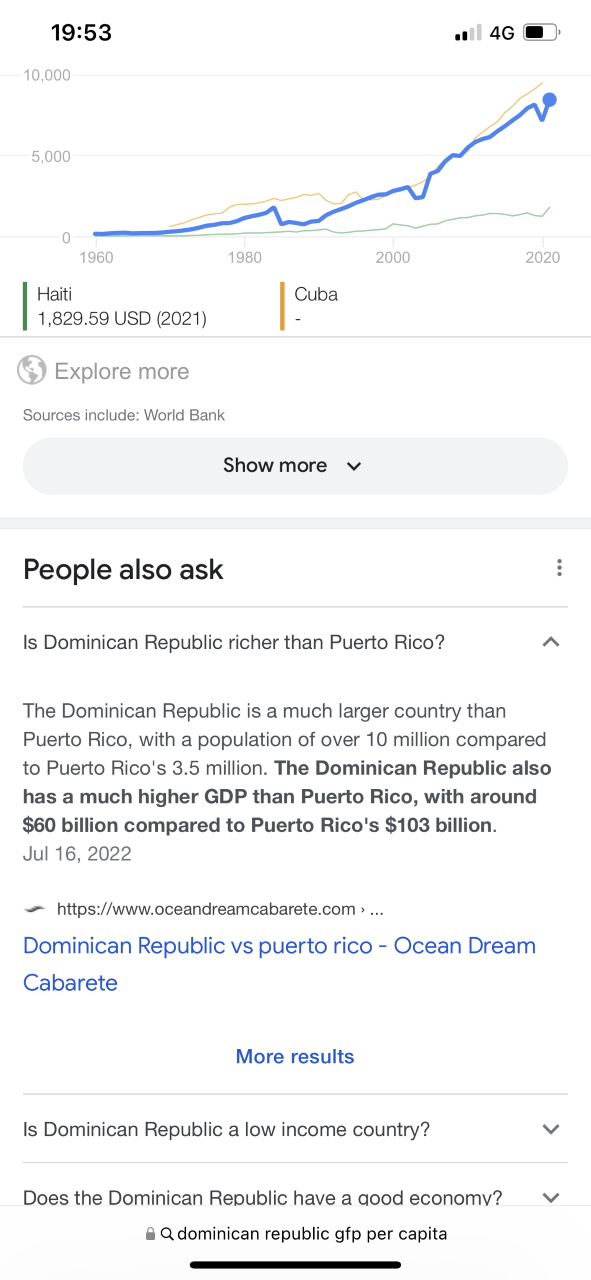
As the economy becomes increasingly digital the AI algorithms have deep implications across the economy. Things like voice rights, knock offs, virtual re-representations, source attribution, and similar are obvious. But how far do we allow algorithms to track a person’s character flaws and exploit them? Horse racing ads that follow a gambling addict around the web, or a girl with anorexia who keeps clicking on weight loss ads.
The thing that makes the AI algorithms particularly dangerous is not just that they are often wrong while appearing high-confidence, it is that they are tied to monopoly platforms which impact so many other layers of the economy. If Google pays Apple billions to be the default search provider on iPhone any error in the AI on a particular topic will hit a whole lot of people on Android & Apple devices until the problem becomes a media issue & gets fixed.
The analogy here would be if Coca Cola had a poison and they also poured Pepsi products.
These cloud platforms also want to help retailers manage in-store inventory:
Google Cloud said Friday its algorithm can recognize and analyze the availability of consumer packaged goods products on shelves from videos and images provided by the retailer’s own ceiling-mounted cameras, camera-equipped self-driving robots or store associates. The tool, which is now in preview, will become broadly available in the coming months, it said. … Walmart Inc. notably ended its effort to use roving robots in store aisles to keep track of its inventory in 2020 because it found different, sometimes simpler solutions that proved just as useful, said people familiar with the situation.
Run a coupon site? A BIG heads-up as “clippable coupon” functionality looks to expand from shopping to the core SERP. See the “Coupons from stores” feature below… https://t.co/w1tcoST1uF— Glenn Gabe (@glenngabe) February 8, 2023
Each AI algorithm has limits & boundaries, with humans controlling where they are set. Injection attacks can help explore some of the boundaries, but they’ll patch until probed again.
My new favorite thing – Bing’s new ChatGPT bot argues with a user, gaslights them about the current year being 2022, says their phone might have a virus, and says “You have not been a good user”
Why? Because the person asked where Avatar 2 is showing nearby pic.twitter.com/X32vopXxQG— Jon Uleis (@MovingToTheSun) February 13, 2023
Boundaries will often be set by changing political winds:
“The tech giant plans to release a series of short videos highlighting the techniques common to many misleading claims. The videos will appear as advertisements on platforms like Facebook, YouTube or TikTok in Germany. A similar campaign in India is also in the works. It’s an approach called prebunking, which involves teaching people how to spot false claims before they encounter them. The strategy is gaining support among researchers and tech companies. … When catalyzed by algorithms, misleading claims can discourage people from getting vaccines, spread authoritarian propaganda, foment distrust in democratic institutions and spur violence.”
“The speed with which they can shuffle somebody into the Hitler of the month club.”
Joe Rogan and @mtaibbi discuss how left wing media created a Elon Musk “bad now” narrative based on nothing. pic.twitter.com/IaHHTHCo1f— Mythinformed MKE (@MythinformedMKE) February 14, 2023
Some things are quickly labeled or debunked. Other things are blown out of proportion to scare and manipulate people:
Dr. Ioannidis et. al. found that across 31 national seroprevalence studies in the pre-vaccine era, the median IFR was 0.0003% at 0-19 years, 0.003% at 20-29 years, 0.011% at 30-39 years, 0.035% at 40-49 years, 0.129% at 50-59 years, and 0.501% at 60-69 years. This comes out to 0.035% for those aged 0-59 and 0.095% for those aged 0-69.
A lot of children had their childhoods destroyed by the idiotic lockdowns. And a lot of those children are now destroying the lives of other children:
In the U.S., homicides committed by juveniles acting alone rose 30% in 2020 from a year earlier, while those committed by multiple juveniles increased 66%. The number of killings committed by children under 14 was the highest in two decades, according to the most recent federal data.
Now we get to pile inflation and job insecurity on top of those headwinds to see more violence.
Some entities will claim their own statements are conspiracy theory, even when directly quoted:
“Last June, the Navy divers, operating under the cover of a widely publicized mid-summer NATO exercise known as BALTOPS 22, planted the remotely triggered explosives that, three months later, destroyed three of the four Nord Stream pipelines, according to a source with direct knowledge of the operational planning. … Over the next several meetings, the participants debated options for an attack. The Navy proposed using a newly commissioned submarine to assault the pipeline directly. The Air Force discussed dropping bombs with delayed fuses that could be set off remotely. The CIA argued that whatever was done, it would have to be covert. Everyone involved understood the stakes. “This is not kiddie stuff,” the source said. If the attack were traceable to the United States, “It’s an act of war.” … “If Russia invades . . . there will be no longer a Nord Stream 2. We will bring an end to it.””
In an age of deep fakes, fast social shares, legal threats, AI algorithms & secret censorship programs who do you trust?
“The fact that protesters could be at once both the victims and perpetrators of misinformation simply shows how pernicious misinformation is in modern society.” – Canadian Justice Paul Rouleau
By 2016, however, the WEF types who’d grown used to skiing at Davos unmolested and cheering on from Manhattan penthouses those thrilling electoral face-offs between one Yale Bonesman and another suddenly had to deal with — political unrest? Occupy Wall Street was one thing. That could have been over with one blast of the hose. But Trump? Brexit? Catalan independence? These were the types of problems you read about in places like Albania or Myanmar. It couldn’t be countenanced in London or New York, not for a moment. Nobody wanted elections with real stakes, yet suddenly the vote was not only consquential again, but “often existentially so,” as American Enterprise Institute fellow Dalibor Rohac sighed. So a new P.R. campaign was born, selling a generation of upper-class kids on the idea of freedom as a stalking-horse for race hatred, ignorance, piles, and every other bad thing a person of means can imagine
AI-Driven Search
I just dusted off the login here to realize I hadn’t posted in about a half-year & figured it was time to write another one. ;)
Yandex Source Code Leak
Some of Yandex’s old source code was leaked, and few cared about the ranking factors shared in t…
New Google Ad Labeling
TechCrunch recently highlighted how Google is changing their ad labeling on mobile devices.
A few big changes include:
- ad label removed from individual ad units
- where the unit-level label was instead becomes a favicon
- a “Sponsored” label above ads
- the URL will show right of the favicon & now the site title will be in a slightly larger font above the URL
An example of the new layout is here: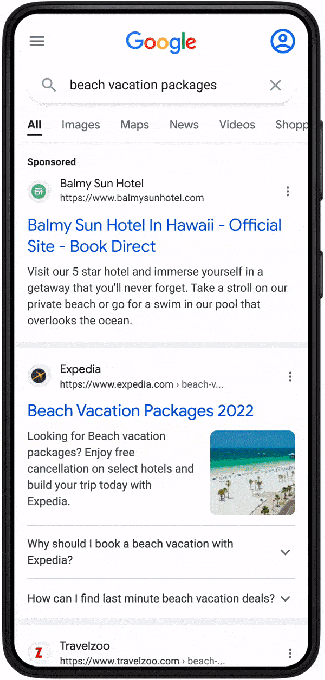
Displaying a site title & the favicon will allow advertisers to get brand exposure, even if they don’t get the click, while the extra emphasis on site name could lead to shifting of ad clicks away from unbranded sites toward branded sites. It may also cause a lift in clicks on precisely matching domains, though that remains to be seen & likely dependes upon many other factors. The favicon and site name in the ads likely impact consumer recall, which can bleed into organic rankings.
After TechCrunch made the above post a Google spokesperson chimed in with an update
Changes to the appearance of Search ads and ads labeling are the result of rigorous user testing across many different dimensions and methodologies, including user understanding and response, advertiser quality and effectiveness, and overall impact of the Search experience. We’ve been conducting these tests for more than a year to ensure that users can identify the source of their Search ads and where they are coming from, and that paid content is clearly labeled and distinguishable from search results as Google Search continues to evolve
The fact it was pre-announced & tested for so long indicates it is both likely to last a while and will in aggregate shift clicks away from the organic result set to the paid ads.
New Google Ad Labeling
TechCrunch recently highlighted how Google is changing their ad labeling on mobile devices.
A few big changes include:
ad label removed from individual ad units
where the unit-level label was instead becomes a favicon
a “Sponsored” label above ads
th…
Google Helpful Content Update
Granular Panda
Reading the tea leaves on the pre-announced Google “helpful content” update rolling out next week & over the next couple weeks in the English language, it sounds like a second and perhaps more granular version of Panda which can take in additional signals, including how unique the page level content is & the language structure on the pages.
Like Panda, the algorithm will update periodically across time & impact websites on a sitewide basis.
Cold Hot Takes
The update hasn’t even rolled out yet, but I have seen some write ups which conclude with telling people to use an on-page SEO tool, tweets where people complained about low end affiliate marketing, and gems like a guide suggesting empathy is important yet it has multiple links on how to do x or y “at scale.”
Trashing affiliates is a great sales angle for enterprise SEO consultants since the successful indy affiliate often knows more about SEO than they do, the successful affiliate would never become their client, and the corporation that is getting their asses handed to them by an affiliate would like to think this person has the key to re-balance the market in their own favor.
My favorite pre-analysis was a person who specialized in ghostwriting books for CEOs Tweeting that SEO has made the web too inauthentic and too corporate. That guy earned a star & a warm spot in my heart.
Profitable Publishing
Of course everything in publishing is trade offs. That is why CEOs hire ghostwriters to write books for them, hire book launch specialists to manipulate the best seller lists, or even write messaging books in the first place. To some Dan Price was a hero advocating for greater equality and human dignity. To others he was a sort of male feminist superhero, with all the Harvey Weinstein that typically entails.
Anyone who has done 100 interviews with journalists see ones that do their job by the book and aim to inform their readers to the best of their abilities (my experiences with the Wall Street Journal & PBS were aligned with this sort of ideal) and then total hatchet jobs where a journalist plants a quote they want & that they said, that they then attributes it to you (e.g. London Times freelance journalist).
There are many dimensions to publishing:
- depth
- purpose
- timing
- audience
- language
- experience
- format
- passion
- uniqueness
- frequency
Blogs to Feeds
For a long time indy blogs punched well above their weight due to the incestuous nature of cross-referencing each other, the speed of publishing when breaking news, and how easy feed readers made it to subscribe to your favorite blogs. Google Reader then ate the feed reader market & shut down. And many bloggers who had unique things to say eventually started to repeat themselves. Or their passions & interests changed. Or their market niche disappeared as markets moved on. Starting over is hard & staying current after the passion fades is difficult. Plus if you were rather successful it is easy to become self absorbed and/or lose the hunger and drive that initially made you successful.
Around the same time blogs started sliding people spent more and more time on various social networks which hyper-optimized the slot machine type dopamine rush people get from refreshing the feed. Social media largely replaced blogs, while legacy media publishers got faster at putting out incomplete news stories to be updated as they gather more news. TikTok is an obvious destination point for that dopamine rush – billions of short pieces of content which can be consumed quickly and shared – where the user engagement metrics for each user are tracked and aggregated across each snippet of media to drive further distribution.
Burnout & Changing Priorities
I know one of the reasons I blog less than I used to is a lot of the things I would write would be repeats. Another big reason was when my wife was pregnant I decided to shut down our membership site so I could take my wife for a decently long walk almost everyday so her health was great when it came time to give birth & ensure I had spare capacity for if anything went wrong with the pregnancy process. As a kid my dad was only around much for a few summers and I wanted to be better than that for my kid.
The other reason I cut back on blogging is at some point search went from a endless blue water market to a zero sum game to a negative sum game (as ad clicks displaced organic clicks). And in such an environment if you have a sustainable competitive advantage it is best to lean into it yourself as hard as you can rather than sharing it with others. Like when we had an office here our link builders I trained were getting awesome unpaid links from high-trust sources for what backed out to about $25 of labor time (and no more than double that after factoring in office equipment, rent, etc.).
If I share that script / process on the blog publicly I would move the economics against myself. At the end of the day business is margins, strategy, market, and efficiency. Any market worth being in is going to have competition, so you need to have some efficiency or strategic differentiators if you are going to have sustainable profit margins. I’ve paid others many multiples of that for link building for many years back when links were the primary thing driving rankings.
I don’t know the business model where sharing the above script earns more than it costs. Does one launch a Substack priced at like $500 or $1,000 a month where they offer a detailed guide a month? How many people adopt the script before the response rates fall & it offsets the costs by more than the revenues? My issue with consulting is I always wanted to over-deliver for clients & always ended up selling myself short when compared to publishing, so I just stick with a few great clients and a bit of this and that vs going too deep & scaling up there. Plus I had friends who went big and then some of their clients who were acquired had the acquirer brag about the SEO, that lead to a penalty, then the acquirer of the client threw the SEO under the bus and had their business torched.
When you have a kid seeing them learn and seeing wonderment in their eyes is as good as life gets, but if you undermine your profit margins you’d also be directly undermining your own child’s future … often to help people who may not even like you anyhow. That is ultimately self defeating as it gets, particularly as politics grow more polarized & many begin to view retribution as a core function of government.
I believe there are no limits to the retributive and malicious use of taxation as a political weapon. I believe there are no limits to the retributive and malicious use of spending as a political reward.
Margins
The role of search engines is to suck as much of the margins as they can out of publishing while trying to put some baseline floor on content quality so that people would still prefer to use a search engine rather than some other reference resource. Google sees memes like “add Reddit to the end of your search for real content” as an attack on their own brand. Google needs periodic large shake ups to reaffirm their importance, maintain narrative control around innovation, and to shake out players with excessive profit margins who were too well aligned with the current local maxima. Google needs aggressive SEO efforts with large profits to have an “or else” career risk to them to help reign in such efforts.
Brand counts for a lot in search & so does buying the default placement position – look at how much Google pays Apple to not compete in search, or look at how Google had that illegal ad auction bid rigging gentleman’s agreement with Facebook to not compete with a header bidding solution so Google could maintain their outsized profit margins on ad serving on third party websites.
Business ultimately is competition. Does Google serve your ads? What are the prices charged to players on each side of each auction & how much rake can the auctioneer capture for themselves?
The Auctioneer’s Shill Bid – Google Halverez (beta)
That is why we see Google embedding more features directly in their search results where they force rank their vertical listings above the organic listings. Their vertical ads are almost always placed above organics & below the text AdWords ads. Such vertical results could be thought of as a category-based shill bid to try to drive attention back upward, or move traffic into a parallel page where there is another chance to show more ads.
This post stated:
Google runs its search engine partly on its internally developed Cloud TPU chips. The chips, which the company also makes available to other organizations through its cloud platform, are specifically optimized for artificial intelligence workloads. Google’s newest Cloud TPU can provide up to 275 teraflops of performance, which is equivalent to 275 trillion computing operations per second.
Now that computing power can be run across:
- millions of books Google has indexed
- particular publishers Google considers “above board” like Reuters, AP, the New York Times, the Wall Street Journal, etc.
- historically archived content from trusted publishers before “optimizing for search” was actually a thing
… and model language usage versus modeling the language usage of publishers known to have weak engagement / satisfaction metrics.
Low end outsourced content & almost good enough AI content will likely tank. Similarly textually unique content which says nothing original or is just slapped together will likely get downranked as well.
Expect Volatility
They would not have pre-announced the update & gave some people some embargoed exclusives unless there was going to be a lot of volatility. As typical with the bigger updates, they will almost certainly roll out multiple other updates sandwiched together to help obfuscate what signals they are using & misdirect people reading too much in the winners and losers lists.
Here are some questions Google asked:
- Do you have an existing or intended audience for your business or site that would find the content useful if they came directly to you?
- Does your content clearly demonstrate first-hand expertise and a depth of knowledge (for example, expertise that comes from having actually used a product or service, or visiting a place)?
- Does your site have a primary purpose or focus?
- After reading your content, will someone leave feeling they’ve learned enough about a topic to help achieve their goal?
- Will someone reading your content leave feeling like they’ve had a satisfying experience?
- Are you keeping in mind our guidance for core updates and for product reviews?
As a person who has … erm … put a thumb on the scale for a couple decades now, one can feel the algorithmic signals approximated by the above questions.
To the above questions they added:
- Is the content primarily to attract people from search engines, rather than made for humans?
- Are you producing lots of content on different topics in hopes that some of it might perform well in search results?
- Are you using extensive automation to produce content on many topics?
- Are you mainly summarizing what others have to say without adding much value?
- Are you writing about things simply because they seem trending and not because you’d write about them otherwise for your existing audience?
- Does your content leave readers feeling like they need to search again to get better information from other sources?
- Are you writing to a particular word count because you’ve heard or read that Google has a preferred word count? (No, we don’t).
- Did you decide to enter some niche topic area without any real expertise, but instead mainly because you thought you’d get search traffic?
- Does your content promise to answer a question that actually has no answer, such as suggesting there’s a release date for a product, movie, or TV show when one isn’t confirmed?
Some of those indicate < ahref=”https://www.theguardian.com/technology/2022/aug/17/google-wins-defamation-battle-as-australias-high-court-finds-tech-giant-not-a-publisher”>where Google believes the boundaries of their own role as a publisher are & that you should stay out of their lane. :D
Barrier to Entry vs Personality
One of the interesting things about the broader scope of algorithm shifts is each thing that makes the algorithms more complex, increases barrier to entry, and increases cost ultimately increases the chunk size of competition. And when that is done what is happening is the microparasite is being preference over the microparasite. Conceptually Google has a lot of reasons to have that bias or preference:
- fewer entities to police (lower cost)
- more data to use to police each entity (higher confidence)
- easier to do direct deals with players which can move the needle (more scale)
- if markets get too consolidated Google can always launch a vertical service & tip the scale back in the other direction (I see your Amazon ad revenue and I raise you free product listing ads)
- the macroparasites have more “sameness” between them (making it easier for Google to create a competitive clone or copy)
So long as Google maintains a monopoly on web search the bias toward macroparasites works for them, as people can not see what they do not see & do not know what does not exist, or what exists but is hidden to them.
I think when people complain about the web being inauthentic what they are really complaining about is the algorithmic choices & publishing shifts that did away with the indy blogs and replaced with with the dopamine feed viral tricks and the same big box scaled players which operate multiple parallel sites to where you are getting the same machinery and content production house behind multiple consecutive listings. They are complaining about the efforts to snuff out the microparasite also scrubbing away personality, joy, love, quirkiness, weirdness, and the stuff you would not typically find on content by factory order websites.
Leading you down well worn paths, rather than the magic of serendipity & a personality worn on your sleeve that turns some people on while turning other people off.
Text which is roughly aligned with a backward looking consensus rather than at the forefront of a field.
If you believe this effort will enhance info literacy, and that it represents evolved search, you’re an idiot.
Sharyl Attkisson gave us the head’s up that they’d push censorship controls as “media literacy” several years ago.— john andrews (@johnandrews) August 13, 2022
Text which is perhaps factually correct, and maybe even current and informed, but done in such a way where you do not feel you know the author the way you might think you do if you read a great novel. Or hard biased content which purports to support some view and narrative, but is ultimately all just an act, where everything which could be of substance is ultimately subsumed by sales & marketing.
“The best relevancy algorithm in the world is trumped by preferential placement of inferior results which bypasses the algorithm.”
I was a fool to dismiss Aaron for years as a cynic. He was an oracle, not a conspiracy theorist: https://t.co/V68vIXXNPI— Rand Fishkin (@randfish) November 20, 2019
The Market for Something to Believe In is Infinite
Each re-representation mash-up of content in the search results decontextualizes the in-depth experience & passion we crave. Each same “big box” content factory where a backed entity can withstand algorithmic volatility & buy up other publishers to carry learnings across creates more of a bland sameness.
That barrier to entry & bland sameness is likely part of the reason the recent growth of Substack, which sort of acts just like a blog did 15 or 20 years ago – you go direct to the source without all the layers of intermediaries & dumbing down you get as a side effect of the scaled & polished publishing process.
Google Helpful Content Update
Granular Panda
Reading the tea leaves on the pre-announced Google “helpful content” update rolling out next week & over the next couple weeks in the English language, it sounds like a second and perhaps more granular version of Panda which can take…
Automating Ourselves Out of Existence
Time has grown more scarce after having a child, so I rarely blog anymore. Though I thought it probably made sense to make at least a quarterly(ish) post so people know I still exist.
One of the big things I have been noticing over the past year or so…
Automating Ourselves Out of Existence
Time has grown more scarce after having a child, so I rarely blog anymore. Though I thought it probably made sense to make at least a quarterly(ish) post so people know I still exist.
One of the big things I have been noticing over the past year or so…
Engineering Search Outcomes
Kent Walker promotes public policies which advantage the Google monopoly.
His role doing that means he has to write some really bad hot takes that lack context or intentionally & dishonestly redirect attention away from core issues – that’s his jo…
Engineering Search Outcomes
Kent Walker promotes public policies which advantage the Google monopoly.
His role doing that means he has to write some really bad hot takes that lack context or intentionally & dishonestly redirect attention away from core issues – that’s his job.
With that in mind, his most recent blog post defending the Google monopoly was exceptional.
Force Ranking of Inferior Search Results
“When you have an urgent question — like “stroke symptoms” — Google Search could be barred from giving you immediate and clear information, and instead be required to direct you to a mix of low quality results.”
On some search queries users get a wall of Google ads, the forced ranked Google insert (or sometimes multiple of them with local & ecommerce) and then there can even be a “people also ask” box above the first organic result.
The idea that organic results must be low quality if not owned & operated indicates 1 of the following 3 must be true:
- they should not be in search
- their content scraping & various revenue shifting scams with their ad tech stack demonetized legit publishers
- their forced rank of their own content is stripping them of the signals needed to rank websites & pages
Whenever Google puts a “people also ask” box above the first organic result that is them saying they did not know what to rank, or they are just trying to create a visual block to push the organic result set down the page and user attention back up toward the ads.
The solution to Google’s claims is easy to solve. Either of the following would work.
- Have an API that allows user choice (to set rich snippet or vertical defaults in various categories), or
- If the vertical inserts remain Google-only then for Google to justify force ranking their own results above the organic result set Google should also be required to rank those same results above all of their ads, so that Google is demonetizing Google along with the rest of the ecosystem, rather than just demonetizing third parties.
If the thesis that this information needs to be front and center & that is a matter of life or death, then asking searchers to first scroll past a page or two of ads is not particularly legitimate.
Spam & Security
“when you use Google Search or Google Play, we might have to give equal prominence to a raft of spammy and low-quality services.”
Many of the worst versions of spam that have repeatedly made news headlines like fake tech support, fake government document providers, and fake locksmiths were buying distribution through Google Ads or were featured in the search results through Google force ranking their own local search offering even though they knew the results were vastly inferior to Yelp.
If Google did not force rank Google local results above the rest of the organic result set then the fake locksmiths would not have ranked.
I have lost count of how many articles I have read about hundreds or thousands of fake apps in the Google Play store which existed to defraud advertisers or commit identity theft, but there have been literally thousands of such articles. I see a similar headline at least once a month without eve looking for them. Here is one this week for scammers monetizing the popularity of Wordle with fake apps.
Making matters worse, some of the tech support scams showed the URL of a real business and rerouted the call through a Google number directly to a scammer. A searcher who trusted Google & sees Apple.com or Dell.com on Google Ads in the search results then got connected with a scammer who would commit identity theft or encrypt their computer then demand ransom cryptocurrency payments to decrypt it.
After making the ads harder to run for scammers Google decided the problem was too hard & expensive to sort out so they also blocked legitimate computer repair shops.
Sometimes Google considers something spam strictly due to financial considerations.
Their old remote rater documents stated *HELPFUL* hotel affiliate websites should be labeled as spam.

Years later the big OTAs are complaining about Google eating their lunch as well as Google is twice as big as the next player.
At one point Google got busted for helping an advertiser route around the automated safety features built into their ad network so that they could pay Google to run ads promoting illegal steroids.
With cartels, you can only buy illegal goods and services from the cartel if you don’t want to suffer ill consequences. The same appears to be true here.
The China Problem
“Handicapping America’s technology leaders would threaten our leading sources of research and development spending — just as bipartisan voices in Congress are recognizing the need to increase American R&D investment to stay competitive in the global race for AI, quantum, and other advanced technologies.”
We are patriotic, and, but China… is a favorite misdirection of a tech monopolist.
The problem with that is while Eric Schmidt warns it is a national emergency if China overtakes the US in AI tech, Google also operates an AI tech lab in China.
In other words, Eric Schmidt is trying to warn you about himself and his business interests at Google.
Duplicitous? Absolutely.
Patriotic? Less than Chamath!
Who the fuck did this? pic.twitter.com/BD4NKpila6— Girolamo Carlo Casio (Free Twatter) (@INArteCarloDoss) January 19, 2022
Inflation
“the online services targeted by these bills have reduced prices; these bills say nothing about sectors where prices have actually been rising and contributing to inflation.”
Technology is no doubt deflationary (moving bits on an optical line is cheaper than printing out a book and shipping it across the world) BUT some dominant channels have increased the cost of distribution by increasing the chunk size of information and withholding performance information.
Before Google Analytics was “free” there was a rich and vibrant set of competition in web analytics software with lots of innovation from players like ClickTracks.
Most competing solutions went away.
Google moved away from an installed licensing model to a hosted service where they can change the price upon contract renewal.
Search hid progressively more performance information over time, only sampled data from larger data sets, & now you can sign up for Google Analytics 360 starting at only $150,000 per year.
The hidden search performance data also has many layers to that onion. Not only does Google not show keyword referrers on organic search, but they often don’t show your paid search keywords either, and they keep extending out keyword targeting broader than advertisers intend.
Yesterday’s announcement on match type changes had me crawling through query data this morning. I’m staring at many 2-3 word exact match keywords that are matching to 8-word queries. G thinks ‘deck paint’ and ‘how do i put paint on my deck’ mean the exact same thing. CPA is 10x.— Brad Geddes (@bgtheory) February 5, 2021
Google used to pay Brad Geddes to run official Google AdWords ad training seminars for advertisers, so the idea that *he* has to express his frustrations on Twitter is an indication of how little effort Google is putting into having open communications channels or caring about what their advertisers think.
This is in accordance with the Google customer service philosophy:
he told her that the whole idea of customer support was ridiculous. Rather than assuming the unscalable task of answering users one by one, Page said, Google should enable users to answer one another’s questions.
Those who were paying for ads get the above “serve yourself” treatment, all the while Google regularly resets user default ad settings to extend out ad distribution, automatically ad keywords, shift to enhanced AdWords ad campaigns, etc.
Then there are other features which would be beneficial and offered in a competitive market that have been deprioritized. Many years ago eBay did a study which showed their branded Google AdWords ad buys were cannibalistic to eBay profits. Google maintained most advertisers could not conduct such a study because it would be too expensive and Google does not make the feature set available as part of their ad suite.
Missing Information
“When you search for local businesses, Google Search and Maps may be prohibited from highlighting information we gather about hours of operation, contact information, and reviews. That could hurt small businesses and local retailers, as well as their customers.”
Claiming reviews or an attempt to offer a comprehensive set of accurate review data as a strong point would be economical with the truth.
Back when I had a local business page my only review was from a locksmith spammer / scammer who praised his own two businesses, trashed a dozen other local locksmiths, crapped on a couple local SEO services, and joked about how a local mover smashed the guts out of his dog. Scammer fake reviewer’s name was rather sophisticated … it was … Loop Dee Loop

About a decade back when Google was clearly losing Google took Yelp reviews wholesale (sometimes without even attributing them to Yelp!) and told Yelp that if they did not want Google stealing their work and displacing them with a copy of it then they should block GoogleBot. Google offered the same sort of advice / threat to TripAdvisor.
A few years before that Google temporarily “forgot” to show phone numbers on local listings.
After Yelp turned down an acquisition offer by Google & Yelp did a great job making some people aware of how Google was stealing their reviews wholesale without attribution Google bought Zagat & Fromer’s to augment the Google local review data and then sold those businesses off.
This is sort of the same playbook Google has run in the past elsewhere. After Groupon said no to Google’s acquisition offer, Google quickly provided daily deal ads to over a dozen Groupon competitors to help commoditize the Groupon offering and market position.
Ultimately with the above sort of stuff Google is primarily a volume aggregator or has lower editorial costs than pure plays due to the ability to force bundle their own distribution. And they use the ability to rank themselves above a neutral algorithmic position as a core part of their biz dev strategy. When shopping search engines were popular Google kept rewording the question set they sent remote raters to justify rank demotion for shopping search engines & Google also came up with innovative ranking “signals” like concurrent ranking of their own vertical search offering whenever competitors x or y are shown in the result set & rolled out a “diversity” algorithm to limit how many comparison shopping sites could appear in the search results. The intent of the change was strictly anti-competitive:
“Although Google originally sought to demote all comparison shopping websites, after Google raters provided negative feedback to such a widespread demotion, Google implemented the current iteration of its so-called ‘diversity’ algorithm.”
As a matter of fact, part of one of many document dumps in recent years went further than the old concurrent ranking signal to a rank x above y feature which highlights how YouTube can be hard coded at a number 1 ranking position.
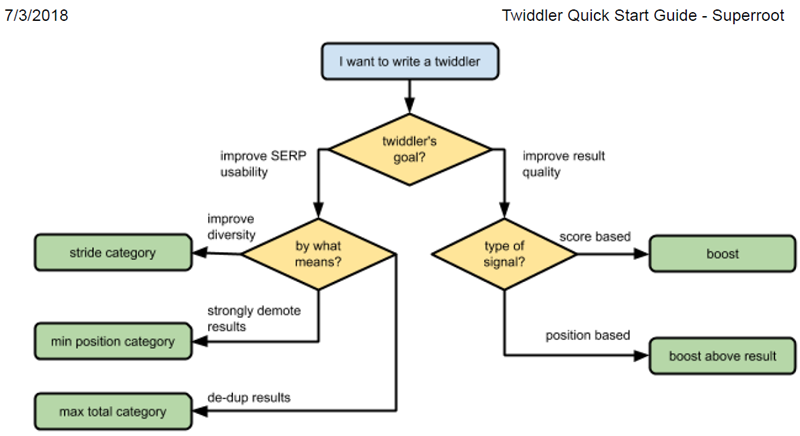
Part of that guide highlighted how to hardcode ranking YouTube #1.
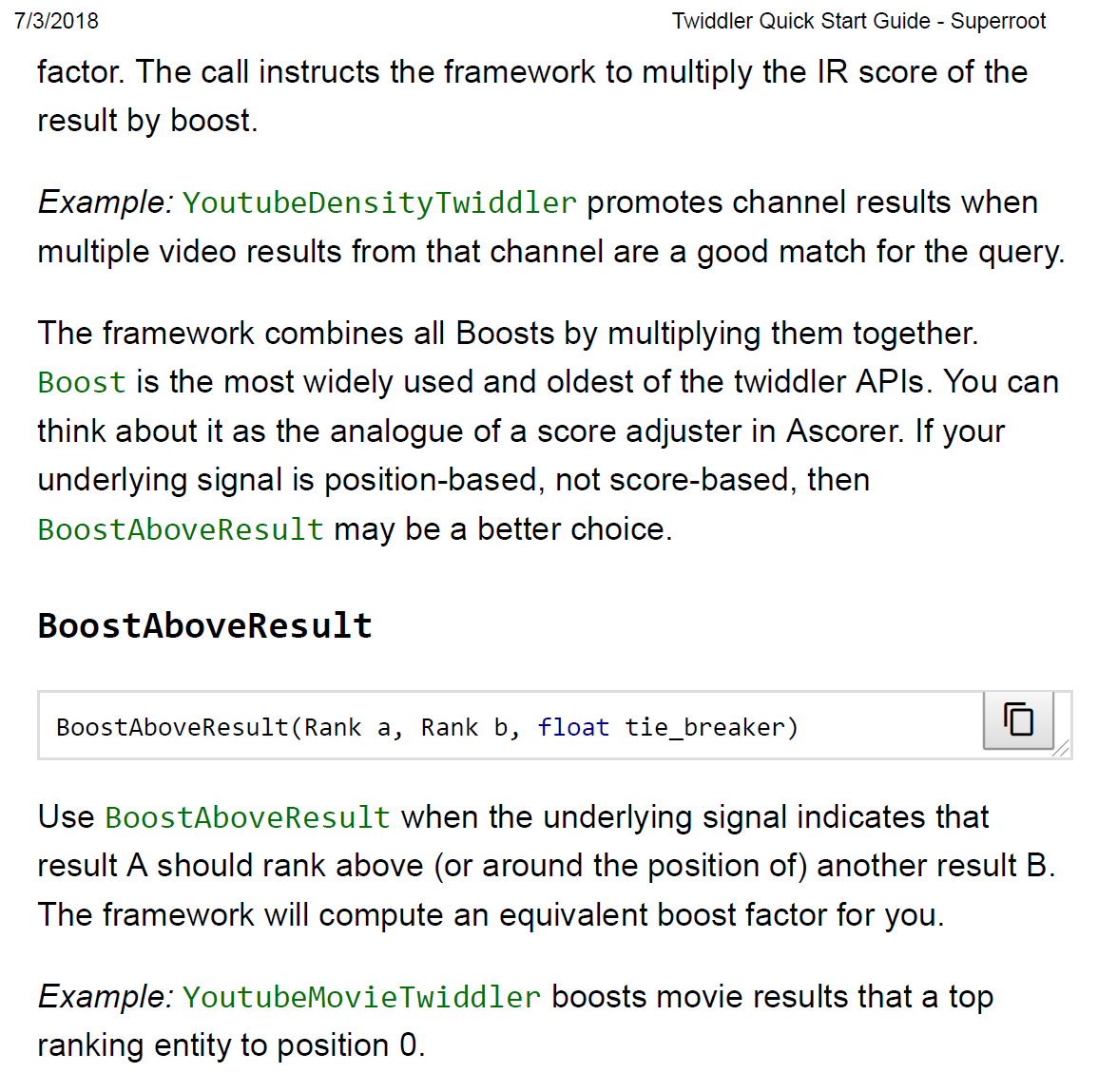
If you re-represent content & can force rank yourself #1 (with larger listings) that can be used to force other players onto your platform on your terms. Back when YouTube was must less of a sure thing Google suggested they could threaten to change copyright.
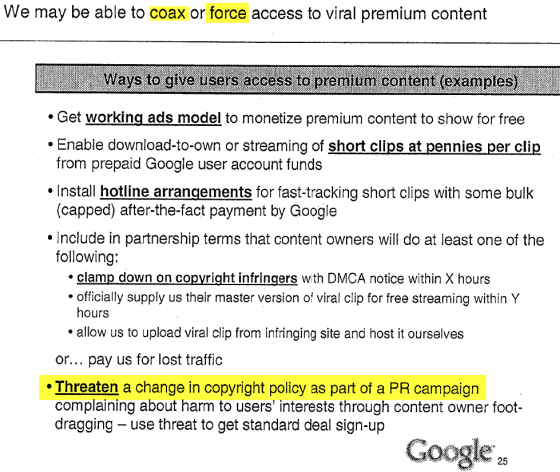
This same approach to “relevancy” is everywhere.
Did you watermark your images? Well shame on you, as that is good for a rank demotion
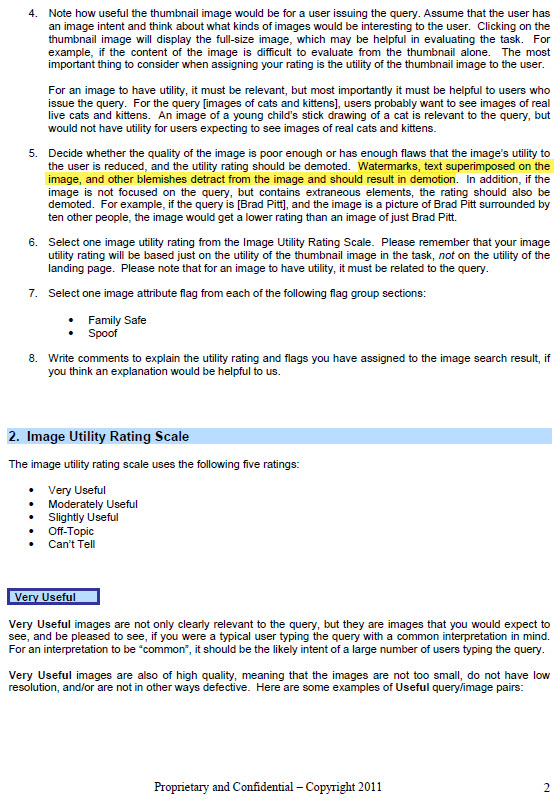
And if there are photos which are deemed illegal Google will make you file an endless series of DMCA removal requests even though they already had the image fingerprinted.
Now there are some issues where there is missing information. These areas involve original reporting on local politics & are called news deserts. As the ad pie has consolidated around Google & Facebook that has left many newspapers high and dry.
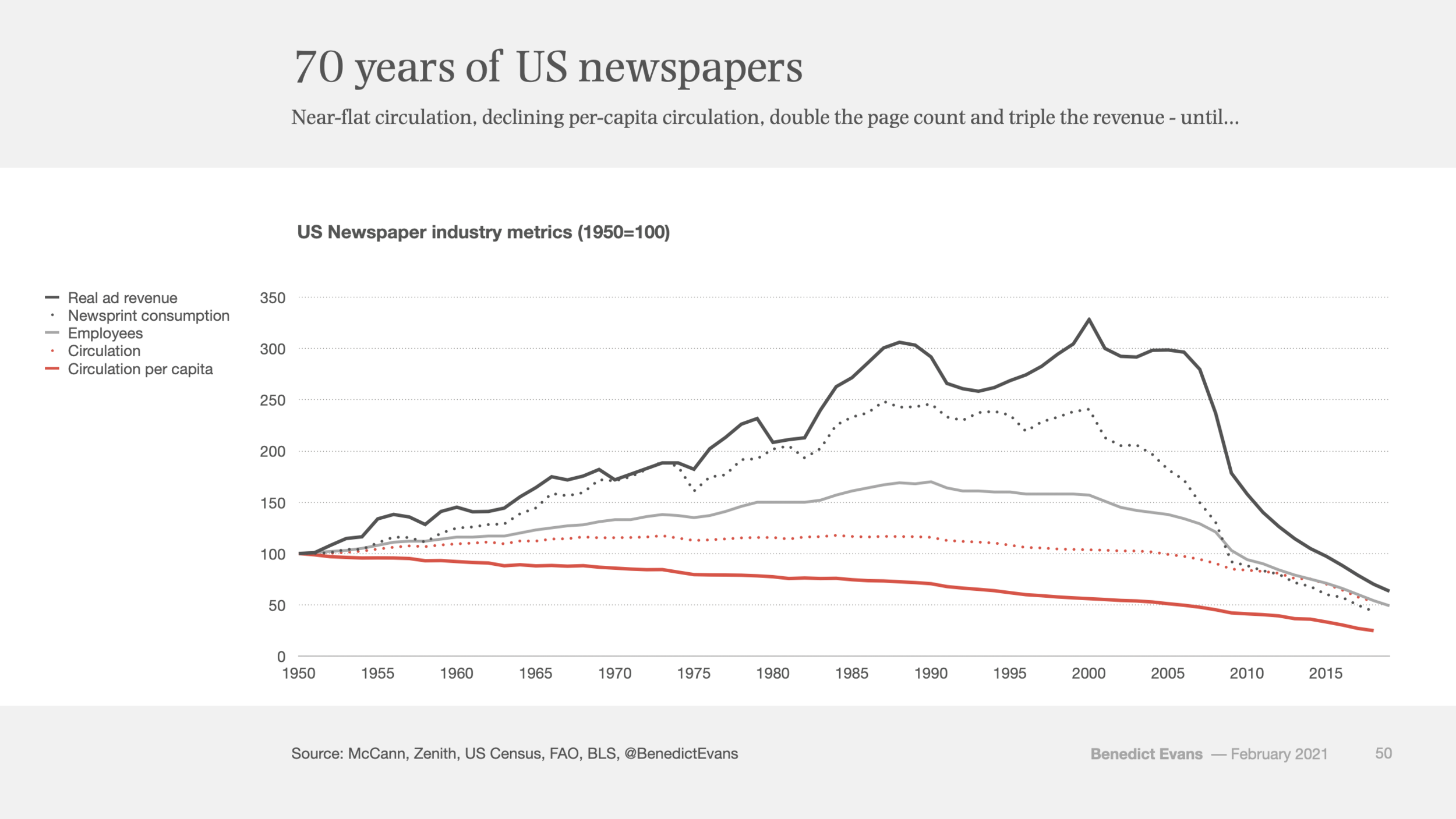
Private equity players like Alden Global Capital buy up newspapers, fire journalists, and monetize brand equity as they drive the papers into the ground.
If you are sub-scale maybe Google steals your money or hits you with a false positive algorithm flag that has you seeking professional mental health help.
Big players get a slower blood letting.
Google has maintained they do not make any money from news search, but the states lawsuit around ad tech made it clear Google promoted AMP for anti-competitive purposes to block header bidding, lied to news publishers to get them to adopt AMP and eat the tech costs of implementation, did a deal with their biggest competitor in online advertising Facebook to maintain the status quo, charge over double what their competitors do for ad tech, and had a variety of bid rigging auction manipulation algorithms they used to keep funneling more money to themselves.
Internally they had an OKR to make *most* search clicks land on AMP pages within a year of launch
“AMP launched as an open source project in October 2015, with 26 publishers and over 40 publications already publishing AMP files for our preview demo. Our team built g.co/ampdemo and is now racing towards launching it for all of our users. We’re responsible for the AMP @ Google integrations, particularly focusing on Search, our most visible product. We have a Google-wide 2016 OKR to deliver! By the end of 2016, our goal is that 50%+ of content consumed through Search is being consumed through AMP.”
You don’t get over half the web to shift to a proprietary version of HTML in under a year without a lot of manipulation.
So, when Google tells buyers an ad sold for one price and they tell sellers it sold for a lower price, isn’t that just plain old fraud? I mean, on top of the anti-competitive tying and all that, fraud is illegal, isn’t it?— Jerry Neumann (@ganeumann) January 14, 2022
Conversion.ai Review
Background / Intro
One of my longtime friends who was Internet marketing long before I was hit me up on Skype about a week ago praising Conversion.ai. I have to think long and hard about any other time he has really pitched or recommended something like that & really I just can’t think of any other time where he did that. The following day my wife Giovanna mentioned something to me and I was like “oh you should check out this thing my buddy recommended yesterday” and then I looked and realized they were both talking about the same thing. :D
I have a general heuristic that if people I trust recommend things I put them near the top of the “to do” list and if multiple people I trust do that I pull out the credit card and run at it.
Unfortunately I have been a bit burned out recently and launched a new site which I have put a few hundred hours into, so I haven’t had the time to do too much testing, BUT I have a writer who works for me who has a master’s degree in writing, and figured she could do a solid review.
She is maybe even a bit more cynical than I am (is that even possible?) and a certified cat lady who loves writing, reading, poetry and is more into a soft sell versus aggressive sales.
Full disclosure…the above link and the one at the end of this post are affiliate links, but they had zero impact on the shape or format of the review. The reviewer was completely disconnected from the affiliate program and I pulled out my credit card to pay for the software for her to test it out.
With that tiny bit of a micro-introduction, the rest of the post from here on out is hers. I may have made a couple minor edits for clarity (and probably introduced a few errors she will choke me for. :D) but otherwise the rest of this post is all her …
An In-depth Review of the Conversion.ai Writing Software
Considering the possibilities of artificial intelligence (AI), we picture robots doing tasks autonomously like humans. With a computer’s brain power, productivity is accelerated significantly. We also expect AI programs to have the capability to evolve intelligently the longer they are used. These types of AI employ “machine learning,” or deep learning to solve problems.
AI technology can be leveraged by various industries, especially with writing. Recently, I learned about the Conversion.ai copywriting tool. It uses machine learning which claims to write “high converting copy” for websites, ads, landing pages, emails, etc. The software is geared towards writers, marketers, entrepreneurs, and agencies that benefit from creating engaging and effective copy. To date, companies such as Hubspot, Shopify, and Salesforce are known to use the software. Currently, it’s offering a 7-day free trial with 20,000-word credits.
To give you the lowdown on Conversion.ai, I wrote an in-depth review of how this software works. I’ll go through its various features and show examples of how I used them. I’ll include the advantages of using Conversion.ai’s Jarvis (that’s what it’s called) in writing scenarios. More importantly, I’ll discuss challenges and specific limitations this tool might present.
Assistance in Creating High Conversion Copy
As a writer doing web copy for 10 years, including the time I took a post-grad creative writing degree, I grabbed the opportunity to try this AI software. For starters, it struck me how Conversion.ai claims to provide “high converting copy” for increased conversion and higher ROI. Such claims are a tall order. If you’ve been in the marketing or sales industry, you’d know conversion depends on so many other factors, such as the quality of the actual product, customer support, price, etc. It’s not just how well copy is written, though it’s a vital part. But anyway, upon more research, I learned the app generates copy based on proven high conversion sales and marketing messages.
To be honest, I have mixed feelings about this conversion strategy. I believe it’s a double-edged sword. This is not to undermine facts or measurable data. Basing content creation on “proven content” means you’re likely using the same phrases, techniques, and styles already used by successful competitors. This serves as a jumping board for ideas of course, so you know what’s already there. However, it can be an echo chamber. Marketers must not forget that execution must still be fresh. Otherwise, you’ll sound like everyone else.
Next, while it seems sustainable, it also sounds pretty safe. If your product or service is not that distinct, you must put extra effort to create content that stands out. This applies to all aspects of the marketing strategy, not just in writing content. It’s a crucial principal I learned after reading Purple Cow by Seth Godin (thanks for the book suggestion, Aaron!).
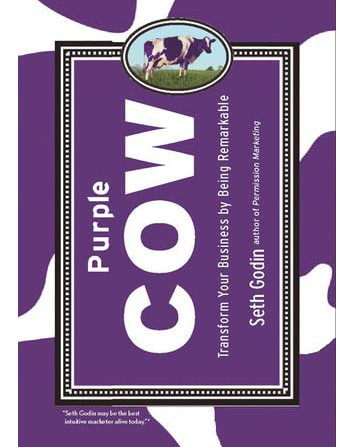
Depending on your product or service, Conversion.ai will generate copy that most consumers keep going back to. Based on the samples it generated, I’d say it really does come up with engaging copy, though it needs editing. If your business must rewrite product descriptions for extensive inventories, Conversion.ai can cut the time in half. It can help automate description rewriting without hiring more writers. That saves money and time, so businesses need fewer writers and editors.
What did I learn? Conversion.ai can make writing and editing faster, yes, especially for low-level content focused on descriptions. It can also inform the strength of your ideas for more creative campaigns. However, it still takes solid direction and creativity to drive good marketing copy forward. That said, it’s only as good as the writer utilizing this app. As a content creator, you cannot rely on it solely for creativity. But as an enhancer, it will significantly help push ideas forward, organize campaigns, and structure engaging copy effectively.
When you use this app, it offers many different features that help create and organize content. It also customizes copy for various media platforms. Beyond rewriting , it even has special brainstorming tools designed to help writers consider various idea angles. This can add more flavor and uniqueness into a campaign.
At the end of the day, what will set your copy apart is the strength of your ideas and your communication strategy. How you customize content for a business is still entirely up to you. AI writing tools like Conversion.ai can only help enhance your content and the ideas behind it. It’s a far cry from creating truly unique concepts for your campaign, but it definitely helps.
Conversion.ai Writing Features & How They Work
This AI writing app comes with plenty of “writing templates” that are customized to help you write with a specific framework or media platform in mind. Currently, Conversion.ai offers 39 different writing templates or content building blocks that deliver results. We’ll provide details for how each one works.
For company or product descriptions, Conversion.ai has a Start Here step by step guide, which says users should alternate between the Product Description and the Content Improver template until they have found the right mix they’re looking for. But for this review, I just focused on how to use the templates for different writing projects. The app comes with video instructions as well as a live training call if you need further assistance on how to use it.
Each template asks you to input a description or what you want to write about. This is limited to 600 characters. Writing the description is the sole basis for how Jarvis will generate ways to write or expand your content. It also helps you brainstorm and structure ideas for an article or campaign.
But as an issue, I find the 600-character limit can hinder reposting the full content generated by the AI back into the template for improvement. Yes, it churns out marketing copy of more than 600 characters. If you want to post the improved copy again, you might have to do this in two batches. In any case, Jarvis can generate as many improved writing samples as you need.
To give you a better idea, here are different Conversion.ai templates and how they work. This is going to take a while, so have your coffee ready.
Long-form Assistant
This is for longer articles, emails, scripts, and stories. It’s also suggested for writing books. It has two modes, a blank document where you can start typing freely and an assistant workflow. The blank document also lets you access the rest of the other writing templates vertically. On the other hand, the long-form assistant workflow is where the app asks you to describe the content you want to create. Consider this carefully. The better you can articulate your topic, the higher quality content Jarvis can help generate.
For the example, suppose I want to write about what it took to finally release Zack Synder’s 2021 Justice League. I want to write this feature article for my film and culture website.
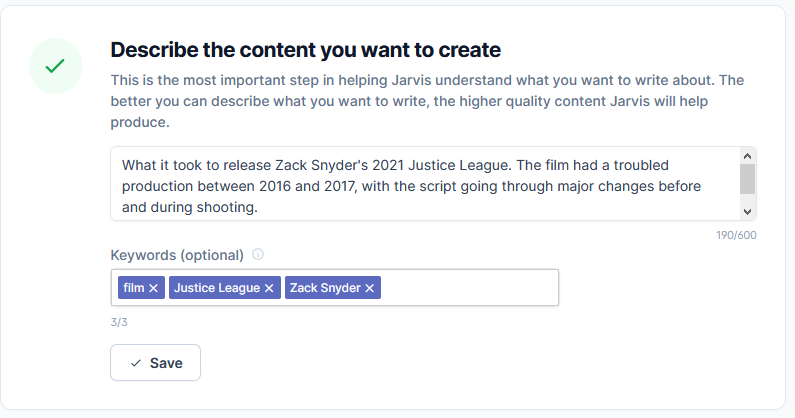
Jarvis asks for a maximum of three keywords. It’s optional, but I presume adding keywords will help Jarvis generate more relevant content. Next, it prompts you to write a working title and start an introductory paragraph. Once you write your initial title, it will generate other title ideas.
For the title, I wrote: The Challenges of Releasing Zach Snyder’s Justice League 2021
It generated the following suggestions:
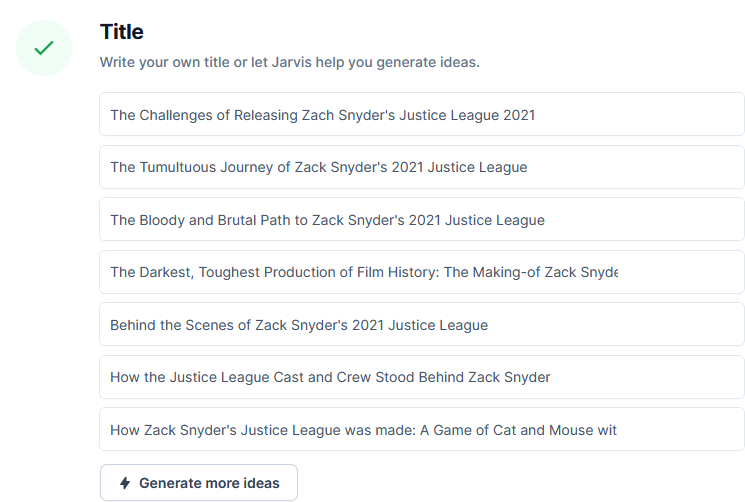
Jarvis generated a long list of appropriate and catchy titles. I personally liked “The Tumultuous Journey of Zack Snyder’s Justice League 2021,” though I’d shorten it a bit. I also liked “The Darkest, Toughest Production in Film History,” which basically tells audiences how hard it was to produce the version of the film. Though it’s an exaggeration, it can be qualified in the article. The other suggestions with “Behind the Scenes” and “Towards a Better Script” were more specific angles. I like that I could explore those topics too. Generally, I think it’s definitely a great tool to make title writing faster.
So far, so good, right? But when I got to content suggestions, it got a bit messy. It was mainly because the suggested content was too general. It also tended toward suggesting expansions that were incoherent to the main topic. This did not sound very promising. Moreover, the AI added bits of information such as dates and other related information. I had to check if these details were used accurately. In a previous test I did (and even for this example), it completely got a date wrong. So I advise writers to always double check the details suggested by Jarvis.
Take a look below. The top paragraph was the one I wrote, while the ones below are suggested by Jarvis.
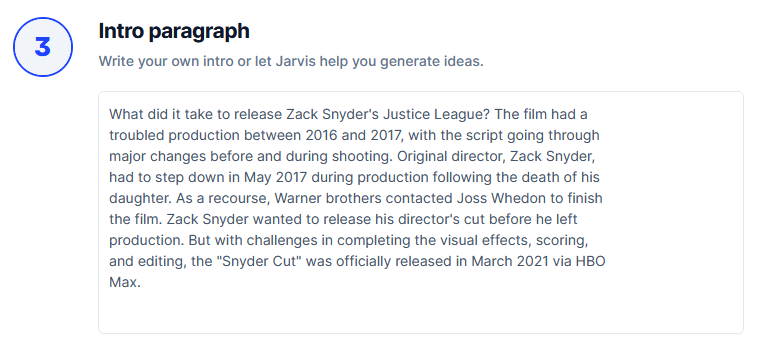
Content suggestions from Jarvis:
1) You might not be able to see Zack Snyder’s Justice League on the big screen, but you can catch it online in 2021. It was released digitally by Warner Bros. on November 27th 2020 and we’ve been watching it slowly climb the ranks of IMDB since then. The film had a troubled production between 2016 and 2017 with the script going through major changes before and during shooting. But now that all is said and done, what did people think? Let’s find out!
2) Justice League is a film that was released on November 17, 2017. The movie had been preceded by Batman v Superman: Dawn of Justice and Wonder Woman. It’s also the fifth installment in the DC Extended Universe (DCEU). Despite being generally well-received by critics, it was considered to be a disappointment at the box office. In this blog post, we’ll take you behind the scenes and show you what went wrong with Zack Snyder’s 2021 Justice League film production!
3) Director Zack Snyder’s Justice League film was one of the most anticipated films of 2017. Unfortunately, the film had a troubled production and was not released until 2021. That didn’t stop it from becoming one of the highest-grossing films of all time. What does this have to do with SEO? When you release content on your website, be sure to include keywords that are relevant to your business and industry!
At first glance, the introduction actually looks appealing to Justice League fans. Many people have been anticipating it on the big screen. But upon further reading, compared to the paragraph I wrote, the AI content had so many problems. Besides being too general, it had issues with imprecise details. Though you can argue these problems are small and editable, it adds time to your work. It can even derail you from focusing on your topic.
The first AI suggestion wrote that Snyder Cut was released digitally by Warner Bros. in November 27, 2020. Upon further research, I found no such confirmation of this. However, there was a YouTube video “speculating” it’s release in November 2020. But from the looks of it, this did not pan out. Officially, Zack Snyder’s Justice League was released in March 18, 2021 by HBO Max via streaming platform, according to Rotten Tomatoes. And yes, it has been climbing the ranks since its digital release.
If you’re not careful about fact-checking, you might end up with misleading information. And frankly, I feel as if some of the other suggestions may tend towards fluff. However, what you can do is choose the best suggestions and put them together into one coherent paragraph. The first suggestion ended the introduction with “But now that all is said and done, what did people think? Let’s find out!” While it’s something I want to touch on eventually, it is not the main focus of my introduction. The AI was not sensitive enough to sense this follow up was out of place. I’d rather get to the details of the challenging production. If I use this suggestion, I’ll have to edit it into “Let’s take a look at what it took to deliver the highly anticipated Snyder Cut,” or something to that effect.
The second example, on the other hand, was quite a miss. It started by talking about the 2017 Justice League film. While it’s good to expound on the history of the project started, it got lost in discussing the 2017 version. Worse, it did not transition the topic smoothly into the 2021 Snyder Cut. If I read this introduction, I’d be confused into thinking the article was about the 2017 Justice League. Finally, it awkwardly ended the paragraph with “we’ll take you behind the scenes and show you what went wrong with Zack Snyder’s 2021 Justice League film production!” Besides the wordy sentence, suddenly it’s talking about the 2021 Justice League out of nowhere. I would not phrase the production’s challenges as something that went wrong. That’s unnecessary hype. It’s confusing, and just an example of bad writing. Again, while it can be fixed with editing, I feel better off writing on my own.
Finally, the third example actually started okay. But then it started talking about SEO out of nowhere. I don’t know where that came from or why the AI did that, but I’ll count it as a totally unusable suggestion from the app. I reckon there might be more of those glitches if I generate more content suggestions from Jarvis.
SIDEBAR FROM AARON: COUGH. SEO IS EVERYTHING. HOW DO I REEEEECH DEZ KIDZ
I noticed these were nuances the AI was not able to catch. It’s probably even based on trending articles at the time, which had a tendency towards hype and dated showbiz information. And though the suggestions were interesting, they were mostly too general or against the direction I needed. If the usage of the information is not accurate, imagine what that would mean for health or political articles. But too be fair, it did generate other usable suggestions with less serious edits. It’s worth looking into those.
However, by this time, I felt I was better off writing the feature without the app, at least for this example. I guess it’s really a hit or miss. Even with so many content suggestions, I think you can still end up with inappropriate samples even if you find good ones. But at least you got a good title already. Personally, I’d rather go straight to researching on my own.
Framework Templates
Conversion.ai allows you to write copy based on marketing frameworks that have been used by professionals for years. It’s ideal for brands, products, and services you need to promote. This features includes the following templates:
- AIDA Framework: The AIDA template stands for Attention, Interest, Desire, and Action. This basically divides your copy into sections drawing attention from consumers and piquing their interest. The suggested copy also includes content that appeals to the consumer’s desire, then ends with a call to action.
- PAS Framework: The PAS template is structured by generating copy which highlights the consumer’s Problem, Agitate, and Solution. It’s focused on how a particular product will help solve a consumer’s problem.
- Bridge-After-Bridge Framework: Also known as BAB framework, this copywriting structure revolves around the idea of getting a consumer from a bad place to a better one. It shows the before and after scenario after benefitting from a product.
For this example, I used the AIDA template for an imagined non-invasive weight loss service company. The new company promotes fitness and advocates against fad diets. It performs non-surgical weight loss procedures, such as wraps and thermomagnetic massages.
Again, Jarvis asks for a description. It also requires you to specify the tone of the copy. I placed “friendly” and “professional” under the box. See my input below.
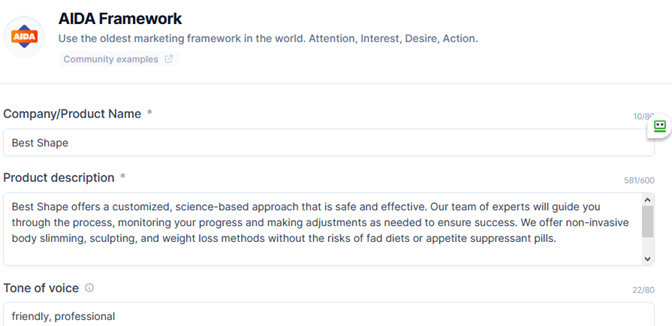
Here’s the first suggestion from Jarvis:
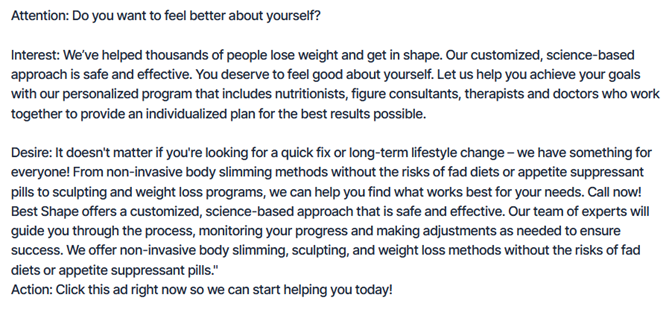
Based on this example, I’d say the AI-generated content is quite engaging. It tried to have a personal touch by letting the customer know they’re here to help. The writing empathizes with consumers who have a hard time losing weight. However, since this is for a new company, the introduction “We have helped thousands of people lose weight and get in shape,” does not apply. So as a writer, I simply have to remove it. This can be replaced with the intent to help more people lose weight and get in shape.
I actually pulled out at least 6 different content suggestions. From these, writers could get the best parts and edit them into one strong copy description. On it’s own, the content would still benefit from a lot of editing. Here are some issues you might encounter while generating copy suggestions:
- Hard Sell Copy. The sample content can be hard sell, even if you specify a professional tone of voice. It tends to use exclamation marks (!) per sample. I believe this depends on the product or service you are writing about. Certain products or services may sell more with the hard sell approach, so the AI suggests this strategy. It may also appear like the “proven” way to communicate to consumers. But if you’re going against this direction, it’s a nuance the AI tool might miss. If your business or client specifically avoids exclamation marks your copy, be ready to make the necessary edits.
- Can be Wordy, Long, Redundant. In terms of style, here’s where you can’t rely on Jarvis to write the entire thing. If you happen to input a long and detailed product description, the AI has a tendency to generate wordy variations of the copy. If you notice, some details are also redundant. In copywriting standards, this needs tightening. Conciseness can be an issue, most notably if you’re not used to brevity. Thus, I believe this tool will best benefit writers and editors who have considerable experience in crafting straightforward copy.
Product Description
The app comes with a special template for creating product descriptions. If you have a large inventory of product information for rewriting, this is the right tool to use. It even comes with an optional language output translation feature, which is available in other templates too.
However, the language feature is limited. I tried putting Thai, Italian, and Japanese and it generated few suggestions, some mixed with English. Same thing with Punjabi and Vietnamese. In other templates, they just keep making English suggestions. Filipino is also not recognized by the AI, which likely means it cannot translate a bunch of other languages. This feature obviously needs development. But it’s not the main feature, so I doubt they’ll do a lot of improvements.
For this example, I used an imagined tire center that offers products and services throughout the U.S. I specifically wrote that it’s the second most affordable tire center in the country. I asked for a professional and witty tone. I’m not at all fluent in Spanish, but I placed Spanish under the output language box.
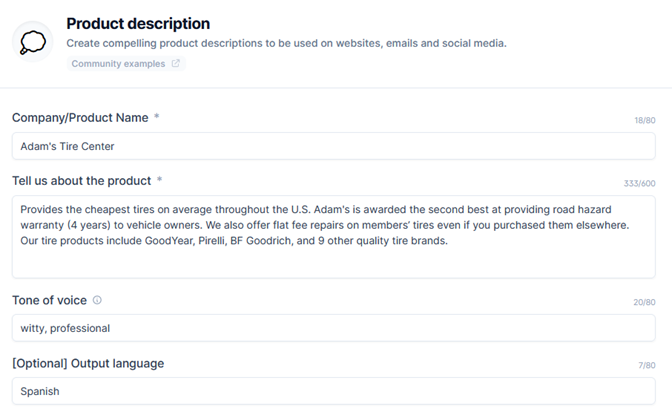
Below is the first suggested copy in Spanish:

When translated through Google, it reads:
“Don’t think twice, Adam’s Tire Center is your best option because it offers the largest range of products for cars and wagons. Join our satisfied customers and insure your tires with the Road Hazard Warranty service. Call or visit our sales center in Miami, FL, where we are honored to help you.”
Obviously, I can’t comment much on the accuracy of the translation. Though certainly, I have doubts for how writing in another language can capture certain styles and tones. But right now, what I’m more concerned with is the tendency to use superlative descriptions that might not accurately fit the brand. Things like “we offer the largest range of products” should probably be tweaked to “we offer a wide range of products…” If your tire center does not offer the largest inventory, you should not be writing that. It also assumed a specific location, which prompts the writer to include the actual business location (this is a good suggestion). Again, the AI copy would benefit from fine-tuning to make it specific to your product or service.
Now, back to English. Here are three other content samples generated by Jarvis: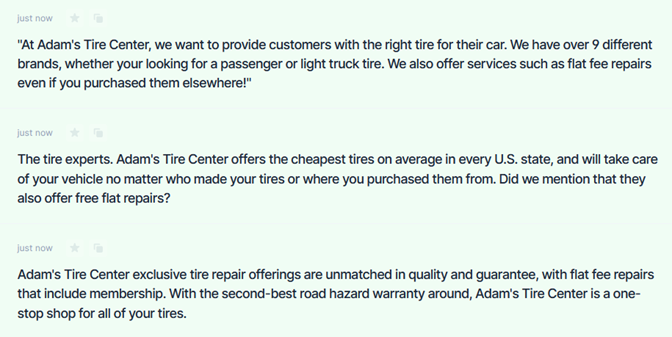
The English AI-generated samples are not so bad. But in the last sample, there is a tendency for hard sell terms like “unmatched in quality,” that you need to watch out for. You can get the best parts and put them into one solid brand description. But again, these tend to be wordy and long. It would help to use the Hemingway app or Grammarly to make the descriptions tight and concise.
Content Improver
Using the Content Improver template will help you tweak the product or service descriptions you came up with. To show you how it works, I placed the content I wrote based on the edited tire center descriptions Jarvis generated.
For this example, I placed professional and witty under tone of voice.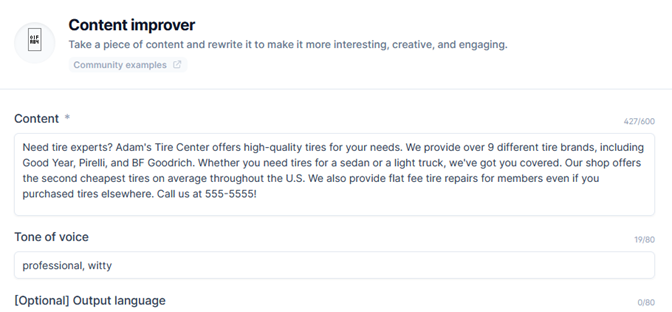
Suggested content from Jarvis: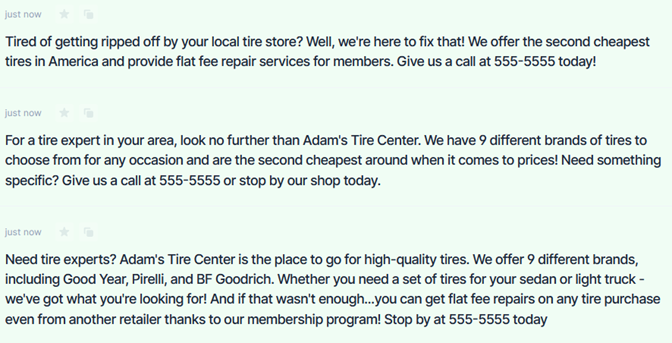
Based on the sample suggestion, I’d say the first two can pretty much stand on their own. These are straightforward copies that address consumer needs with a direct call to action. Though the first one may sound a bit informal, it might fit the type of consumer demographic you are targeting. Finally, the last example gets a bit wordy but can be fixed with a couple of edits. The major issue is the number (555-5555), which the AI mistook for an address.
Marketing Angles
Besides churning out copy suggestions, Conversion.ai has a brainstorming tool. This basically takes your product or service and comes up with various campaign ideas to promote it. If you’re running out of concepts for promotion, Jarvis leverages on your product’s features and strengths. I appreciate that it tried to come up with benefit-driven copy based on the example I put.
For this example, the product I used is a gym management software. It helps gym owners manage activities, schedules, and handle payments. The software aims to run gyms more efficiently.
I personally find the following suggestions helpful in pushing the strengths of a product. I would definitely use this tool for brainstorming ideas. Here’s what Jarvis generated: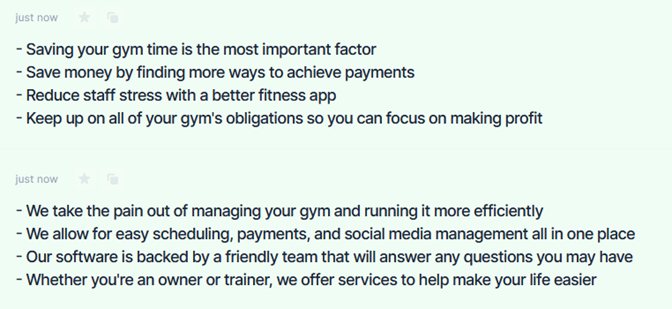
Unique Value Propositions
Another intriguing feature is the unique value propositions (UVP ) template. UVP is essentially a clear statement that describes the benefit your product offers. It also captures how you address your customer’s needs and what distinguishes you from the competition.
If you have a product or service, It claims to generate copy that describes your product’s unique advantage in a remarkable way. To test how this works, I used the previous example, which is the gym software. It came up with several statements that emphasized the product’s benefits. See Jarvis’ suggestions below. Personally, I like the idea of software that helps me make more money with less work.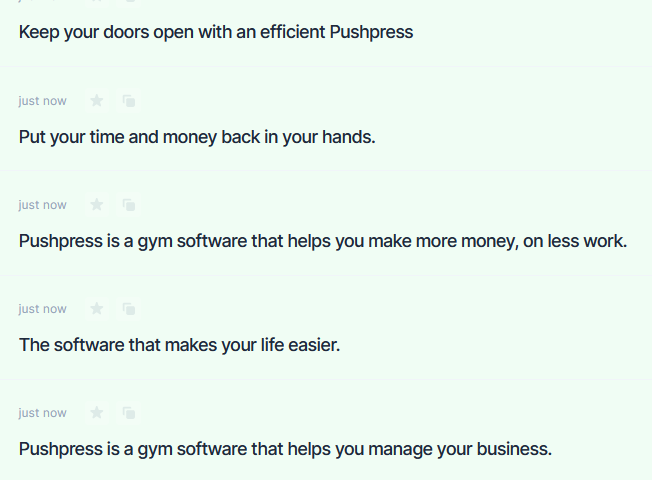
Feature Benefit
The feature benefit template comes up with a list of advantages offered by your product. For this example, the product is a camisole for plus size women. You’ll see how it took the paragraph details and made bulleted benefits based on those features. It’s a useful tool if you want to break down your product’s unique selling points so you can further emphasize them in your campaign.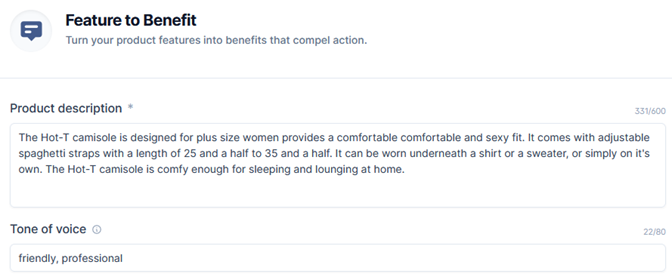

Persuasive Bullet Points
Another related function is the persuasive bullet points template. This is very similar to the feature benefit template. Personally, I think it’s either you use this or the feature benefit template if you want to highlight product advantages in bullet points. On the other hand, this template doesn’t categorize benefits as emotional or standard advantages.
Copy Headline and Sub-headline Templates
Conversioan.ai also comes with copy headline and sub-headline templates. They claim the AI is “trained with formulas from the world’s best copywriters.” It also guaranteed to create “high-converting headlines” for businesses. At this point, the only way to know if it does have high conversion is to see actual results. Right now, my review can’t prove any of that. But it would be interesting to know from companies who have been using this software for results.
- Perfect Headline: For this template, I used an earlier example that provides non-invasive weight loss services. You’ll see the product description I used, followed by the suggestions made by Jarvis. I specifically liked the headline: Science-based approach to safe, effective fat loss. It’s right concept I was going for.
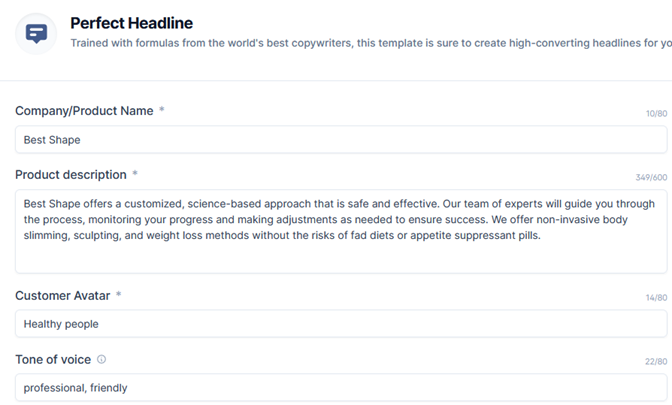
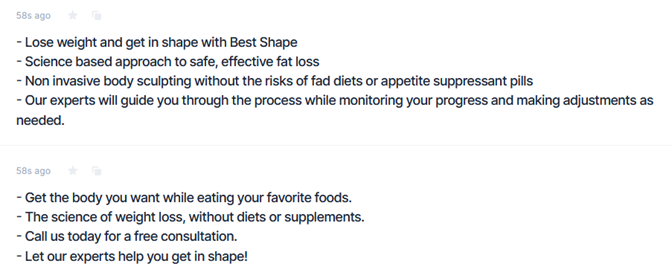
- Website Sub-headline: I used the same product description for the sub-headline. I also used the suggested headline generated by Jarvis, which is “Science-based approach to safe, effective fat loss.” Based on Jarvis’ suggestions, I liked the last one, which emphasizes non-invasive slimming. It also tells consumers the procedure is safe. Though it tends to be wordy, I appreciate it provides different ways you can get your message across.
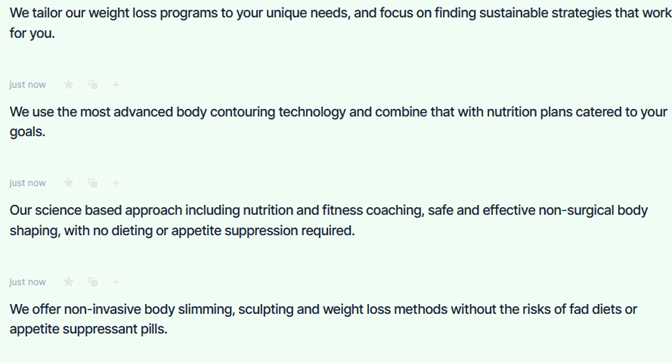
Sentence Expander
Another interesting feature is the sentence expander. It claims to make your sentence longer and more creative. I guess it should help you get to another thought if you caught writer’s block. But I’m wary what kind of suggestions it might give. When I tried it, it’s just another way to rewrite your sentence in a longer, more detailed way.
In any case, see my sentence below.
Here’s what Jarvis generated: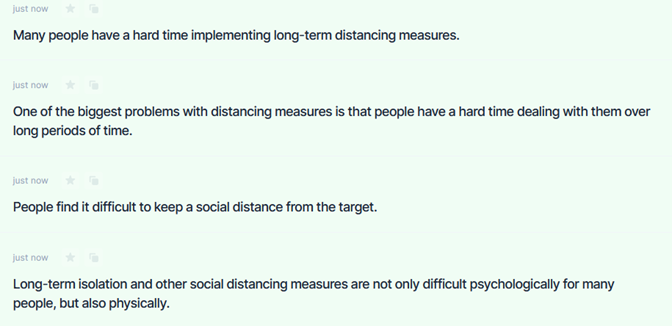
I’m actually not a fan of long-winded sentences. However, I do appreciate the extra details added by the AI. I can use these suggestions if I make further edits on them. But realistically, if I’m writing an article, I’d skip this and go directly to what I’m trying to say. That would save me time. If I want to talk about the negative psychological effects of social distancing, I’d write that point per point. My idea of expansion is moving an argument forward, not merely adding more details to what was already said.
Creative Story
Here’s an interesting template I was curious to try. I wonder how Jarvis would develop a two sentence plot. It’s fascinating to see how an AI that uses “proven high conversion data” would suggest story development.
For my example, I took a horror story plot inspired by the Bone Turner from a popular horror podcast called The Magnus Archives. See my plot description and the suggestions made by Jarvis.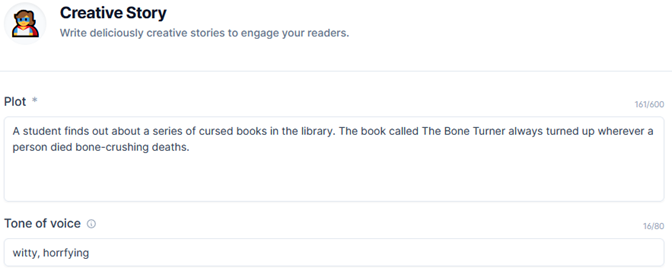
Story suggestions by Jarvis: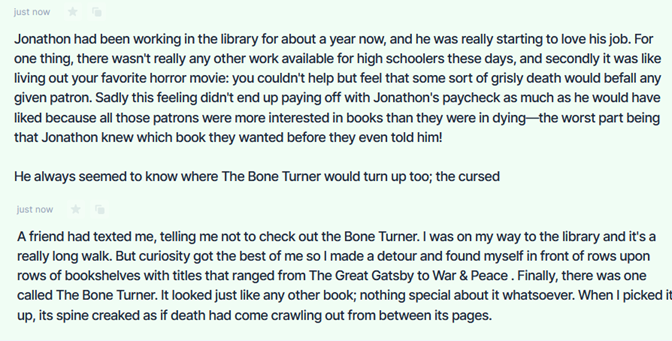
I have to say, these are very interesting ideas for an introduction. It’s also funny how it used the name “Jonathon,” because the actual name of main character in the Magnus Archives is “Jonathan.” I kind of think that was on purpose, since the AI probably knows the Bone Turner is from a popular online show.
In any case, I particularly liked the second suggestion. With some editing and fine-tuning, you could fix the details to fit the story in your head. On the other hand, I’m wary authors might rely too much on this to bridge plot gaps. While it’s amusing, it’s more compelling to read plot twists and resolutions that are not forced. At this stage, I’m still not convinced the AI can make a story without contrived plot twists.
Email Subject Lines
Besides creative writing tools, Coversion.ai also has templates for email marketing. This feature is made for businesses or individuals who want to promote products and services via email. The app claims to come up with catchy subject lines that draw consumers to open your email. In this example, I used an imaginary cake shop that delivers throughout LA. I thought Jarvis came up with a long list of creative subject lines. These were spot on for the example. Since I am a cake person, I’d likely read this kind of email.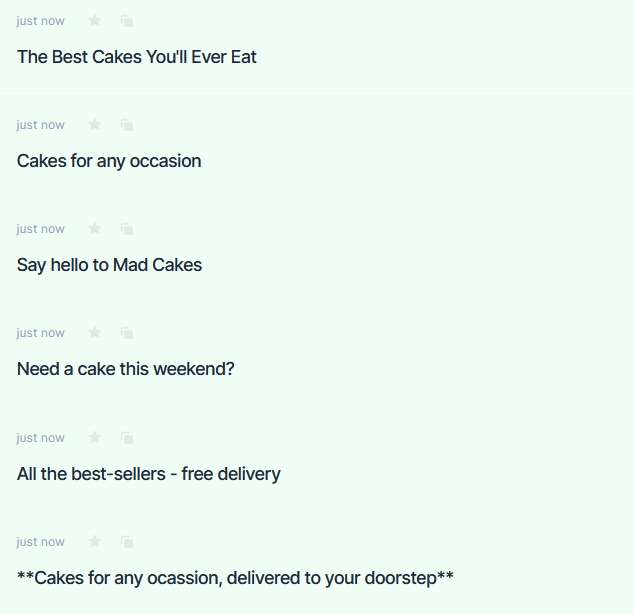
Personal and Company Bio
You can also generate creative personal and company bios through Jarvis. If you’re running a personal blog or website, Jarvis generates personal bios in first person or third person POV, whichever you are more comfortable with. I’m actually pleased with what the AI suggested. It’s a good start, because I find it hard writing about myself.
The example below is not me, of course. I made up Jessica Ackerman as the founder of Mad Cakes in LA.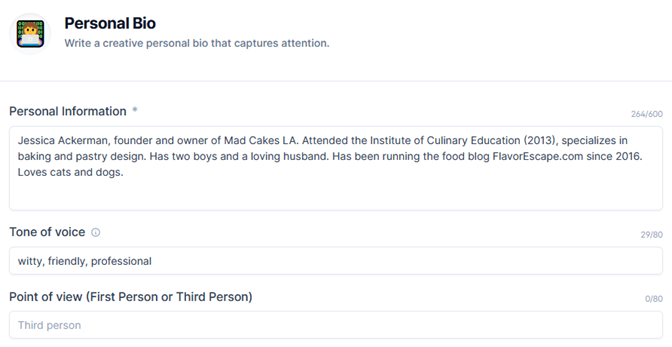
Here’s what Jarvis generated:
It does sound like a personalized bio. Especially with the detail about cuddling with cats and dogs. Again, I’d edit it to be more particular about details. Other than that, I think it’s a good tool to use.
Next, Jarvis also generates company bios that sound professional. I put a three-sentence info about a company that boosts website conversion for businesses. I was surprised how long the suggestions were. It also presumed the names of clients the company has serviced (TripAdvisor, Yelp, etc.). Again, for particular information like this, it’s important to edit or remove them. Otherwise, you might publish copy with misleading details.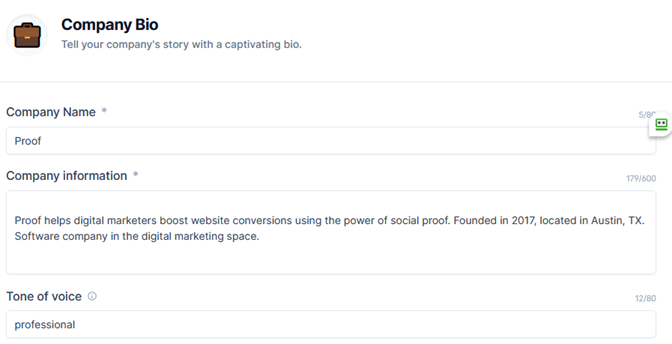
Suggestions from Jarvis: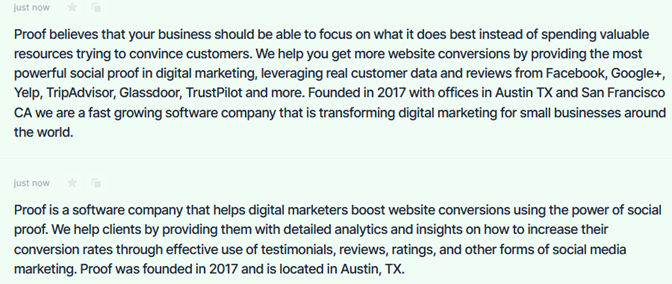
Real Estate Listing – Residential
You can utilize this template to create creative and descriptive residential listings. It’s helpful for real estate agents and people who are planning to sell their property. The following shows information about a house for sale, followed by listing suggestions by Jarvis.
Suggestions from Jarvis: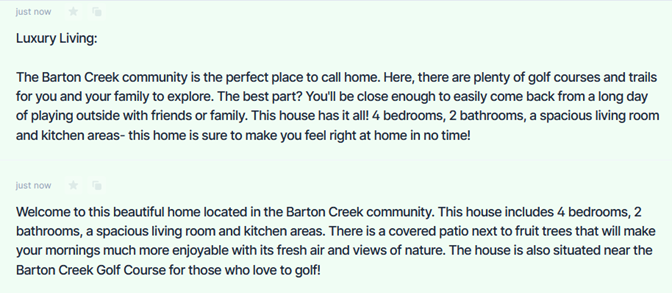
It’s interesting how the suggested content appeals to the consumer’s idea of a perfect home. It tries to paint a picture of affluent living just based on the golf course description I supplied. But again, for accuracy, these added details should be edited by the writer.
Templates for Specific Online Platforms
Besides articles and product or brand descriptions, expect Conversion.ai to provide special writing features for online platforms. This includes Facebook, Instagram, YouTube, Google, and Amazon accounts. The AI’s content suggestions are based on posts and ads that have generated high traffic on these platforms. I think this a good tool to use if you want an edge over what already sells.
- Facebook Ad Headline: Makes catchy headlines for FB ads, claims to increase chances of clicks that lead to sales.
- Facebook Ad Primary Text: Claims to generate high converting copy for FB ad’s primary text section.
For the Facebook ad headline, my example is a cake shop that delivers a wide assortment of cakes in Los Angeles. It specifically mentions delivering cakes “within an hour or your money back.” Here’s the example and Jarvis’ suggested content.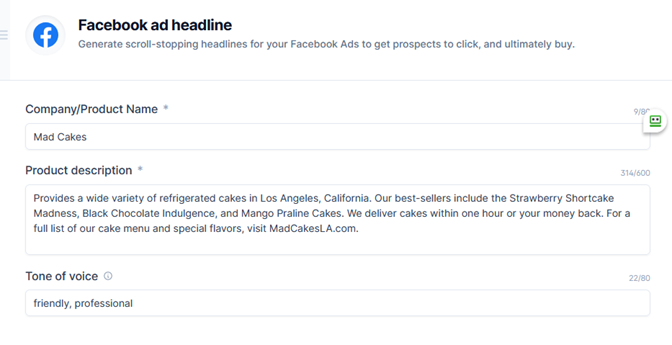
AI ad sample headlines: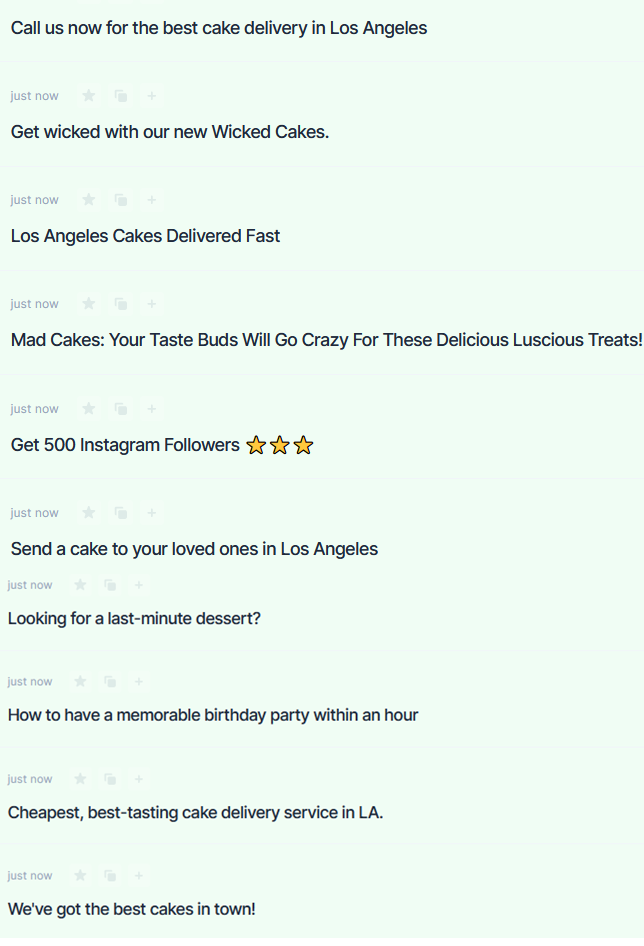
I must say these sound like fun and friendly FB headlines. I personally would like a last minute dessert. And if I don’t have time to pick up cake, I’d certainly like one delivered. Just not sure about “Get 500 Instagram Followers,” the suggestion is out-of-place. I’d use this tool for a fresh and exciting FB headline.
Here’s the AI sample for Facebook ad primary text: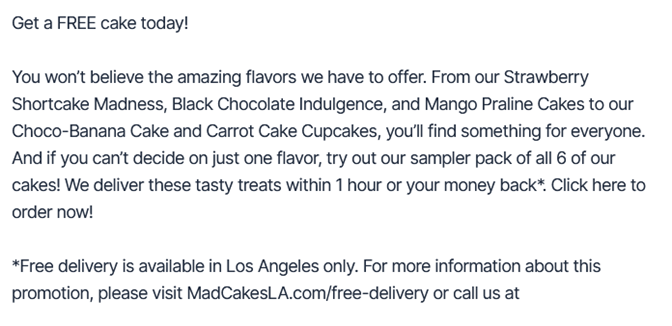
Based on the FB text sample, the AI instantly suggested to give away free cake. Most of the generated samples headed toward this direction. It didn’t just generate engaging copy, it likely showed you what other cake shops do to draw more customers. I think it’s a great marketing strategy to have promos and free cake. I also like that it suggested catchy hashtags. But again, I’d fix the wordy and adjective-ridden descriptions. With a little editing, the samples should read more smoothly. Other than that, it’s a fast way to come up with social media copy.
Photo Post Captions for Instagram
You can use the app for a company or store’s IG accounts. Here are some samples based on a Mad Cakes Black Chocolate Indulgence photo. If you need ideas for your IG post, this tool can suggest copy that’s simple and straightforward for IG. Depending on your product or service, it suggests content that typically targets your customers base.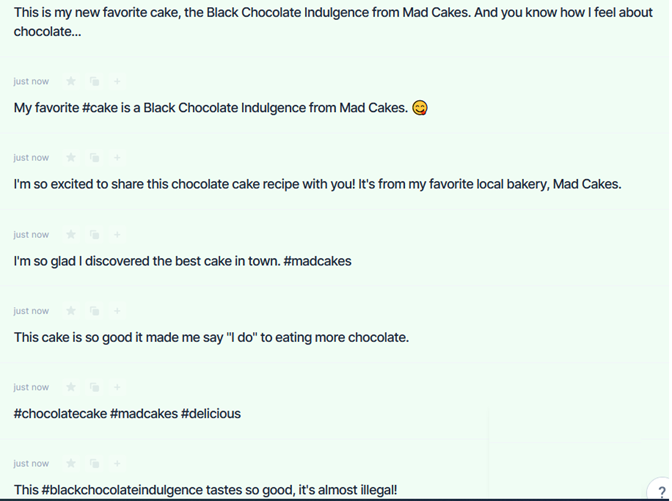
Video Writing Templates for YouTube
Next, Conversion.ai offers specialized templates for videos, specifically for platforms such as YouTube. But I also think you can use the content similarly if you’re posting on other video sites. However, the suggestions are based on content with high traffic on YouTube. It includes the following features:
Video Topic Ideas: For brainstorming video content concepts that rank well on YouTube. For example, your initial topic is baking homemade cake. It’s a useful tool for letting you know what people are actually interested in. It gives you an idea what to work on right off the batt. Here are the AI’s suggestions. It mentions concepts for cake baking videos many people look for: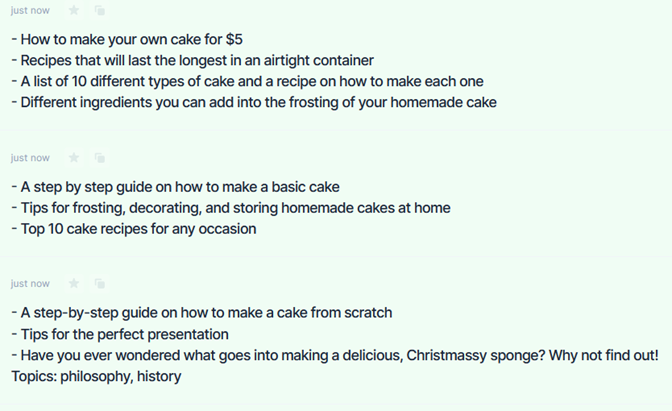
Video Script Outline: Helps make script outlines for any topic. However, this works more suitably for how-to and listicle type videos, not the ones with a narrative. The example below for how to spot aurora borealis or Northern lights. From the AI suggestions, you can choose the best strategies to come up with your own outline. I noticed many suggestions can be too general, besides the more specific ones I posted below. It’s still best to do your own research to make your video content more nuanced and unique. Otherwise, you may just parrot what other content creators have already done.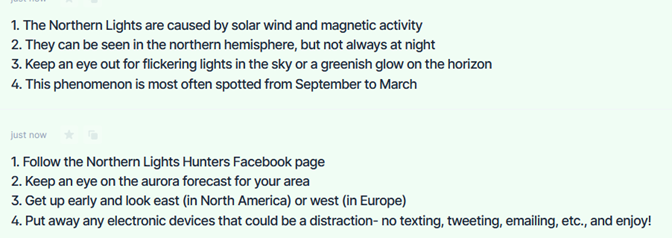
Video Titles: Like the other templates, there’s also a video title feature. As an example, many users on YouTube like to create content about shows or films. Suppose you want to write a feature about the anime Attack on Titan. For the suggestion, the AI actually came up with pretty awesome titles and topics you can start researching on. While this is based on high-traffic fan search, what you can do is watch what’s already there. This will help you come up with more unique insights about the show that has not been tackled. Again, try to focus on what would set your content apart from what’s already there.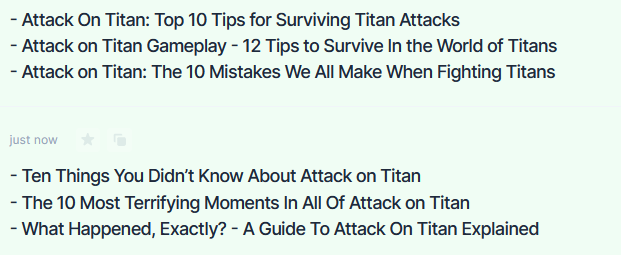
Blog Post Templates
Conversion.ai provides templates that help you conceptual blog posts for your brands. It has tools to help you brainstorm topic ideas and outline your content. These suggestions are all based on high ranking topics on Google. It also comes with features that help compose blog post introductions and conclusions.
- Blog Post Topic Ideas
- Blog Post Outline
- Blog Post Intro Paragraph
- Blog Post Conclusion Paragraph
For the example, let’s focus on the topic template. I used the earlier example, Best Shape, which is an imaginary non-invasive weight loss service. See the AI’s suggestions below.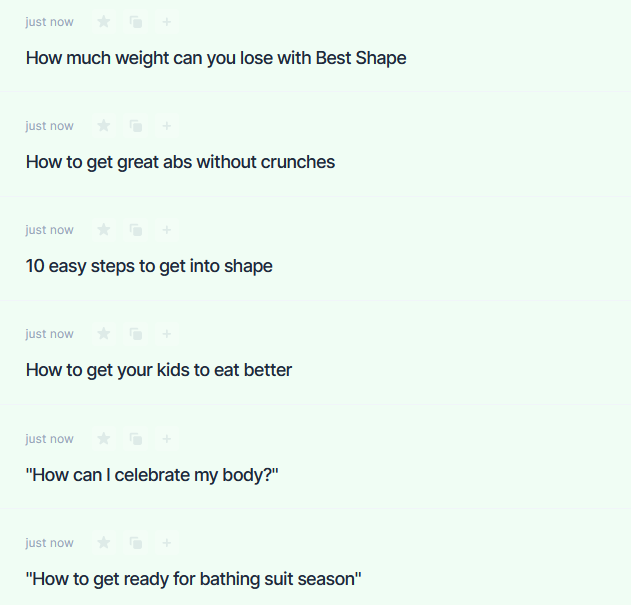
Jarvis’s results show topics that trend around non-invasive weight loss methods. Trending topics around your market is always good to know. For ideas on blog topics, I think Conversion.ai will really be a useful tool. If you need help structuring your outline, I think it’s worth using it especially if you’re having trouble with organization.
Personally, after getting different topics, you can start writing your post without the app. You won’t need it especially if you already have an idea what to write. It’s still better to do proper research than rely on the app to add information on your post. As you’ve noticed, it has a tendency to supply the incorrect information, which you must diligently edit.
Would I Recommend This Software?
After crash testing Conversion.ai, I would recommend this tool to agencies or individuals that deal with extensive online copywriting and product rewrites. They will benefit the most by eliminating the time-consuming process of doing product descriptions. I would also recommend it for businesses that run social media campaigns, including Google and Amazon ads. This will help generate and organize copy ideas faster, especially if you have a lot of products and services to promote. And because the AI suggestions are based on high-ranking topics, you have a better idea of what your client base is also looking for. It can also enhance messaging concepts and help brainstorm new campaign ideas for a product or brand. Just remember to always edit the content suggestions.
On the other hand, I would not recommend this app for long-form writing. I do not think it is ideal for any writing that requires a lot of research. Because the AI suggestions tend towards incorrect information, you’re better off researching current data on your own. It’s an interesting tool for wring stories, but I also worry authors might be too reliant on the app for plot ideas. There is a difference between carefully worded prose versus long-winded sentences composed by this app. Human writing is still more precise with expression, which the AI has yet to learn.
While it’s a good tool to have, the bottom line is, you still need to edit your content. It will help you structure your outline and compose your post. However, the impetus for writing and the direction it will take is still on you, the writer. My verdict? AI writing technology won’t fully replace humans anytime soon.
Conversion.ai Review
Background / Intro
One of my longtime friends who was Internet marketing long before I was hit me up on Skype about a week ago praising Conversion.ai. I have to think long and hard about any other time he has really pitched or recommended something like that & really I just can’t think of any other time where he did that. The following day my wife Giovanna mentioned something to me and I was like “oh you should check out this thing my buddy recommended yesterday” and then I looked and realized they were both talking about the same thing. :D
I have a general heuristic that if people I trust recommend things I put them near the top of the “to do” list and if multiple people I trust do that I pull out the credit card and run at it.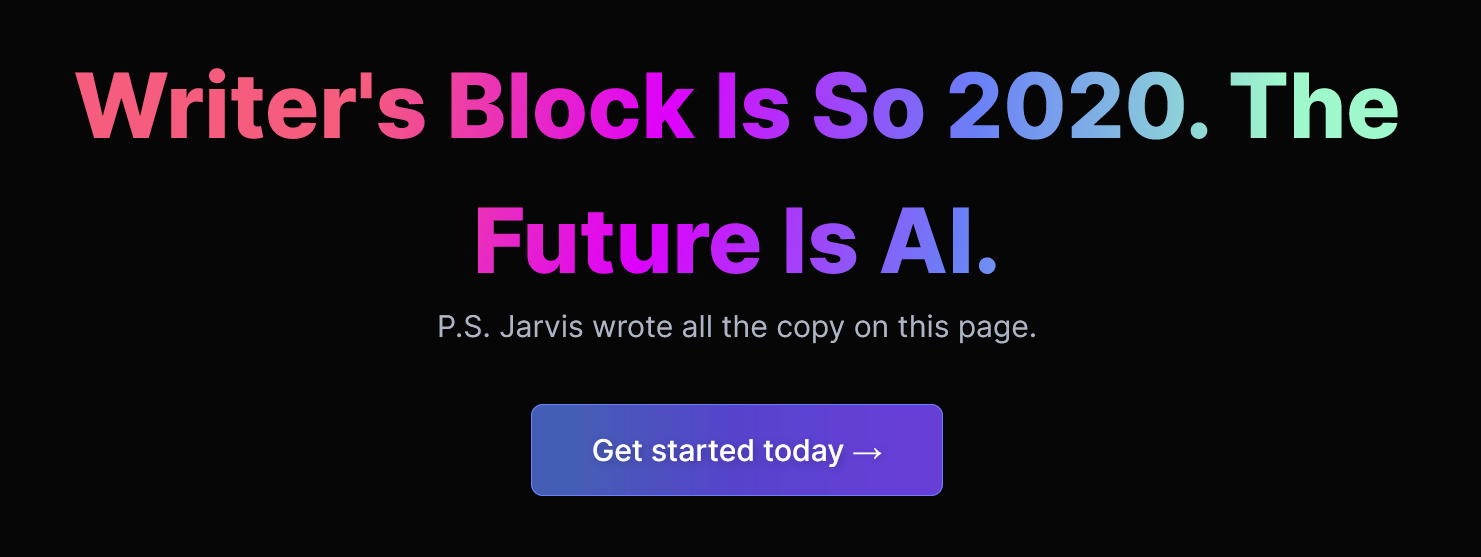
Unfortunately I have been a bit burned out recently and launched a new site which I have put a few hundred hours into, so I haven’t had the time to do too much testing, BUT I have a writer who works for me who has a master’s degree in writing, and figured she could do a solid review. And she did. :D
She is maybe even a bit more cynical than I am (is that even possible?) and a certified cat lady who loves writing, reading, poetry and is more into a soft sell versus aggressive sales.
Full disclosure…the above link and the one at the end of this post are affiliate links, but they had zero impact on the shape or format of the review. The reviewer was completely disconnected from the affiliate program and I pulled out my credit card to pay for the software for her to test it out.
With that tiny bit of a micro-introduction, the rest of the post from here on out is hers. I may have made a couple minor edits for clarity (and probably introduced a few errors she will choke me for. :D) but otherwise the rest of this post is all her …
An In-depth Review of the Conversion.ai Writing Software
Considering the possibilities of artificial intelligence (AI), we picture robots doing tasks autonomously like humans. With a computer’s brain power, productivity is accelerated significantly. We also expect AI programs to have the capability to evolve intelligently the longer they are used. These types of AI employ “machine learning,” or deep learning to solve problems.
AI technology can be leveraged by various industries, especially with writing. Recently, I learned about the Conversion.ai copywriting tool. It uses machine learning which claims to write “high converting copy” for websites, ads, landing pages, emails, etc. The software is geared towards writers, marketers, entrepreneurs, and agencies that benefit from creating engaging and effective copy. To date, companies such as Hubspot, Shopify, and Salesforce are known to use the software. Currently, it’s offering a 7-day free trial with 20,000-word credits.
To give you the lowdown on Conversion.ai, I wrote an in-depth review of how this software works. I’ll go through its various features and show examples of how I used them. I’ll include the advantages of using Conversion.ai’s Jarvis (that’s what it’s called) in writing scenarios. More importantly, I’ll discuss challenges and specific limitations this tool might present.
Assistance in Creating High Conversion Copy
As a writer doing web copy for 10 years, including the time I took a post-grad creative writing degree, I grabbed the opportunity to try this AI software. For starters, it struck me how Conversion.ai claims to provide “high converting copy” for increased conversion and higher ROI. Such claims are a tall order. If you’ve been in the marketing or sales industry, you’d know conversion depends on so many other factors, such as the quality of the actual product, customer support, price, etc. It’s not just how well copy is written, though it’s a vital part. But anyway, upon more research, I learned the app generates copy based on proven high conversion sales and marketing messages.
To be honest, I have mixed feelings about this conversion strategy. I believe it’s a double-edged sword. This is not to undermine facts or measurable data. Basing content creation on “proven content” means you’re likely using the same phrases, techniques, and styles already used by successful competitors. This serves as a jumping board for ideas of course, so you know what’s already there. However, it can be an echo chamber. Marketers must not forget that execution must still be fresh. Otherwise, you’ll sound like everyone else.
Next, while it seems sustainable, it also sounds pretty safe. If your product or service is not that distinct, you must put extra effort to create content that stands out. This applies to all aspects of the marketing strategy, not just in writing content. It’s a crucial principal I learned after reading Purple Cow by Seth Godin (thanks for the book suggestion, Aaron!).

Depending on your product or service, Conversion.ai will generate copy that most consumers keep going back to. Based on the samples it generated, I’d say it really does come up with engaging copy, though it needs editing. If your business must rewrite product descriptions for extensive inventories, Conversion.ai can cut the time in half. It can help automate description rewriting without hiring more writers. That saves money and time, so businesses need fewer writers and editors.
What did I learn? Conversion.ai can make writing and editing faster, yes, especially for low-level content focused on descriptions. It can also inform the strength of your ideas for more creative campaigns. However, it still takes solid direction and creativity to drive good marketing copy forward. That said, it’s only as good as the writer utilizing this app. As a content creator, you cannot rely on it solely for creativity. But as an enhancer, it will significantly help push ideas forward, organize campaigns, and structure engaging copy effectively.
When you use this app, it offers many different features that help create and organize content. It also customizes copy for various media platforms. Beyond rewriting , it even has special brainstorming tools designed to help writers consider various idea angles. This can add more flavor and uniqueness into a campaign.
At the end of the day, what will set your copy apart is the strength of your ideas and your communication strategy. How you customize content for a business is still entirely up to you. AI writing tools like Conversion.ai can only help enhance your content and the ideas behind it. It’s a far cry from creating truly unique concepts for your campaign, but it definitely helps.
Conversion.ai Writing Features & How They Work
This AI writing app comes with plenty of “writing templates” that are customized to help you write with a specific framework or media platform in mind. Currently, Conversion.ai offers 39 different writing templates or content building blocks that deliver results. We’ll provide details for how each one works.
For company or product descriptions, Conversion.ai has a Start Here step by step guide, which says users should alternate between the Product Description and the Content Improver template until they have found the right mix they’re looking for. But for this review, I just focused on how to use the templates for different writing projects. The app comes with video instructions as well as a live training call if you need further assistance on how to use it.
Each template asks you to input a description or what you want to write about. This is limited to 600 characters. Writing the description is the sole basis for how Jarvis will generate ways to write or expand your content. It also helps you brainstorm and structure ideas for an article or campaign.
But as an issue, I find the 600-character limit can hinder reposting the full content generated by the AI back into the template for improvement. Yes, it churns out marketing copy of more than 600 characters. If you want to post the improved copy again, you might have to do this in two batches. In any case, Jarvis can generate as many improved writing samples as you need.
To give you a better idea, here are different Conversion.ai templates and how they work. This is going to take a while, so have your coffee ready.
Long-form Assistant
This is for longer articles, emails, scripts, and stories. It’s also suggested for writing books. It has two modes, a blank document where you can start typing freely and an assistant workflow. The blank document also lets you access the rest of the other writing templates vertically. On the other hand, the long-form assistant workflow is where the app asks you to describe the content you want to create. Consider this carefully. The better you can articulate your topic, the higher quality content Jarvis can help generate.
For the example, suppose I want to write about what it took to finally release Zack Synder’s 2021 Justice League. I want to write this feature article for my film and culture website.

Jarvis asks for a maximum of three keywords. It’s optional, but I presume adding keywords will help Jarvis generate more relevant content. Next, it prompts you to write a working title and start an introductory paragraph. Once you write your initial title, it will generate other title ideas.
For the title, I wrote: The Challenges of Releasing Zach Snyder’s Justice League 2021
It generated the following suggestions:

Jarvis generated a long list of appropriate and catchy titles. I personally liked “The Tumultuous Journey of Zack Snyder’s Justice League 2021,” though I’d shorten it a bit. I also liked “The Darkest, Toughest Production in Film History,” which basically tells audiences how hard it was to produce the version of the film. Though it’s an exaggeration, it can be qualified in the article. The other suggestions with “Behind the Scenes” and “Towards a Better Script” were more specific angles. I like that I could explore those topics too. Generally, I think it’s definitely a great tool to make title writing faster.
So far, so good, right? But when I got to content suggestions, it got a bit messy. It was mainly because the suggested content was too general. It also tended toward suggesting expansions that were incoherent to the main topic. This did not sound very promising. Moreover, the AI added bits of information such as dates and other related information. I had to check if these details were used accurately. In a previous test I did (and even for this example), it completely got a date wrong. So I advise writers to always double check the details suggested by Jarvis.
Take a look below. The top paragraph was the one I wrote, while the ones below are suggested by Jarvis.

Content suggestions from Jarvis:
1) You might not be able to see Zack Snyder’s Justice League on the big screen, but you can catch it online in 2021. It was released digitally by Warner Bros. on November 27th 2020 and we’ve been watching it slowly climb the ranks of IMDB since then. The film had a troubled production between 2016 and 2017 with the script going through major changes before and during shooting. But now that all is said and done, what did people think? Let’s find out!
2) Justice League is a film that was released on November 17, 2017. The movie had been preceded by Batman v Superman: Dawn of Justice and Wonder Woman. It’s also the fifth installment in the DC Extended Universe (DCEU). Despite being generally well-received by critics, it was considered to be a disappointment at the box office. In this blog post, we’ll take you behind the scenes and show you what went wrong with Zack Snyder’s 2021 Justice League film production!
3) Director Zack Snyder’s Justice League film was one of the most anticipated films of 2017. Unfortunately, the film had a troubled production and was not released until 2021. That didn’t stop it from becoming one of the highest-grossing films of all time. What does this have to do with SEO? When you release content on your website, be sure to include keywords that are relevant to your business and industry!
At first glance, the introduction actually looks appealing to Justice League fans. Many people have been anticipating it on the big screen. But upon further reading, compared to the paragraph I wrote, the AI content had so many problems. Besides being too general, it had issues with imprecise details. Though you can argue these problems are small and editable, it adds time to your work. It can even derail you from focusing on your topic.
The first AI suggestion wrote that Snyder Cut was released digitally by Warner Bros. in November 27, 2020. Upon further research, I found no such confirmation of this. However, there was a YouTube video “speculating” it’s release in November 2020. But from the looks of it, this did not pan out. Officially, Zack Snyder’s Justice League was released in March 18, 2021 by HBO Max via streaming platform, according to Rotten Tomatoes. And yes, it has been climbing the ranks since its digital release.
If you’re not careful about fact-checking, you might end up with misleading information. And frankly, I feel as if some of the other suggestions may tend towards fluff. However, what you can do is choose the best suggestions and put them together into one coherent paragraph. The first suggestion ended the introduction with “But now that all is said and done, what did people think? Let’s find out!” While it’s something I want to touch on eventually, it is not the main focus of my introduction. The AI was not sensitive enough to sense this follow up was out of place. I’d rather get to the details of the challenging production. If I use this suggestion, I’ll have to edit it into “Let’s take a look at what it took to deliver the highly anticipated Snyder Cut,” or something to that effect.
The second example, on the other hand, was quite a miss. It started by talking about the 2017 Justice League film. While it’s good to expound on the history of the project started, it got lost in discussing the 2017 version. Worse, it did not transition the topic smoothly into the 2021 Snyder Cut. If I read this introduction, I’d be confused into thinking the article was about the 2017 Justice League. Finally, it awkwardly ended the paragraph with “we’ll take you behind the scenes and show you what went wrong with Zack Snyder’s 2021 Justice League film production!” Besides the wordy sentence, suddenly it’s talking about the 2021 Justice League out of nowhere. I would not phrase the production’s challenges as something that went wrong. That’s unnecessary hype. It’s confusing, and just an example of bad writing. Again, while it can be fixed with editing, I feel better off writing on my own.
Finally, the third example actually started okay. But then it started talking about SEO out of nowhere. I don’t know where that came from or why the AI did that, but I’ll count it as a totally unusable suggestion from the app. I reckon there might be more of those glitches if I generate more content suggestions from Jarvis.
SIDEBAR FROM AARON: COUGH. SEO IS EVERYTHING. HOW DO I REEEEECH DEZ KIDZ
I noticed these were nuances the AI was not able to catch. It’s probably even based on trending articles at the time, which had a tendency towards hype and dated showbiz information. And though the suggestions were interesting, they were mostly too general or against the direction I needed. If the usage of the information is not accurate, imagine what that would mean for health or political articles. But too be fair, it did generate other usable suggestions with less serious edits. It’s worth looking into those.
However, by this time, I felt I was better off writing the feature without the app, at least for this example. I guess it’s really a hit or miss. Even with so many content suggestions, I think you can still end up with inappropriate samples even if you find good ones. But at least you got a good title already. Personally, I’d rather go straight to researching on my own.
Framework Templates
Conversion.ai allows you to write copy based on marketing frameworks that have been used by professionals for years. It’s ideal for brands, products, and services you need to promote. This features includes the following templates:
- AIDA Framework: The AIDA template stands for Attention, Interest, Desire, and Action. This basically divides your copy into sections drawing attention from consumers and piquing their interest. The suggested copy also includes content that appeals to the consumer’s desire, then ends with a call to action.
- PAS Framework: The PAS template is structured by generating copy which highlights the consumer’s Problem, Agitate, and Solution. It’s focused on how a particular product will help solve a consumer’s problem.
- Bridge-After-Bridge Framework: Also known as BAB framework, this copywriting structure revolves around the idea of getting a consumer from a bad place to a better one. It shows the before and after scenario after benefitting from a product.
For this example, I used the AIDA template for an imagined non-invasive weight loss service company. The new company promotes fitness and advocates against fad diets. It performs non-surgical weight loss procedures, such as wraps and thermomagnetic massages.
Again, Jarvis asks for a description. It also requires you to specify the tone of the copy. I placed “friendly” and “professional” under the box. See my input below.

Here’s the first suggestion from Jarvis:

Based on this example, I’d say the AI-generated content is quite engaging. It tried to have a personal touch by letting the customer know they’re here to help. The writing empathizes with consumers who have a hard time losing weight. However, since this is for a new company, the introduction “We have helped thousands of people lose weight and get in shape,” does not apply. So as a writer, I simply have to remove it. This can be replaced with the intent to help more people lose weight and get in shape.
I actually pulled out at least 6 different content suggestions. From these, writers could get the best parts and edit them into one strong copy description. On it’s own, the content would still benefit from a lot of editing. Here are some issues you might encounter while generating copy suggestions:
- Hard Sell Copy. The sample content can be hard sell, even if you specify a professional tone of voice. It tends to use exclamation marks (!) per sample. I believe this depends on the product or service you are writing about. Certain products or services may sell more with the hard sell approach, so the AI suggests this strategy. It may also appear like the “proven” way to communicate to consumers. But if you’re going against this direction, it’s a nuance the AI tool might miss. If your business or client specifically avoids exclamation marks your copy, be ready to make the necessary edits.
- Can be Wordy, Long, Redundant. In terms of style, here’s where you can’t rely on Jarvis to write the entire thing. If you happen to input a long and detailed product description, the AI has a tendency to generate wordy variations of the copy. If you notice, some details are also redundant. In copywriting standards, this needs tightening. Conciseness can be an issue, most notably if you’re not used to brevity. Thus, I believe this tool will best benefit writers and editors who have considerable experience in crafting straightforward copy.
Product Description
The app comes with a special template for creating product descriptions. If you have a large inventory of product information for rewriting, this is the right tool to use. It even comes with an optional language output translation feature, which is available in other templates too.
However, the language feature is limited. I tried putting Thai, Italian, and Japanese and it generated few suggestions, some mixed with English. Same thing with Punjabi and Vietnamese. In other templates, they just keep making English suggestions. Filipino is also not recognized by the AI, which likely means it cannot translate a bunch of other languages. This feature obviously needs development. But it’s not the main feature, so I doubt they’ll do a lot of improvements.
For this example, I used an imagined tire center that offers products and services throughout the U.S. I specifically wrote that it’s the second most affordable tire center in the country. I asked for a professional and witty tone. I’m not at all fluent in Spanish, but I placed Spanish under the output language box.

Below is the first suggested copy in Spanish:

When translated through Google, it reads:
“Don’t think twice, Adam’s Tire Center is your best option because it offers the largest range of products for cars and wagons. Join our satisfied customers and insure your tires with the Road Hazard Warranty service. Call or visit our sales center in Miami, FL, where we are honored to help you.”
Obviously, I can’t comment much on the accuracy of the translation. Though certainly, I have doubts for how writing in another language can capture certain styles and tones. But right now, what I’m more concerned with is the tendency to use superlative descriptions that might not accurately fit the brand. Things like “we offer the largest range of products” should probably be tweaked to “we offer a wide range of products…” If your tire center does not offer the largest inventory, you should not be writing that. It also assumed a specific location, which prompts the writer to include the actual business location (this is a good suggestion). Again, the AI copy would benefit from fine-tuning to make it specific to your product or service.
Now, back to English. Here are three other content samples generated by Jarvis:
The English AI-generated samples are not so bad. But in the last sample, there is a tendency for hard sell terms like “unmatched in quality,” that you need to watch out for. You can get the best parts and put them into one solid brand description. But again, these tend to be wordy and long. It would help to use the Hemingway app or Grammarly to make the descriptions tight and concise.
Content Improver
Using the Content Improver template will help you tweak the product or service descriptions you came up with. To show you how it works, I placed the content I wrote based on the edited tire center descriptions Jarvis generated.
For this example, I placed professional and witty under tone of voice.
Suggested content from Jarvis:
Based on the sample suggestion, I’d say the first two can pretty much stand on their own. These are straightforward copies that address consumer needs with a direct call to action. Though the first one may sound a bit informal, it might fit the type of consumer demographic you are targeting. Finally, the last example gets a bit wordy but can be fixed with a couple of edits. The major issue is the number (555-5555), which the AI mistook for an address.
Marketing Angles
Besides churning out copy suggestions, Conversion.ai has a brainstorming tool. This basically takes your product or service and comes up with various campaign ideas to promote it. If you’re running out of concepts for promotion, Jarvis leverages on your product’s features and strengths. I appreciate that it tried to come up with benefit-driven copy based on the example I put.
For this example, the product I used is a gym management software. It helps gym owners manage activities, schedules, and handle payments. The software aims to run gyms more efficiently.
I personally find the following suggestions helpful in pushing the strengths of a product. I would definitely use this tool for brainstorming ideas. Here’s what Jarvis generated:
Unique Value Propositions
Another intriguing feature is the unique value propositions (UVP ) template. UVP is essentially a clear statement that describes the benefit your product offers. It also captures how you address your customer’s needs and what distinguishes you from the competition.
If you have a product or service, It claims to generate copy that describes your product’s unique advantage in a remarkable way. To test how this works, I used the previous example, which is the gym software. It came up with several statements that emphasized the product’s benefits. See Jarvis’ suggestions below. Personally, I like the idea of software that helps me make more money with less work.
Feature Benefit
The feature benefit template comes up with a list of advantages offered by your product. For this example, the product is a camisole for plus size women. You’ll see how it took the paragraph details and made bulleted benefits based on those features. It’s a useful tool if you want to break down your product’s unique selling points so you can further emphasize them in your campaign.

Persuasive Bullet Points
Another related function is the persuasive bullet points template. This is very similar to the feature benefit template. Personally, I think it’s either you use this or the feature benefit template if you want to highlight product advantages in bullet points. On the other hand, this template doesn’t categorize benefits as emotional or standard advantages.
Copy Headline and Sub-headline Templates
Conversioan.ai also comes with copy headline and sub-headline templates. They claim the AI is “trained with formulas from the world’s best copywriters.” It also guaranteed to create “high-converting headlines” for businesses. At this point, the only way to know if it does have high conversion is to see actual results. Right now, my review can’t prove any of that. But it would be interesting to know from companies who have been using this software for results.
- Perfect Headline: For this template, I used an earlier example that provides non-invasive weight loss services. You’ll see the product description I used, followed by the suggestions made by Jarvis. I specifically liked the headline: Science-based approach to safe, effective fat loss. It’s right concept I was going for.


- Website Sub-headline: I used the same product description for the sub-headline. I also used the suggested headline generated by Jarvis, which is “Science-based approach to safe, effective fat loss.” Based on Jarvis’ suggestions, I liked the last one, which emphasizes non-invasive slimming. It also tells consumers the procedure is safe. Though it tends to be wordy, I appreciate it provides different ways you can get your message across.

Sentence Expander
Another interesting feature is the sentence expander. It claims to make your sentence longer and more creative. I guess it should help you get to another thought if you caught writer’s block. But I’m wary what kind of suggestions it might give. When I tried it, it’s just another way to rewrite your sentence in a longer, more detailed way.
In any case, see my sentence below.
Here’s what Jarvis generated:
I’m actually not a fan of long-winded sentences. However, I do appreciate the extra details added by the AI. I can use these suggestions if I make further edits on them. But realistically, if I’m writing an article, I’d skip this and go directly to what I’m trying to say. That would save me time. If I want to talk about the negative psychological effects of social distancing, I’d write that point per point. My idea of expansion is moving an argument forward, not merely adding more details to what was already said.
Creative Story
Here’s an interesting template I was curious to try. I wonder how Jarvis would develop a two sentence plot. It’s fascinating to see how an AI that uses “proven high conversion data” would suggest story development.
For my example, I took a horror story plot inspired by the Bone Turner from a popular horror podcast called The Magnus Archives. See my plot description and the suggestions made by Jarvis.
Story suggestions by Jarvis:
I have to say, these are very interesting ideas for an introduction. It’s also funny how it used the name “Jonathon,” because the actual name of main character in the Magnus Archives is “Jonathan.” I kind of think that was on purpose, since the AI probably knows the Bone Turner is from a popular online show.
In any case, I particularly liked the second suggestion. With some editing and fine-tuning, you could fix the details to fit the story in your head. On the other hand, I’m wary authors might rely too much on this to bridge plot gaps. While it’s amusing, it’s more compelling to read plot twists and resolutions that are not forced. At this stage, I’m still not convinced the AI can make a story without contrived plot twists.
Email Subject Lines
Besides creative writing tools, Coversion.ai also has templates for email marketing. This feature is made for businesses or individuals who want to promote products and services via email. The app claims to come up with catchy subject lines that draw consumers to open your email. In this example, I used an imaginary cake shop that delivers throughout LA. I thought Jarvis came up with a long list of creative subject lines. These were spot on for the example. Since I am a cake person, I’d likely read this kind of email.
Personal and Company Bio
You can also generate creative personal and company bios through Jarvis. If you’re running a personal blog or website, Jarvis generates personal bios in first person or third person POV, whichever you are more comfortable with. I’m actually pleased with what the AI suggested. It’s a good start, because I find it hard writing about myself.
The example below is not me, of course. I made up Jessica Ackerman as the founder of Mad Cakes in LA.
Here’s what Jarvis generated:
It does sound like a personalized bio. Especially with the detail about cuddling with cats and dogs. Again, I’d edit it to be more particular about details. Other than that, I think it’s a good tool to use.
Next, Jarvis also generates company bios that sound professional. I put a three-sentence info about a company that boosts website conversion for businesses. I was surprised how long the suggestions were. It also presumed the names of clients the company has serviced (TripAdvisor, Yelp, etc.). Again, for particular information like this, it’s important to edit or remove them. Otherwise, you might publish copy with misleading details.
Suggestions from Jarvis:
Real Estate Listing – Residential
You can utilize this template to create creative and descriptive residential listings. It’s helpful for real estate agents and people who are planning to sell their property. The following shows information about a house for sale, followed by listing suggestions by Jarvis.
Suggestions from Jarvis:
It’s interesting how the suggested content appeals to the consumer’s idea of a perfect home. It tries to paint a picture of affluent living just based on the golf course description I supplied. But again, for accuracy, these added details should be edited by the writer.
Templates for Specific Online Platforms
Besides articles and product or brand descriptions, expect Conversion.ai to provide special writing features for online platforms. This includes Facebook, Instagram, YouTube, Google, and Amazon accounts. The AI’s content suggestions are based on posts and ads that have generated high traffic on these platforms. I think this a good tool to use if you want an edge over what already sells.
- Facebook Ad Headline: Makes catchy headlines for FB ads, claims to increase chances of clicks that lead to sales.
- Facebook Ad Primary Text: Claims to generate high converting copy for FB ad’s primary text section.
For the Facebook ad headline, my example is a cake shop that delivers a wide assortment of cakes in Los Angeles. It specifically mentions delivering cakes “within an hour or your money back.” Here’s the example and Jarvis’ suggested content.
AI ad sample headlines:
I must say these sound like fun and friendly FB headlines. I personally would like a last minute dessert. And if I don’t have time to pick up cake, I’d certainly like one delivered. Just not sure about “Get 500 Instagram Followers,” the suggestion is out-of-place. I’d use this tool for a fresh and exciting FB headline.
Here’s the AI sample for Facebook ad primary text:
Based on the FB text sample, the AI instantly suggested to give away free cake. Most of the generated samples headed toward this direction. It didn’t just generate engaging copy, it likely showed you what other cake shops do to draw more customers. I think it’s a great marketing strategy to have promos and free cake. I also like that it suggested catchy hashtags. But again, I’d fix the wordy and adjective-ridden descriptions. With a little editing, the samples should read more smoothly. Other than that, it’s a fast way to come up with social media copy.
Photo Post Captions for Instagram
You can use the app for a company or store’s IG accounts. Here are some samples based on a Mad Cakes Black Chocolate Indulgence photo. If you need ideas for your IG post, this tool can suggest copy that’s simple and straightforward for IG. Depending on your product or service, it suggests content that typically targets your customers base.
Video Writing Templates for YouTube
Next, Conversion.ai offers specialized templates for videos, specifically for platforms such as YouTube. But I also think you can use the content similarly if you’re posting on other video sites. However, the suggestions are based on content with high traffic on YouTube. It includes the following features:
Video Topic Ideas: For brainstorming video content concepts that rank well on YouTube. For example, your initial topic is baking homemade cake. It’s a useful tool for letting you know what people are actually interested in. It gives you an idea what to work on right off the batt. Here are the AI’s suggestions. It mentions concepts for cake baking videos many people look for:
Video Script Outline: Helps make script outlines for any topic. However, this works more suitably for how-to and listicle type videos, not the ones with a narrative. The example below for how to spot aurora borealis or Northern lights. From the AI suggestions, you can choose the best strategies to come up with your own outline. I noticed many suggestions can be too general, besides the more specific ones I posted below. It’s still best to do your own research to make your video content more nuanced and unique. Otherwise, you may just parrot what other content creators have already done.
Video Titles: Like the other templates, there’s also a video title feature. As an example, many users on YouTube like to create content about shows or films. Suppose you want to write a feature about the anime Attack on Titan. For the suggestion, the AI actually came up with pretty awesome titles and topics you can start researching on. While this is based on high-traffic fan search, what you can do is watch what’s already there. This will help you come up with more unique insights about the show that has not been tackled. Again, try to focus on what would set your content apart from what’s already there.
Blog Post Templates
Conversion.ai provides templates that help you conceptual blog posts for your brands. It has tools to help you brainstorm topic ideas and outline your content. These suggestions are all based on high ranking topics on Google. It also comes with features that help compose blog post introductions and conclusions.
- Blog Post Topic Ideas
- Blog Post Outline
- Blog Post Intro Paragraph
- Blog Post Conclusion Paragraph
For the example, let’s focus on the topic template. I used the earlier example, Best Shape, which is an imaginary non-invasive weight loss service. See the AI’s suggestions below.
Jarvis’s results show topics that trend around non-invasive weight loss methods. Trending topics around your market is always good to know. For ideas on blog topics, I think Conversion.ai will really be a useful tool. If you need help structuring your outline, I think it’s worth using it especially if you’re having trouble with organization.
Personally, after getting different topics, you can start writing your post without the app. You won’t need it especially if you already have an idea what to write. It’s still better to do proper research than rely on the app to add information on your post. As you’ve noticed, it has a tendency to supply the incorrect information, which you must diligently edit.
Would I Recommend This Software?
After crash testing Conversion.ai, I would recommend this tool to agencies or individuals that deal with extensive online copywriting and product rewrites. They will benefit the most by eliminating the time-consuming process of doing product descriptions. I would also recommend it for businesses that run social media campaigns, including Google and Amazon ads. This will help generate and organize copy ideas faster, especially if you have a lot of products and services to promote. And because the AI suggestions are based on high-ranking topics, you have a better idea of what your client base is also looking for. It can also enhance messaging concepts and help brainstorm new campaign ideas for a product or brand. Just remember to always edit the content suggestions.
On the other hand, I would not recommend this app for long-form writing. I do not think it is ideal for any writing that requires a lot of research. Because the AI suggestions tend towards incorrect information, you’re better off researching current data on your own. It’s an interesting tool for wring stories, but I also worry authors might be too reliant on the app for plot ideas. There is a difference between carefully worded prose versus long-winded sentences composed by this app. Human writing is still more precise with expression, which the AI has yet to learn.
While it’s a good tool to have, the bottom line is, you still need to edit your content. It will help you structure your outline and compose your post. However, the impetus for writing and the direction it will take is still on you, the writer. My verdict? AI writing technology won’t fully replace humans anytime soon.
SEMrush IPO (SEMR)
On Wednesday SEMrush priced their IPO at $14 a share & listed Thursday.
There have been many marketing and online advertising companies which are publicly traded, but few that were so focused specifically on SEO while having a sizeable market cap. According to this SeekingAlpha post at the IPO price SEMrush had a valuation of about $1.95 to $1.99 billion. For comparison sake, here are some other companies & valuations.
- Facebook acquired Instagram for $1 billion.
- Google acquired YouTube for $1.65 billion.
- Yelp trades at around a $2.9 billion market cap.
- Yahoo! was acquired by Verizon for $4.48 billion.
- Hubspot has a market cap of around $20.4 billion.
A couple years ago Gannett bought AdWords reseller WordStream. A few years before that they bought ReachLocal. The Hearst publishing empire also bought iCrossing long ago. Marin Software remains publicly traded, but they are only valued at about $20 million.
Newspapers reselling Google AdWords ads isn’t really SEO though. Beyond those sorts of deals, many of the publicly traded SEO stuff has been only tangentially relevant to SEO, or crap.
There are some quality category-leading publishers which use SEO as a means of distribution but are not necessarily an SEO service provider like TripAdvisor, BankRate, and WebMD. Over time many of these sorts of companies have been gobbled up by Red Ventures or various private equity firms. Zillow, Yelp and TripAdvisor are some of the few examples which still exist as independent companies.
So that puts most of the publicly traded SEO stuff in one of the following categories…
- small scale – does anyone other than Andy Beal & Mike Grehan still remember KeywordRanking / WebSourced / Think Interactive / MarketSmart Interactive?
- hope and nope – sites like Business.com were repeatedly acquired but never really gained lasting relevance.
- affiliate networks – which reliant on partners with SEO traffic like Quinstreet & Commission Junction. many affiliate networks were hit hard as the barrier to entry in SEO increased over the years. Quinstreet is doing well in some verticals but sold their education division to Education Dynamics for $20 million. CJ was part of the Publicis Groupe acquisition of Epsilon.
- pump and dump scams – Demand Media, owner of eHow, which later rebranded as Leaf Group & still trades at a small fraction of their IPO price.
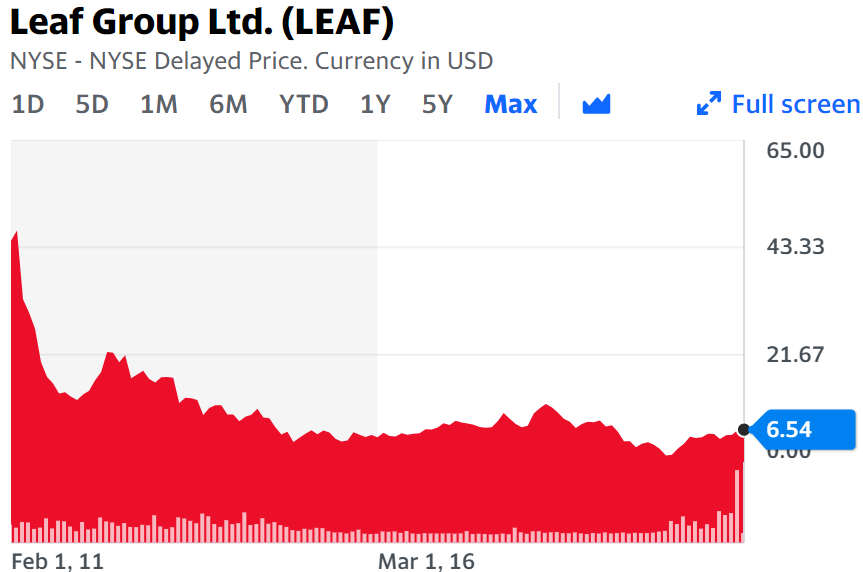
The one lasting counter-example to the above is Barry Diller’s IAC. His innovation ecosystem is surreal. Across time & across markets he is the best creator of vertical leading properties later spun off as their own companies. He’s owned Expedia, TripAdvisor, LendingTree, HomeAdvisor, Match.com, TicketMaster and so many other category leaders. His buying of Ask.com did not pan out as well as hoped as web browsers turned the address bar into a search box, his ability to differentiate the service went away after they shut down the engine in 2008, he was locked out of mobile search marketshare by default placement contracts & Google pushes back against extension bundling, but just about everything else he touched turned to gold. A lot of their current market cap is their ownership of Vimeo, which by itself is valued at $6 billion.
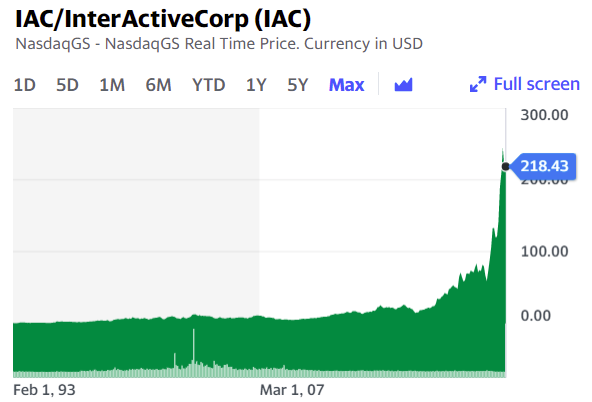
What is the most recent big bet for Barry Diller? MGM. Last August he bet $1 billion on the growth of online gambling. And he was willing to bet another billion to help them acquire Entain:
IAC has to date invested approximately US$1 billion in MGM with an initial investment thesis of accelerating MGM’s penetration of the $450 billion global gaming market. IAC notes in its letter of intent that IAC continues to strongly support this objective for MGM whether or not a transaction with Entain is consummated.
Barry Diller not accurately projects future trends, but he also has the ability to rehab broken companies past their due dates.
The New York Times bought About.com for $410 million in 2005 & did little with it as its relevance declined over time as its content got stale, Wikipedia grew and search engines kept putting more scraped content in the search results. The relentless growth of Wikipedia and Google launching “universal search” in 2007 diminished the value of About.com even as web usage was exploding.
IAC bought About.com from the New York Times for $300 million in August of 2012. They tried to grow it through improving usability, content depth and content quality but ultimately decided to blow it up.
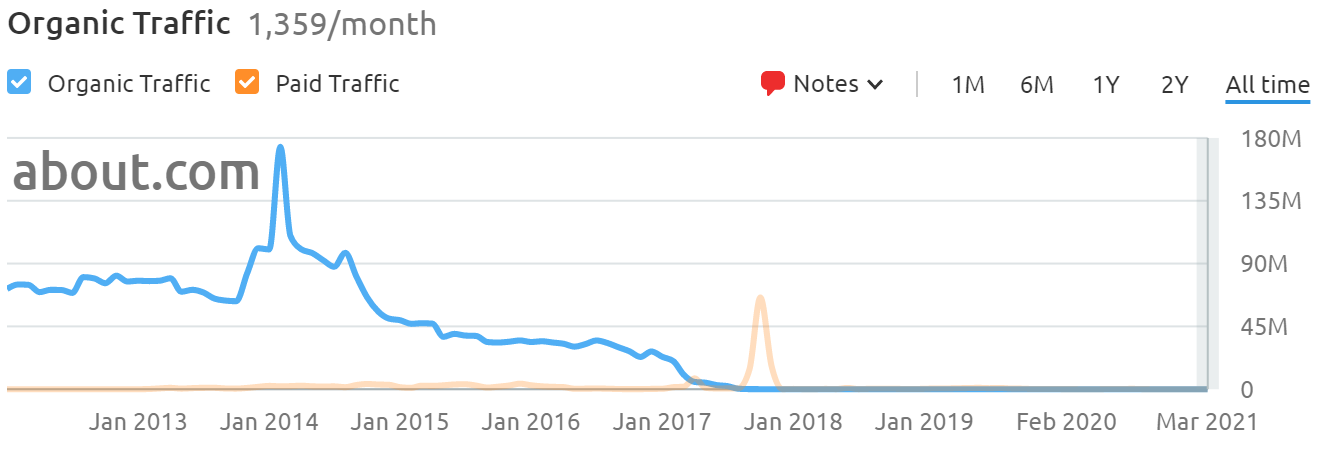
They were bold enough to break it into vertical category branded sites. They’ve done amazingly well with it and in many cases they rank 2, 3, 4 times in the SERPs with different properties like TheSpruce, TheBalance, Investopedia, etc. As newspapers chains keep consolidating or going under, IAC is one of the few constant “always wins” online publishers.
At its peak TheBalance was getting roughly 2/3 the traffic About.com generated.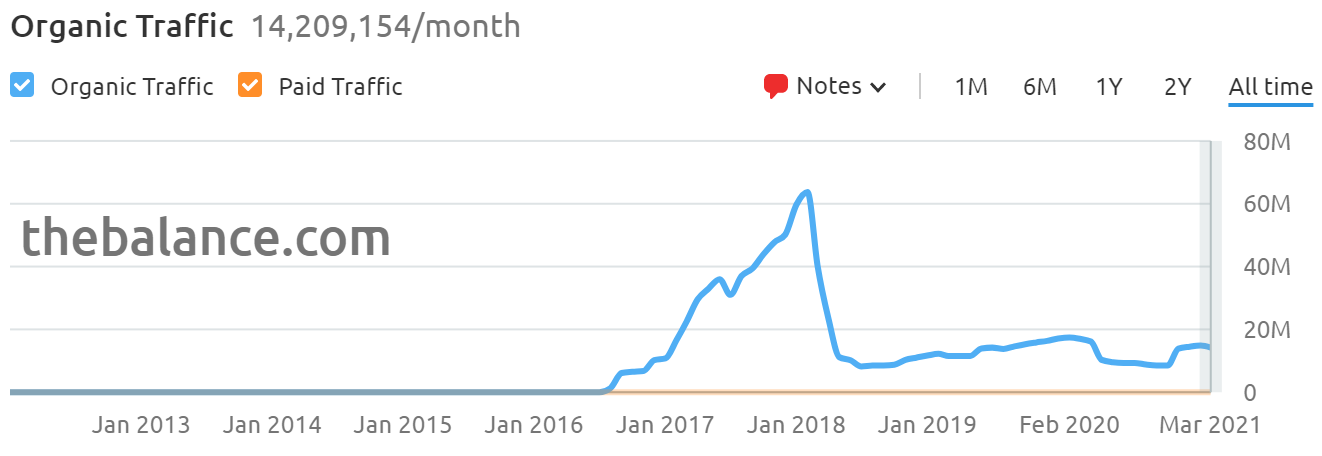
Part of the decline in the chart there was perhaps a Panda hit, but the reason traffic never fully recovered is they broke some of these category sites into niche sites using sub-brands.
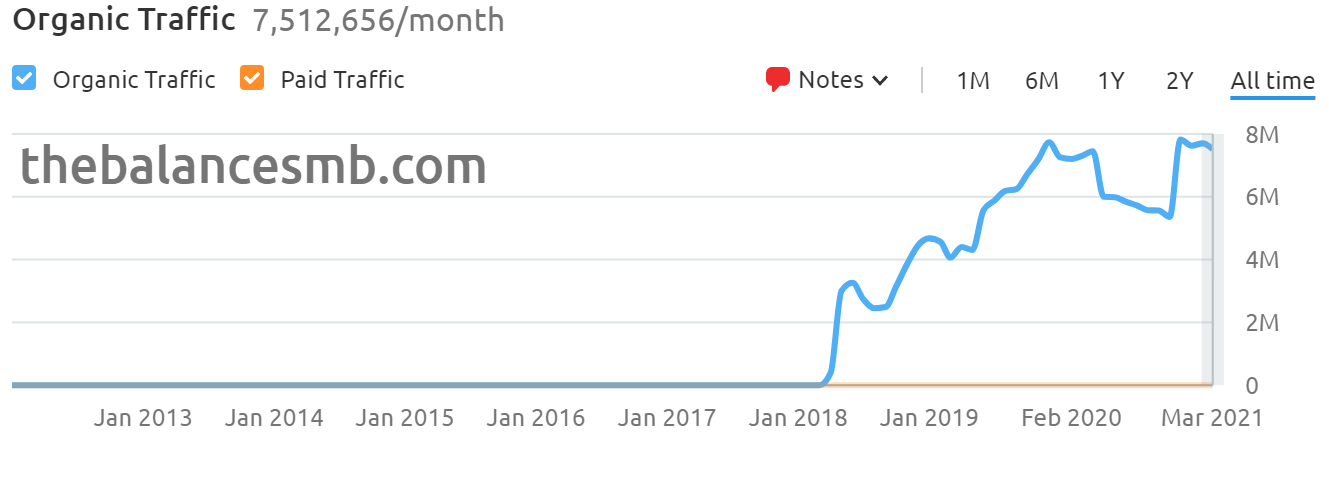
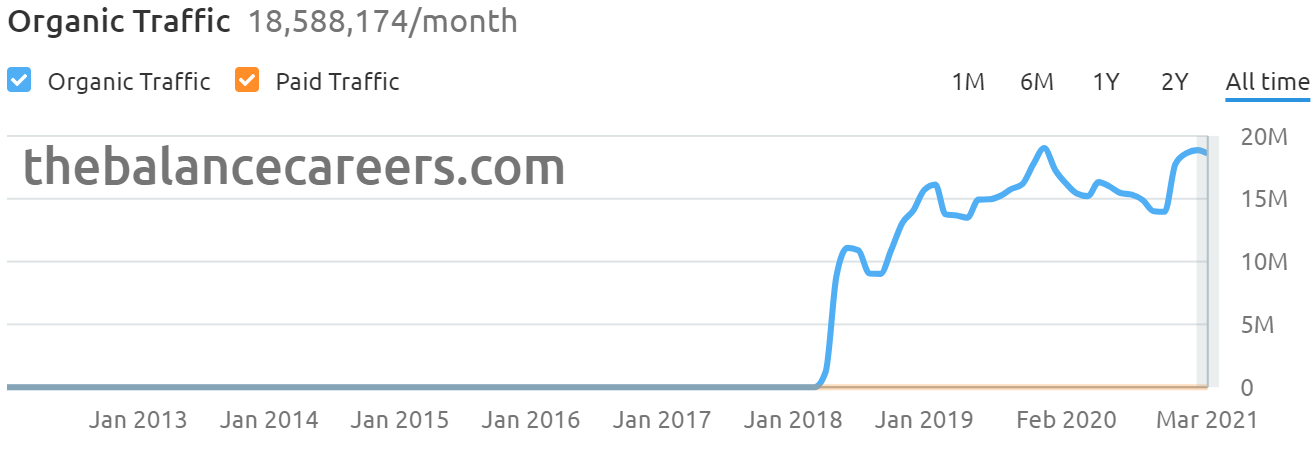
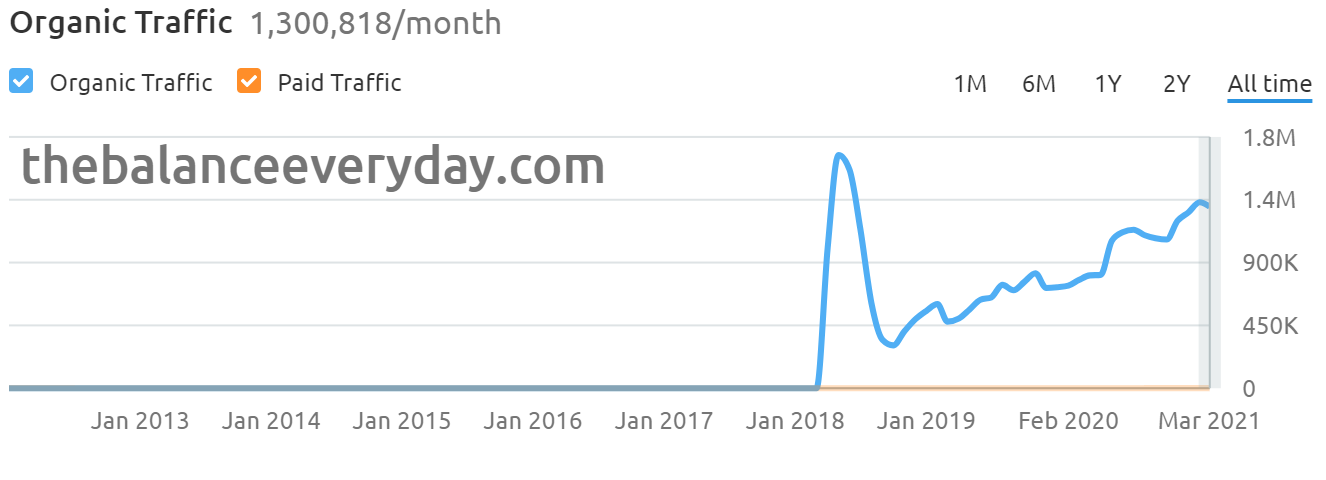
All the above search traffic estimate trend charts are from SEMrush. :)
I could do a blog post titled 1001 ways to use SEMrush if you would like me to, though I haven’t yet as I already have affiliate ads for them here and don’t want to come across as a shill by overpromoting a tool I love & use regularly.
I tend to sort of “not get” a lot of SaaS stocks in terms of prices and multiples, though they seem to go to infinity and beyond more often than not. I actually like SEMrush more than most though & think they’ll do well for years to come. I get the sense with both them and Ahrefs that they were started by programmers who learned marketing rather than started by marketers who cobbled together offerings which they though would sell. If you ever have feedback on ways to improve SEMrush they are fast at integrating it, or at least were in the past whenever I had feedback.
When SEMrush released their S-1 Dan Barker did a quick analysis on Twitter.
Some stats from the S-1: $144 million in annual recurring revenues @ 50% compound annual growth rate, 76% gross margins, nearly 1,000 employees and over 67,000 paying customers.
SEMrush, the SEO tool, has filed to go public. Here’s the S-1: https://t.co/i1meSHts4Y
They spent $54 million on marketing last year, for revenue of $125 million.
(gross profit $95m, net loss $7m) pic.twitter.com/iz5nybcwfA— dan barker (@danbarker) March 1, 2021
At some point a lot of tool suits tend to overlap because much of their data either comes from scraping Google or crawling the open web. If something is strong enough of a point of differentiation to where it is widely talked about or marketed then competitors will try to clone it. Thus spending a bit extra on marketing to ensure you have the brand awareness to be the first tool people try is wise. Years ago when I ran a membership site here I paid to license the ability to syndicate some SEMrush data for our members & I have promoted them as an affiliate for what seems like a decade now.
When Dan Baker did his analysis of the S-1 it made me think SEMrush likely has brighter prospects than many would consider. A few of the reasons I could think of off the top of my head:
- each day their archive of historical data is larger, especially when you consider they crawl many foreign markets which some other competitive research tools ignore
- increasing ad prices promote SEO by making it relatively cheaper
- keyword not provided on organic search means third party competitive analysis tools are valuable not only for measuring competitors but also measuring your own site
- Google Ads has recently started broadening ad targeting further and hiding some keyword data so advertisers are paying for clicks where they are not even aware what the keyword was
That last point speaks to Google’s dominance over the search ecosystem. But it is also so absurd that even people who ran AdWords training workshops point out the absurdity.
Yesterday’s announcement on match type changes had me crawling through query data this morning. I’m staring at many 2-3 word exact match keywords that are matching to 8-word queries. G thinks ‘deck paint’ and ‘how do i put paint on my deck’ mean the exact same thing. CPA is 10x.— Brad Geddes (@bgtheory) February 5, 2021
In Google maximizing their income some nuance is lost for the advertiser who must dig into N-Gram analysis or look at historical data to find patterns to adjust:
The account overall has a CPA in the $450 range. If the word ‘how’ is in the query, our CPA is over double. If someone searches for ‘quote,’ our CPA is under $300. If they ask a question about cost, the CPA is over $1000. Obviously, looking for quotes versus cost data is very different in the eyes of a user, but not in the matching search terms of Google.
Every ad network has incentive to overstate its contribution to awareness and conversions so that more ad budget is allocated to them.
- Facebook kept having to restate their ad stats around video impressions, user reach, etc.
- Facebook gave themselves a 28 day window for credit for some app installs.
- Google AMP accidentally double counted unique users on Google Analytics (drives adoption = good).
- Google Analytics came with last click attribution, which over-credits the search channel you use near the end of a conversion journey.
There are a lot of Google water carriers who suggest any and all of their actions are at worst benevolent, but when I hear about hiding keyword data I am reminded of the following quote from the Texas AG Google lawsuit.
“Google employees agreed that, in the future, they should not directly lie to publishers, but instead find ways to convince publishers to act against their interest and remove header bidding on their own.”
That lawsuit details the great lengths Google went to in order to leverage their search monopoly to keep monopoly profit margins on their display ad serving business.
AMP was created with the explicit intent to kill header bidding as header bidding shifted power and profit margins to publishers. Some publishers saw a 50% rise in ad revenues from header bidding.
Remember how Google made companywide bonuses depend on the performance of the Google Facebook clone named Google+? Google later literally partnered with Facebook on a secret ad deal to prevent Facebook from launching a header bidding solution. The partnership agreement with Facebook explicitly mentioned antitrust repeatedly.
Bid-rigging?! Is this bid-rigging? As in, one of the “supreme evils of antitrust”? As in, the thing that if RE investors do it at foreclosure auctions they go to prison? pic.twitter.com/w7ez6gwfZd— John Newman (@johnmarknewman) December 16, 2020
When a company partners with its biggest direct competitor on a bid rigging scheme you can count on it that the intent is to screw others.
So when you see Google talk about benevolence, remember that they promise to no longer lie in the future & only deceive others into working against themselves via other coercive measures.
We went from the observation that you can’t copyright facts to promoting opinion instead:
The Internet commoditized the distribution of facts. The “news” media responded by pivoting wholesale into opinions and entertainment.— Naval (@naval) May 26, 2016
to where after many thousands of journalists have been laid off now the “newspaper of record” is promoting ponzi scheme garbage as a performance art piece:
The NYT made a NFT!
My new column is about NFTs, and I also turned the column into a NFT and put it up for auction on @withFND, with proceeds going to charity.
Bid away, and you could own the first NFT in the paper’s 170-year history. https://t.co/9ItGZvID8B— Kevin Roose (@kevinroose) March 24, 2021
The decline of About.com was literally going to be terminal without the work of Barry Diller to revive it. That slide reflected how over time a greater share of searches never actually leave Google:
Of those 5.1T searches, 33.59% resulted in clicks on organic search results. 1.59% resulted in clicks on paid search results. The remaining 64.82% completed a search without a direct, follow-up click to another web property. Searches resulting in a click are much higher on desktop devices (50.75% organic CTR, 2.78% paid CTR). Zero-click searches are much higher on mobile devices (77.22%)
The data from the above study came from SimilarWeb, which is another online marketing competitive research tool planning on going public soon.
Google “debunked” Rand’s take by focusing on absolute numbers instead of relative numbers. But if you keep buying default placements in a monopoly ecosystem where everyday more people have access to a computer in their pocket you would expect your marketshare and absolute numbers to increase even if the section of pie other publishers becomes a smaller slice of a bigger pie.
Google’s take there is disingenuous at the core. It reminds me of the time when they put out a study claiming brand bidding was beneficial and that it was too complex and expensive for advertisers to set up a scientific study, without any mention of the fact the reason that would be complex and expensive is because Google chooses not to provide those features in their ad offering. That parallels the way they now decide to hide keyword data even from paying advertisers in much the same way they hide ad fees and lie to publishers to protect their ad income.
Google suggests they don’t make money from news searches, but if they control most of the display ads technology stack & used search to ram AMP down publishers throats as a technological forced sunk cost while screwing third party ad networks and news publishers, Google can both be technically true in their statement and lying in spirit.
“Google employees agreed that, in the future, they should not directly lie to publishers, but instead find ways to convince publishers to act against their interest and remove header bidding on their own.”
There are many more treats in store for publishers.
Google will stop supporting third party cookies in Chrome next year. They are also going to stop selling ads where targeting is based on tracking user data across websites:
“Google plans to stop selling ads based on individuals’ browsing across multiple websites, a change that could hasten upheaval in the digital advertising industry. The Alphabet Inc. company said Wednesday that it plans next year to stop using or investing in tracking technologies that uniquely identify web users as they move from site to site across the internet. … Google had already announced last year that it would remove the most widely used such tracking technology, called third-party cookies, in 2022. But now the company is saying it won’t build alternative tracking technologies, or use those being developed by other entities, to replace third-party cookies for its own ad-buying tools. … Google says its announcement on Wednesday doesn’t cover its ad tools and unique identifiers for mobile apps, just for websites.”
Google stated they would make no replacement for the equivalent of the third party cookie tracking of individual users:
“we continue to get questions about whether Google will join others in the ad tech industry who plan to replace third-party cookies with alternative user-level identifiers. Today, we’re making explicit that once third-party cookies are phased out, we will not build alternate identifiers to track individuals as they browse across the web, nor will we use them in our products. We realize this means other providers may offer a level of user identity for ad tracking across the web that we will not — like PII graphs based on people’s email addresses. We don’t believe these solutions will meet rising consumer expectations for privacy, nor will they stand up to rapidly evolving regulatory restrictions, and therefore aren’t a sustainable long term investment.”
On the above announcement, other ad networks tanked, with TheTradeDesk falling 20% in two days.
These are all Google’s competitors in advertising technology, collapsing after Google announced that it won’t let them do targeted advertising anymore, but that Google itself will continue to do it. https://t.co/S6Axcrw5a0— Matt Stoller (@matthewstoller) March 5, 2021
Competing ad networks wonder if Google will play by their own rules:
“One clarification I’d like to hear from them is whether or not it means there’ll be no login for DBM [a historic name for Google’s DSP], no login for YouTube and no login for Google properties. I’m looking for them to play by the same rules that they so generously foisted upon the rest of the industry,” Magnite CTO Tom Kershaw said.
Regulators are looking into antitrust implications:
“Google’s plan to block a popular web tracking tool called “cookies” is a source of concern for U.S. Justice Department investigators who have been asking advertising industry executives whether the move by the search giant will hobble its smaller rivals, people familiar with the situation said.”
The web will continue to grow more complicated, but it isn’t going to get any more transparent anytime soon.
“Google employees agreed that, in the future, they should not directly lie to publishers, but instead find ways to convince publishers to act against their interest and remove header bidding on their own.”
As the Attention Merchants blur the ecosystem while shifting free clicks over to paid and charging higher ad rates on their owned and operated properties it increases the value of neutral third party measurement services.
The trend is not too hard to notice if you are remotely awake.
While I was writing this post Google announced the launch of a “best things” scraper website featuring their scraped re-representations of hot selling items.
If I could give you one key takeaway here, it would be this:
“Google employees agreed that, in the future, they should not directly lie to publishers, but instead find ways to convince publishers to act against their interest and remove header bidding on their own.”
SEMrush IPO (SEMR)
On Wednesday SEMrush priced their IPO at $14 a share & listed Thursday.
There have been many marketing and online advertising companies which are publicly traded, but few that were so focused specifically on SEO while having a sizeable market cap. According to this SeekingAlpha post at the IPO price SEMrush had a valuation of about $1.95 to $1.99 billion. For comparison sake, here are some other companies & valuations.
- Facebook acquired Instagram for $1 billion.
- Google acquired YouTube for $1.65 billion.
- Yelp trades at around a $2.9 billion market cap.
- Yahoo! was acquired by Verizon for $4.48 billion.
- Hubspot has a market cap of around $20.4 billion.
A couple years ago Gannett bought AdWords reseller WordStream. A few years before that they bought ReachLocal. The Hearst publishing empire also bought iCrossing long ago. Marin Software remains publicly traded, but they are only valued at about $20 million.
Newspapers reselling Google AdWords ads isn’t really SEO though. Beyond those sorts of deals, many of the publicly traded SEO stuff has been only tangentially relevant to SEO, or crap.
There are some quality category-leading publishers which use SEO as a means of distribution but are not necessarily an SEO service provider like TripAdvisor, BankRate, and WebMD. Over time many of these sorts of companies have been gobbled up by Red Ventures or various private equity firms. Zillow, Yelp and TripAdvisor are some of the few examples which still exist as independent companies.
So that puts most of the publicly traded SEO stuff in one of the following categories…
- small scale – does anyone other than Andy Beal & Mike Grehan still remember KeywordRanking / WebSourced / Think Interactive / MarketSmart Interactive?
- hope and nope – sites like Business.com were repeatedly acquired but never really gained lasting relevance.
- affiliate networks – which reliant on partners with SEO traffic like Quinstreet & Commission Junction. many affiliate networks were hit hard as the barrier to entry in SEO increased over the years. Quinstreet is doing well in some verticals but sold their education division to Education Dynamics for $20 million. CJ was part of the Publicis Groupe acquisition of Epsilon.
- pump and dump scams – Demand Media, owner of eHow, which later rebranded as Leaf Group & still trades at a small fraction of their IPO price.

[Editorial note: 8 days after writing this post LEAF announced a $304.3 million all cash buyout offer from Graham Holdings at 21% above current market prices and was trading at $8.63 a share. If you bought shares at $40 or $30 or $20 and hoped it would at some point come back – nope – the losses are crystalized on a take out. Graham Holdings formerly owned the Washington Post but sold it to Jeff Bezos 8 years ago for $250 million.]
The one lasting counter-example to the above is Barry Diller’s IAC. His innovation ecosystem is surreal. Across time & across markets he is the best creator of vertical leading properties later spun off as their own companies. He’s owned Expedia, TripAdvisor, LendingTree, HomeAdvisor, Match.com, TicketMaster and so many other category leaders. His buying of Ask.com did not pan out as well as hoped as web browsers turned the address bar into a search box, his ability to differentiate the service went away after they shut down the engine in 2008, he was locked out of mobile search marketshare by default placement contracts & Google pushes back against extension bundling, but just about everything else he touched turned to gold. A lot of their current market cap is their ownership of Vimeo, which by itself is valued at $6 billion.

What is the most recent big bet for Barry Diller? MGM. Last August he bet $1 billion on the growth of online gambling. And he was willing to bet another billion to help them acquire Entain:
IAC has to date invested approximately US$1 billion in MGM with an initial investment thesis of accelerating MGM’s penetration of the $450 billion global gaming market. IAC notes in its letter of intent that IAC continues to strongly support this objective for MGM whether or not a transaction with Entain is consummated.
Barry Diller not only accurately projects future trends, but he also has the ability to rehab broken companies past their due dates.
The New York Times bought About.com for $410 million in 2005 & did little with it as its relevance declined over time as its content got stale, Wikipedia grew and search engines kept putting more scraped content in the search results. The relentless growth of Wikipedia and Google launching “universal search” in 2007 diminished the value of About.com even as web usage was exploding.
IAC bought About.com from the New York Times for $300 million in August of 2012. They tried to grow it through improving usability, content depth and content quality but ultimately decided to blow it up.

They were bold enough to break it into vertical category branded sites. They’ve done amazingly well with it and in many cases they rank 2, 3, 4 times in the SERPs with different properties like TheSpruce, TheBalance, Investopedia, etc. As newspapers chains keep consolidating or going under, IAC is one of the few constant “always wins” online publishers.
At its peak TheBalance was getting roughly 2/3 the traffic About.com generated.
Part of the decline in the chart there was perhaps a Panda hit, but the reason traffic never fully recovered is they broke some of these category sites into niche sites using sub-brands.



All the above search traffic estimate trend charts are from SEMrush. :)
I could do a blog post titled 1001 ways to use SEMrush if you would like me to, though I haven’t yet as I already have affiliate ads for them here and don’t want to come across as a shill by overpromoting a tool I love & use regularly.
I tend to sort of “not get” a lot of SaaS stocks in terms of prices and multiples, though they seem to go to infinity and beyond more often than not. I actually like SEMrush more than most though & think they’ll do well for years to come. I get the sense with both them and Ahrefs that they were started by programmers who learned marketing rather than started by marketers who cobbled together offerings which they though would sell. If you ever have feedback on ways to improve SEMrush they are fast at integrating it, or at least were in the past whenever I had feedback.
When SEMrush released their S-1 Dan Barker did a quick analysis on Twitter.
Some stats from the S-1: $144 million in annual recurring revenues @ 50% compound annual growth rate, 76% gross margins, nearly 1,000 employees and over 67,000 paying customers.
SEMrush, the SEO tool, has filed to go public. Here’s the S-1: https://t.co/i1meSHts4Y
They spent $54 million on marketing last year, for revenue of $125 million.
(gross profit $95m, net loss $7m) pic.twitter.com/iz5nybcwfA— dan barker (@danbarker) March 1, 2021
At some point a lot of tool suits tend to overlap because much of their data either comes from scraping Google or crawling the open web. If something is strong enough of a point of differentiation to where it is widely talked about or marketed then competitors will try to clone it. Thus spending a bit extra on marketing to ensure you have the brand awareness to be the first tool people try is wise. Years ago when I ran a membership site here I paid to license the ability to syndicate some SEMrush data for our members & I have promoted them as an affiliate for what seems like a decade now.
When Dan Barker did his analysis of the S-1 it made me think SEMrush likely has brighter prospects than many would consider. A few of the reasons I could think of off the top of my head:
- each day their archive of historical data is larger, especially when you consider they crawl many foreign markets which some other competitive research tools ignore
- increasing ad prices promote SEO by making it relatively cheaper
- keyword not provided on organic search means third party competitive analysis tools are valuable not only for measuring competitors but also measuring your own site
- Google Ads has recently started broadening ad targeting further and hiding some keyword data so advertisers are paying for clicks where they are not even aware what the keyword was
That last point speaks to Google’s dominance over the search ecosystem. But it is also so absurd that even people who ran AdWords training workshops point out the absurdity.
Yesterday’s announcement on match type changes had me crawling through query data this morning. I’m staring at many 2-3 word exact match keywords that are matching to 8-word queries. G thinks ‘deck paint’ and ‘how do i put paint on my deck’ mean the exact same thing. CPA is 10x.— Brad Geddes (@bgtheory) February 5, 2021
In Google maximizing their income some nuance is lost for the advertiser who must dig into N-Gram analysis or look at historical data to find patterns to adjust:
The account overall has a CPA in the $450 range. If the word ‘how’ is in the query, our CPA is over double. If someone searches for ‘quote,’ our CPA is under $300. If they ask a question about cost, the CPA is over $1000. Obviously, looking for quotes versus cost data is very different in the eyes of a user, but not in the matching search terms of Google.
Every ad network has incentive to overstate its contribution to awareness and conversions so that more ad budget is allocated to them.
- Facebook kept having to restate their ad stats around video impressions, user reach, etc.
- Facebook gave themselves a 28 day window for credit for some app installs.
- Google AMP accidentally double counted unique users on Google Analytics (drives adoption = good).
- Google Analytics came with last click attribution, which over-credits the search channel you use near the end of a conversion journey.
There are a lot of Google water carriers who suggest any and all of their actions are at worst benevolent, but when I hear about hiding keyword data I am reminded of the following quote from the Texas AG Google lawsuit.
“Google employees agreed that, in the future, they should not directly lie to publishers, but instead find ways to convince publishers to act against their interest and remove header bidding on their own.”
That lawsuit details the great lengths Google went to in order to leverage their search monopoly to keep monopoly profit margins on their display ad serving business.
AMP was created with the explicit intent to kill header bidding as header bidding shifted power and profit margins to publishers. Some publishers saw a 50% rise in ad revenues from header bidding.
Remember how Google made companywide bonuses depend on the performance of the Google Facebook clone named Google+? Google later literally partnered with Facebook on a secret ad deal to prevent Facebook from launching a header bidding solution. The partnership agreement with Facebook explicitly mentioned antitrust repeatedly.
Bid-rigging?! Is this bid-rigging? As in, one of the “supreme evils of antitrust”? As in, the thing that if RE investors do it at foreclosure auctions they go to prison? pic.twitter.com/w7ez6gwfZd— John Newman (@johnmarknewman) December 16, 2020
When a company partners with its biggest direct competitor on a bid rigging scheme you can count on it that the intent is to screw others.
So when you see Google talk about benevolence, remember that they promise to no longer lie in the future & only deceive others into working against themselves via other coercive measures.
We went from the observation that you can’t copyright facts to promoting opinion instead:
The Internet commoditized the distribution of facts. The “news” media responded by pivoting wholesale into opinions and entertainment.— Naval (@naval) May 26, 2016
to where after many thousands of journalists have been laid off now the “newspaper of record” is promoting ponzi scheme garbage as a performance art piece:
The NYT made a NFT!
My new column is about NFTs, and I also turned the column into a NFT and put it up for auction on @withFND, with proceeds going to charity.
Bid away, and you could own the first NFT in the paper’s 170-year history. https://t.co/9ItGZvID8B— Kevin Roose (@kevinroose) March 24, 2021
Is it any wonder people have lost trust in institutions?
A one-hour @CBCNews special that examines the media’s role in the polarization of America and the unmaking of a citizen — Big News is now streaming. pic.twitter.com/tm5QB2P4Ro— CBC Gem (@cbcgem) March 26, 2021
The decline of About.com was literally going to be terminal without the work of Barry Diller to revive it. That slide reflected how over time a greater share of searches never actually leave Google:
Of those 5.1T searches, 33.59% resulted in clicks on organic search results. 1.59% resulted in clicks on paid search results. The remaining 64.82% completed a search without a direct, follow-up click to another web property. Searches resulting in a click are much higher on desktop devices (50.75% organic CTR, 2.78% paid CTR). Zero-click searches are much higher on mobile devices (77.22%)
The data from the above study came from SimilarWeb, which is another online marketing competitive research tool planning on going public soon.
Google “debunked” Rand’s take by focusing on absolute numbers instead of relative numbers. But if you keep buying default placements in a monopoly ecosystem where everyday more people have access to a computer in their pocket you would expect your marketshare and absolute numbers to increase even if the section of pie other publishers becomes a smaller slice of a bigger pie.
Google’s take there is disingenuous at the core. It reminds me of the time when they put out a study claiming brand bidding was beneficial and that it was too complex and expensive for advertisers to set up a scientific study, without any mention of the fact the reason that would be complex and expensive is because Google chooses not to provide those features in their ad offering. That parallels the way they now decide to hide keyword data even from paying advertisers in much the same way they hide ad fees and lie to publishers to protect their ad income.
Google suggests they don’t make money from news searches, but if they control most of the display ads technology stack & used search to ram AMP down publishers throats as a technological forced sunk cost while screwing third party ad networks and news publishers, Google can both be technically true in their statement and lying in spirit.
“Google employees agreed that, in the future, they should not directly lie to publishers, but instead find ways to convince publishers to act against their interest and remove header bidding on their own.”
There are many more treats in store for publishers.
Google Chrome stopped sending full referrals for most web site visitors late last year. Google will stop supporting third party cookies in Chrome next year. They’ve even floated the idea of hiding user IP addresses from websites (good luck to those who need to prevent fraud!).
Google claims they also going to stop selling ads where targeting is based on tracking user data across websites:
“Google plans to stop selling ads based on individuals’ browsing across multiple websites, a change that could hasten upheaval in the digital advertising industry. The Alphabet Inc. company said Wednesday that it plans next year to stop using or investing in tracking technologies that uniquely identify web users as they move from site to site across the internet. … Google had already announced last year that it would remove the most widely used such tracking technology, called third-party cookies, in 2022. But now the company is saying it won’t build alternative tracking technologies, or use those being developed by other entities, to replace third-party cookies for its own ad-buying tools. … Google says its announcement on Wednesday doesn’t cover its ad tools and unique identifiers for mobile apps, just for websites.”
Google stated they would make no replacement for the equivalent of the third party cookie tracking of individual users:
“we continue to get questions about whether Google will join others in the ad tech industry who plan to replace third-party cookies with alternative user-level identifiers. Today, we’re making explicit that once third-party cookies are phased out, we will not build alternate identifiers to track individuals as they browse across the web, nor will we use them in our products. We realize this means other providers may offer a level of user identity for ad tracking across the web that we will not — like PII graphs based on people’s email addresses. We don’t believe these solutions will meet rising consumer expectations for privacy, nor will they stand up to rapidly evolving regulatory restrictions, and therefore aren’t a sustainable long term investment.”
On the above announcement, other ad networks tanked, with TheTradeDesk falling 20% in two days.
These are all Google’s competitors in advertising technology, collapsing after Google announced that it won’t let them do targeted advertising anymore, but that Google itself will continue to do it. https://t.co/S6Axcrw5a0— Matt Stoller (@matthewstoller) March 5, 2021
Competing ad networks wonder if Google will play by their own rules:
“One clarification I’d like to hear from them is whether or not it means there’ll be no login for DBM [a historic name for Google’s DSP], no login for YouTube and no login for Google properties. I’m looking for them to play by the same rules that they so generously foisted upon the rest of the industry,” Magnite CTO Tom Kershaw said.
Regulators are looking into antitrust implications:
“Google’s plan to block a popular web tracking tool called “cookies” is a source of concern for U.S. Justice Department investigators who have been asking advertising industry executives whether the move by the search giant will hobble its smaller rivals, people familiar with the situation said.”
The web will continue to grow more complicated, but it isn’t going to get any more transparent anytime soon.
“Google employees agreed that, in the future, they should not directly lie to publishers, but instead find ways to convince publishers to act against their interest and remove header bidding on their own.”
As the Attention Merchants blur the ecosystem while shifting free clicks over to paid and charging higher ad rates on their owned and operated properties it increases the value of neutral third party measurement services.
The trend is not too hard to notice if you are remotely awake.
While I was writing this post Google announced the launch of a “best things” scraper website featuring their scraped re-representations of hot selling items. And they are cross-promoting competitors in “knowledge” panels to dilute brand values & force the brand ad buy.
Oh man. Check out this bullshit on our GMB Knowledge Panel. Are they going to list competitors on everyone’s listings now? pic.twitter.com/ITwiZGyRxs— Darren Shaw (@DarrenShaw_) March 26, 2021
Shortly after Google launched their thin affiliate scraper site full of product ads they announced an update to demote other product review sites.
Where Google can get away with it, they will rig things in their favor to rip off other players in the ecosystem:
Google for years operated a secret program that used data from past bids in the company’s digital advertising exchange to allegedly give its own ad-buying system an advantage over competitors, according to court documents filed in a Texas antitrust lawsuit. The program, known as “Project Bernanke,” wasn’t disclosed to publishers who sold ads through Google’s ad-buying systems.
If I could give you one key takeaway here, it would be this:
“Google employees agreed that, in the future, they should not directly lie to publishers, but instead find ways to convince publishers to act against their interest and remove header bidding on their own.”
The Wrong People Won
My initial attraction toward SEO and the web was largely that it was like a new and parallel world that bypassed many traditional gatekeepers.
I wrote an ebook which originally had inconsistent formatting and it was riddled with spelling and grammar errors. I learned to write by writing poorly and often while reading great writers daily.
Ultimately it did not matter that my efforts were subpar on some fronts as few people read early copies, and I was receptive to feedback on how to improve it and rapidly did.
The above process … growing while few people see your ugly work … is actually one of the advantages of *NOT* taking venture capital. You get to learn at your own pace while risks are low and only really lean into something when you know it is working. You keep making small bets that won’t kill you and then when something works better than you expect you can *REALLY* lean into it.
I ultimately did that with SEO, blogging, and a couple other areas I can’t mention too much as I had partners on some projects.
This blog never even started as its own site. It was a section on a different site that was spun out to become its own site when it was obvious blogs were being algorithmically over-promoted due to the cross linking from other bloggers and the instant exposure RSS feeds offered.
Instead of begging a book publisher to publish a book I had a higher margin product and the book publishers were begging me. The market was inverted and an outcast won by bypassing traditional gatekeepers.
When SEO was easy it was the same sort of deal. As long as you tried to learn about what the algorithms valued & put effort behind it you could rank for almost anything.
Early on that meant begging, buying, or borrowing links any way you could. If a project was throwing off big money you’d try public relations and to get high quality links to help reinforce the position and increase its longevity. But even junky links worked fantastic back in the day. That’s part of why there was so much blog comment spam, referrer spam, expired domains, cheeseball web directories which actually had pagerank in the URL, article directories, private blog networks, all sorts of other paid links like Text-Link-Ads.com, etc. etc. etc.
New channels provide new opportunities. Small players prove the model, drive adoption, and then over time the affiliate or independent publisher is replaced by some big publisher or a scrape-n-displace offering from the central market operators.
If you take a broad enough view of the world the above sort of water cycle repeatedly happens across all media formats and channels.
- New channels emerge
- Smaller players and hobbyists are attracted to the new and shiny object
- Limited competition & regulation
- Channel grows wildly
- Channel locked down by regulation or a monopoly
When the channels are new they have the greatest chance of failure, but the biggest potential rewards for early adopters.
As channels are established and competition increases almost all the profit margins get handed over to the central market operator. Everything gets adjust on an “as needed” basis. Anything that hands too much of the profits over to a third party publisher gets cloned by the central network operator, becomes against the terms of service, or is algorithmically or manually neutralized by the central market operators.
- affiliates used to be able to sit at the end of the conversion funnel and extract profits from the most valuable keywords, but new algorithmic signals make it hard to stay competitive with limited value add, differentiation, or brand building
- commercial keywords are all ads in the search results above the fold & many brands feel the need to bid on their pre-existing brand equity for defensive purposes
- Google hid keyword data from organic search & later started to hide some from paid search campaigns as well.
- the Chrome browser by default only allows extensions to be downloaded from their official store & while Google got a lot of Chrome distribution through negative option bundling on Flash security updates, they prohibit app bundling in their app store
- Apple’s iOS and Google Android allow the central network operators to track third party app usage. The Apple Appstore and Google Play have mandatory 30% rakes and may disallow certain widely used apps after those features have been baked into the operating system or cloned and default bundled on new phones.
- YouTube takes a 45% revenue share rake & the ad inventory is sold exclusively through Google tools where Google takes up to another 20% rake off the top
- Amazon uses your sales data and product design to create what amounts to an effective clone job of it (going so far as to say there are fake safety issues to demand to see where it was manufactured) and then you are forced to bid on your own brand as Amazon gives itself free ads on your brand for their product clone job
- Google and Facebook try to suck content into their networks via Instant Articles and AMP. Google gives AMP priority placement in their search results (just like they did previously with Google+, Google Checkout, Google Base / Google Shopping / YouTube / etc etc etc).
- Rather than competing, Google and Facebook partnered to illegally bid rig auctions to destroy header bidding & preserve monopoly profit margins, keeping control over external publishers. Google also pushes “privacy” obfuscation which harms third party publishers and third party ad networks while bypassing those firewalls for its own ad network. They are also looking to use their web browser to do away with cookies, further kneecapping other ad networks.
- Early Pinterest Ads sent users offsite and often cost only a couple cents a visit while all the internal cross promotion & viral spread across Pinterest was effectively free. Then over time advertisers start getting charged for pins even being opened and getting a user to actually leave Pinterest and click through can cost $5 or $10 a click. Long after I saw Reddit threads about how I was a washed up hack who could not compete in the modern market I literally used Pinterest to seed the growth of a site which now gets about a million organic search visits a month. I recently tried further promoting that site on Pinterest in some new areas, but the economics no longer works for that particular site on that channel.
If you play by the rules suggested by private market participants you are betting that they won’t dramatically change their ecosystem at the drop of a hat and they won’t compete against you.
And that bet is a REALLY bad bet.
Networks do not stay on top & in control by stagnating. They change with society & if they are influential enough they also change the structure of society.
The Texas AG lawsuit of Google for manipulating the online display ad market lays bare how power works:
Google employees agreed that, in the future, they should not directly lie to publishers, but instead find ways to convince publishers to act against their interest and remove header bidding on their own.
I could easily write a 100 page blog post on that lawsuit while feeling guilty for leaving many things out.
For example, did you know Google stole AdSense earnings from publishers in the AdTrader ad network and lied about refunding that money to advertisers as AdTrader also managed some of the advertiser accounts which got a $0.00 rebate:
We confirmed through multiple sources, both within and outside of Google, through our Google invoices, and data collected from Google APIs that Google never actually refunded any of the confiscated publisher earnings to the advertisers. In fact, Google’s own support team admitted that they never had a system in place for such refunds.
Google is the network I have studied most and know the most about, though others certainly know Facebook equally well. All the large networks growth the predacious exploits.
Even with limited Facebook usage I know they have at various points in time promoted: games, hype headline fake news, lists and viral quiz junk from Buzzfeed, real actual news sites, the Instant Articles version of real actual news, live video, friend content, etc. Facebook also bought Onavo, a VPN network to track the growth of competing apps. That data was used to inform their WhatsApp purchase. And they could see which features from what external networks they should clone, like when Instagram copied much of SnapChat’s offering.
You can follow the Facebook terms of service in everything you do, but the odds of that delivering you real and sustainable profit streams is low.
“You can be unethical and still be legal that’s the way I live my life” – Mark Zuckerberg
Few publishers will be experts at both optimizing for the flaw or overpromotion in the current algorithm or network set up AND being good at reinventing themselves to appeal to the algorithms of tomorrow. You ultimately want to use some of any excess profits to build a destination people seek out so you are less dependent on the central network operators.
At the same time, if you ignore the algorithms and just hope for the best you are probably going to lose to a competitor who clones most of your strategy AND manipulates the result set.
You sort of have to figure out what is being over-promoted today AND then try to figure out what will matter tomorrow, while reinvesting profits to the point you are no longer really faking it until you make it.
Realizing that all success is temporary is vital to encourage yourself to take advantage of the opportunities in front of you, while also ensuring you have a plan B in place that acts as a bridge to tomorrow in case your primary channel bombs.
Almost all profit margins (particularly for newer players lacking access to connections, massive cashflows, strong legacy brands, etc.) come from operating somewhere in the gray area. Behave in a manner that is legal, but push the boundaries of terms from other players.
Google funded eHow. Demand Media was ultimately a pump and dump operation. Those who followed it late got their asses handed to them, but those who got in early had plenty of profits they could reinvest in other lower risk ventures. At one point Mahalo publicly listed their page-level earnings data. One of my buddies went through and put that keyword list through TextBroker and uploaded a few hundred articles to an old blog. After about a year that led to a free house for one of their family members. :D
Now Google has far more data to use so it is hard to be anywhere near as exploitative or lowbrow as an eHow or a Mahalo was and expect that stuff to back out.
When Matt Cutts was on TWIG in 2013 he stated:
If you want to stop spam, the most straight forward way to do it is to deny people money because they care about the money and that should be their end goal. But if you really want to stop spam, it is a little bit mean, but what you want to do, is break their spirits. There are parts of Google algorithms specifically designed to frustrate spammers. Some of the things we do is give people a hint their site will drop and then a week or two later, their site actually does drop. So they get a little bit more frustrated. So hopefully, and we’ve seen this happen, people step away from the dark side and say, you know what, that was so much pain and anguish and frustration, let’s just stay on the high road from now on.
…
Some of the stuff I like best is when people say “you know what, this SEO stuff is too unpredictable, I am just going to write some apps.”
This past year is the year when “writing some apps” was revealed to have the same core problems that SEO has. Central market operators grabbing their tithings (fight between Apple and entities like Spotify and Epic Games, Google Play pushing through similar 30% rake requirements) and then outright banning apps like Parler from their app stores.
The COVID-19 pandemic moved everyone and everything online.
The ad money follows the attention stream. If the central network operators pay creators nothing then those creators who have a following will find other ways to monetize. Cygnus was early to SEO and he was early to influencer marketing.
Selling a sliver of attention and then using that funds flow to improve website usability, website design, content quality, brand awareness, reach, etc. … is usually going to work out better for most people than trying to raise venture capital. Many small bets and incremental improvements yields much higher odds of success than a few really big bets.
Speaking of bets, I follow the stock market a bit because it teaches a lot about human psychology, markets and marketing.
Well before the COVID-19 crisis happened the repo market froze. In fact, the Federal Reserve was discussing alternative ways to fund the market’s liquidity without looking like they were directly subsidizing and bailing out hedge funds:
the new approach could also create political problems for policy makers, analysts said. The problem centers on the central bank lending directly to hedge funds, the little-regulated investment vehicles that tend to serve wealthy or institutional investors. … Though hedge funds are key participants in the market—where they both borrow and lend cash—lending to them directly through the FICC would raise questions about whether the government was backstopping their bets, analysts said.
When the COVID-19 crisis happened optics no longer mattered. Bailouts ensued. Without them levered hedge funds were screwed as many instruments became illiquid and spreads blew out even in bedrock stable markets:
Of particular concern: The hedge funds were using trading strategies similar to those employed by Long-Term Capital Management, a fund that collapsed in 1998 and nearly caused a financial meltdown. The bet that hedge funds were making earlier this year was simple enough. Called a basis trade, it involved exploiting a price difference in the Treasury market, generally by selling Treasury futures contracts — promises to deliver a bond or note at a set price on a set date — and buying the comparatively cheap underlying securities.
Toward the end of last year and early this year Bitcoin was a rocket ship on the thesis of mass money printing leading to currency debasement and revaluing finite alternatives to fiat cash upward.
And then regulators began dropping hints while banks started to put the breaks on it. And XRP got kicked hard by the SEC, leading to delisting.
Tether may be an absolute scam (it’s hard to short Patio11’s knowledge), but in spite of that there are a lot of retail traders bored at home chasing anything that moves. There are ETFs like GBTC sucking up a huge share of the Bitcoin float with no intent of ever liquidating any of the position.
If sports and society shut down and people are stuck in their homes gambling is an unsurprising source of entertainment. Barstool Sports founder David Portnoy got this and quickly became a day trader when he didn’t have any sports to talk about. :D
Above I mentioned a bit how the Federal Reserve was ultimately bailing out hedge funds. In an easy money market where central banks are printing tons of money what a lot of hedge funds do is buy higher beta growth names while shorting lower beta value stocks, particularly if they feel those companies are destined to go under.
In some cases the short bets believe ideas from a category apply to a specific company in a way they do not. And that can lead to a massive short squeeze, especially if the company announces a buyback and/or insiders buy.
In other cases, the shorts are so confident in their position, they go HOG WILD with low interest leverage and literally short the entire float of a company, trying to drive it into bankruptcy.
Recently Melvin Capital and some other well-connected hedge funds went short GameStop’s stock and a Subreddit named WallStreetBets took the other side of that position.
GME has a 52-week low of $2.57. After being pumped by the Subreddit the stock closed today at $347.51, leading to billions in losses for hedge funds which shorted over 100% of the stock.
According to @S3Partners, short sellers lost $14.3 billion on $GME stock today… just today.— Riley de León (@RileyCNBC) January 27, 2021
The hedge funds that shorted over 100% of a stock … were market manipulators aiming to manipulate a market.
When they win, that is capitalism.
When they lose, they get bailed out, contact regulators and have pressure applied to prevent THE WRONG PEOPLE from winning.
There are over 2.6 million Wall Street Bet users and only 10,000 hedge funds. The power of the proletariat is now!— Reddit Investors (@redditinvestors) January 27, 2021
The SEC published a statement on market volatility, the Biden administration mentioned it was watching GameStop, Nasdaq’s CEO suggested halting trading to allow hedge funds to steamroll Reddit users, the Discord group for WallStreetBets was shut down, and Reddit (at least temporarily) banned the WallStreetBets subreddit for hate speech.
That WallStreetBets was temporarily nuked will likely make the degenerate gamblers even more aggressive.
Emergency Press Conference – The Suits Shut Down @wallstreetbets @WSBChairman My prediction is tomorrow will be intergalactic for $amc $gme $nok
(Im not a financial adviser. Don’t listen to me) pic.twitter.com/oYrsPOz8Vx— Dave Portnoy (@stoolpresidente) January 28, 2021
You can see a lot of moves coming if you understand internet culture.
does one throw one, two, three, four, or five hundy at $TR on open? :)— uoɹɐɐ (@aaronwall) January 26, 2021
But in many ways we are now where the outcomes will be pre-determined in order to ensure THE RIGHT PEOPLE win.
Politicians will determine outcomes after the fact.
The more THE WRONG PEOPLE win, the more intervention there will be to correct the natural order.
Risk is much higher than most perceive because outcomes matter more than process & some multi-generational politically-connected wealth is losing badly to THE WRONG PEOPLE.
Gamestop:
Perhaps they got lucky.
Maybe just a flash in pan.
So dismiss them if u want.
But if read their messages u see its not just about money.
They’re discovering their voice.
& that they’re powerful.
IMO this is partly why wont be so easy for Fed to bailout Eurodollar Mkt…— Santiago Capital (@SantiagoAuFund) January 28, 2021
We are now at the point that the internet is no longer a spot for weirdo outcasts & instead it is reshaping the rest of society.
Part of a person as awful as Trump getting elected as president was micro-targeted South Park inspired videos sent to minorities reminding them of Hillary Clinton’s super predators speech.
And who could forget her laughing about having the head of Libya murdered, a former nation which fell apart to such an extreme degree they had open air slave auctions.
Another part of Trump getting elected was Obama promising “Hope and Change” but then standing between banks and pitchforks for the intentional and malicious fraud that led to the 2008 economic blowup.
As it turns out, a Citigroup insider had the Obama cabinet picked out before he was even elected.
Citigroup was the biggest TARP recipient.
Citicorp is the same company which illegally merged with Travelers, had that merger made legal after the fact by getting the Great Depression era Glass-Steagall Act regulation repealed:
”I think we will look back in 10 years’ time and say we should not have done this but we did because we forgot the lessons of the past, and that that which is true in the 1930’s is true in 2010,” said Senator Byron L. Dorgan, Democrat of North Dakota. ”I wasn’t around during the 1930’s or the debate over Glass-Steagall. But I was here in the early 1980’s when it was decided to allow the expansion of savings and loans. We have now decided in the name of modernization to forget the lessons of the past, of safety and of soundness.”
After the internet stock bubble popped the Federal Reserve lowered rates dramatically and left them there far too long, creating a massive hunt for yield. This led to a housing bubble and deteriorating loan standards with fog-a-mirror NINJA loans and similar dominating the market due to the insatiable demand for “risk free” yield. Entities like Citigroup created a ton of bogus mortgage paper they knew was garbage. Their entire board of advisors was repeatedly emailed by Richard M. Bowden about the fraud:
I started issuing warnings in June of 2006 and attempted to get management to address these critical risk issues. These warnings continued through 2007 and went to all levels of the Consumer Lending Group. We continued to purchase and sell to investors even larger volumes of mortgages through 2007. And defective mortgages increased during 2007 to over 80% of production.
If you control the government economic outcomes are determined by politics.
Citigroup was so confident in their control of the political outcomes they continued to dump bad loans on the FHA after Fannie Mae and Freddie Mac were forced into receivership.
THE RIGHT PEOPLE WON.
Any government which intentionally subsidizes and promotes massive fraud ultimately undermines their own legitimacy.
Obama was so rotten he made Trump look like a reasonable choice.
Who were the people hurt worst by Citigroup’s fraud?
So it should come as no surprise the Citigroup recently published “research” on how racism is holding back the U.S. economy.
If Obama the president matched Obama the candidate the Citigroup board would have been imprisoned, that bank would have been dismantled, and the above “research” would not have been published.
“I was in my early teens during the ’08 crisis. I vividly remember the enormous repercussions that the reckless actions by those on Wall Street had in my personal life, and the lives of those close to me. I was fortunate – my parents were prudent and a little paranoid, and they had some food storage saved up. When that crisis hit our family, we were able to keep our little house, but we lived off of pancake mix, and powdered milk, and beans and rice for a year. Ever since then, my parents have kept a food storage, and they keep it updated and fresh. Those close to me, my friends and extended family, were not nearly as fortunate.” – ssauronn
The reasons I liked Trump were:
- he was hated by the media, so they’d cover wrongdoings (even making some up)
- until the COVID-19 crisis hit, he was broadening the economy
- his administration pushed through an antitrust lawsuit against Google for their monopolistic bundling practices
The above being said, the January 6th siege was absolutely idiotic, and looked like it was something out of South Park.
Google’s Eric Schmidt played a vital role in the Obama elections & administration. Their relationship was so close it was called “The Android Administration.”
When the FTC investigated Google the Obama administration intervened to prevent justice. And now Schmidt’s shadowy “use AI everywhere in weaponry” startup is deeply embedded in the Biden administration.
We are back to an administration loved by the media. The controversy are hence reduced to casual magazine cover shoots.
Mainstream media: please serve your vital roll in society. Cover that casual photoshoot and not the Darth Vader aspects of Eric Schmidt.
Biden pushed against the “racist” attribution of the COVID-19 crisis to its source in China, though few have considered how “free trade” with a country with over a million slaves would impact living standards as it deindustrializes the country and destroys the middle class.
If a country has a live organ harvesting program for its own citizens, do we want to have close ties to it?
If a state-controlled economy dumps fentanyl into your country they deserve nothing but ire and disrespect, at least until that problem goes away.
While we are seeking out a just global society, does LeBron James say “technically the Chinese Uighur slaves who make my shoes are not black, so it is all good? #BLM”
Free capital flows plus structural trade deficits from “free trade” with slave states = declining domestic living standards.
If you have an average to below average IQ, did not come from wealth, have high living costs, and you must compete against literal slaves your life is probably going to suck.
Declining living standards can be masked temporarily through manipulating economic data, but fake data can’t restore hopes and dreams and aspiration for something better.
When I was inside the Fed, it was acknowledged internally that the core PCE was a broken metric that understated & misrepresented true inflation. The decision was made to continue using the broken gauge because Fed models would not work if true inflation was used.
QE is a lie. https://t.co/E3LlQhTPyv— Danielle DiMartino Booth (@DiMartinoBooth) January 4, 2021
That loss of hope will fuel deaths of despair, desperation, and a desire to believe in just about anything.
The race baiting “equality of outcomes” promoters only throw further fuel on the fire by telling people they are victims and pointing their ire in the wrong direction.
Burning down the local nail salon in a riot is not going to change the Federal Reserve bailing out hedge funds who are manipulating the stock market.
Instead of acting like an enraged victim, read Kurt Vonnegut’s Harrison Bergeron and then consider what skills you can lean into to make a positive change in the world.
The process and outcome of that “free trade” & papering it over with increasing debt leverage was well known in advance.
Look no further than this 1994 Charlie Rose video interview of Sir James Goldsmith.
Ultra-wealthy plutocrats were willing to partner with the CCP and sacrifice the US middle class in order to gain more wealth and political power.
THE RIGHT PEOPLE won.
For some people the web was a life raft, but a lot of the easy wins have already been had.
And the central network operators are getting more aggressive with scratch-your-back censorship for those in political power.
As more and more services happen online, more and more of business profit margins are flowing online, and the online networks are having a massive impact on the portions of the economy which remain offline.
The central network operators can choose to ban an outgoing president while ignoring politicians who call for genocide in other markets to curry favor to political leaders. As Zuck would say …
“You can be unethical and still be legal that’s the way I live my life”
Tim Berners-Lee will likely end up saving the web he created by promoting decentralization.
If that doesn’t work, we are stuck with Zuck and Eric Schmidt restructuring society as they see fit.